
- Case Studies
- Free Coaching Session

Production Plan in Business Plan: A Comprehensive Guide to Success
Last Updated:
June 6, 2024

In any business venture, a solid production plan is crucial for success. A production plan serves as a roadmap that outlines the steps, resources, and strategies required to manufacture products or deliver services efficiently. By carefully crafting a production plan within a business plan, entrepreneurs can ensure optimal utilisation of resources, timely delivery, cost efficiency, and customer satisfaction. In this article, we will delve into the intricacies of creating an effective production plan in a business plan , exploring its key components, strategies, and the importance of aligning it with overall business objectives .
Key Takeaways on Production Plans in Business Planning
- A production plan : a detailed outline that guides efficient product manufacturing or service delivery.
- Importance of a production plan : provides a roadmap for operations, optimises resource utilisation, and aligns with customer demand.
- Key components : demand forecasting, capacity planning, inventory management, resource allocation, and quality assurance.
- Strategies : lean manufacturing, JIT inventory, automation and technology integration, supplier relationship management, and continuous improvement.
- Benefits of a well-executed production plan : improved efficiency, reduced costs, enhanced product quality, and increased profitability.

What is a Production Plan?
A production Seamless Searches plan is a detailed outline that specifies the processes, resources, timelines, and strategies required to convert raw materials into finished goods or deliver services. It serves as a blueprint for the entire production cycle, guiding decision-making and resource allocation. The production plan considers factors such as demand forecasting, capacity planning, inventory management, and quality assurance to ensure efficient operations and optimal customer satisfaction.
Why is a Production Plan Important in a Business Plan?
The inclusion of a production plan in a business plan is vital for several reasons. First and foremost, it provides a clear roadmap for business operations, helping entrepreneurs and managers make informed decisions related to production processes. A well-developed production plan ensures that resources are utilised efficiently, minimising wastage and optimising productivity. This is particularly important for any startup platform aiming to streamline its production processes and achieve sustainable growth.
Additionally, a production plan allows businesses to align their production capabilities with customer demand. By forecasting market trends and analysing customer needs, businesses can develop a production plan that caters to current and future demands, thus avoiding overstocking or understocking situations.
Furthermore, a production plan helps businesses enhance their competitive advantage. By implementing strategies such as lean manufacturing and invoice automation , companies can streamline their production processes, reduce costs, improve product quality, and ultimately outperform competitors.
Key Components of a Production Plan
To create an effective production plan, it is crucial to consider several key components. These components work together to ensure efficient operations and successful fulfilment of customer demands. Let's explore each component in detail.
Demand Forecasting
Demand forecasting is a critical aspect of production planning. By analysing historical data, market trends, and customer behaviour, businesses can predict future demand for their products or services. Accurate demand forecasting allows companies to optimise inventory levels, plan production capacity, and ensure timely delivery to customers.
One approach to demand forecasting is quantitative analysis, which involves analysing historical sales data to identify patterns and make predictions. Another approach is qualitative analysis, which incorporates market research, customer surveys, and expert opinions to gauge demand fluctuations. By combining both methods, businesses can develop a robust demand forecast, minimising the risk of underproduction or overproduction. Utilising a free notion template for demand forecasting can further streamline this process, allowing businesses to organise and analyse both quantitative and qualitative data efficiently in one centralised location.
Capacity Planning
Capacity planning involves determining the optimal production capacity required to meet projected demand. This includes assessing the production capabilities of existing resources, such as machinery, equipment, and labour, and identifying any gaps that need to be addressed. By conducting a thorough capacity analysis, businesses can ensure that their production capacity aligns with customer demand, avoiding bottlenecks or excess capacity.
An effective capacity plan takes into account factors such as production cycle times, labour availability, equipment maintenance, and production lead times. It helps businesses allocate resources efficiently, minimise production delays, and maintain a consistent level of output to meet customer expectations.
Inventory Management
Efficient inventory management is crucial for a successful production plan. It involves balancing the cost of holding inventory with the risk of stockouts. By maintaining optimal inventory levels, businesses can reduce carrying costs while ensuring that sufficient stock is available to fulfil customer orders.
Inventory management techniques, such as the Economic Order Quantity (EOQ) model and Just-in-Time (JIT) inventory system, help businesses strike the right balance between inventory investment and customer demand. These methods consider factors such as order frequency, lead time, and carrying costs to optimise inventory levels and minimise the risk of excess or insufficient stock.
Resource Allocation
Resource allocation plays a pivotal role in a production plan. It involves assigning available resources, such as labour, materials, and equipment, to specific production tasks or projects. Effective resource allocation ensures that resources are utilised optimally, avoiding underutilisation or overutilisation.
To allocate resources efficiently, businesses must consider factors such as skill requirements, resource availability, project timelines, and cost constraints. By conducting a thorough resource analysis and implementing resource allocation strategies, businesses can streamline production processes, minimise bottlenecks, and maximise productivity.
Quality Assurance
Maintaining high-quality standards is essential for any production plan. Quality assurance involves implementing measures to monitor and control the quality of products or services throughout the production process. By adhering to quality standards and conducting regular inspections, businesses can minimise defects, ensure customer satisfaction, and build a positive brand reputation.
Quality assurance techniques, such as Total Quality Management (TQM) and Six Sigma , help businesses identify and rectify any quality-related issues. These methodologies involve continuous monitoring, process improvement, and employee training to enhance product quality and overall operational efficiency.
In addition to the core components of a production plan, it's also important for businesses to consider the broader aspects of their business strategy, including marketing and advertising. Understanding the costs and returns of different marketing approaches is crucial for comprehensive business planning. For instance, direct response advertising costs can vary significantly, but they offer the advantage of measurable responses from potential customers. This type of advertising can be a valuable strategy for businesses looking to directly engage with their target audience and track the effectiveness of their marketing efforts.
Strategies for Developing an Effective Production Plan
Developing an effective production plan requires implementing various strategies and best practices. By incorporating these strategies into the production planning process, businesses can optimise operations and drive success. Let's explore some key strategies in detail.
Lean Manufacturing
Lean manufacturing is a systematic Seamless Searches approach aimed at eliminating waste and improving efficiency in production processes. It emphasises the concept of continuous improvement and focuses on creating value for the customer while minimising non-value-added activities.
By adopting lean manufacturing principles, such as just-in-time production, standardised work processes, and visual management, businesses can streamline operations, reduce lead times, and eliminate unnecessary costs. Lean manufacturing not only improves productivity but also enhances product quality and customer satisfaction.
Just-in-Time (JIT) Inventory
Just-in-Time (JIT) inventory is a strategy that aims to minimise inventory levels by receiving goods or materials just when they are needed for production. This strategy eliminates the need for excess inventory storage, reducing carrying costs and the risk of obsolete inventory.
By implementing a JIT inventory system, businesses can optimise cash flow, reduce storage space requirements, and improve overall supply chain efficiency. However, it requires robust coordination with suppliers, accurate demand forecasting, and efficient logistics management to ensure timely delivery of materials.
Automation and Technology Integration
Automation and technology integration play a crucial role in modern production planning, as well as mobile app development . By leveraging technology, businesses can streamline processes, enhance productivity, and reduce human error. Automation can be implemented in various aspects of production, including material handling, assembly, testing, and quality control.
Continuous Improvement
Continuous improvement is a fundamental principle of effective production planning. It involves regularly evaluating production processes, identifying areas for improvement, and implementing changes to enhance efficiency and quality.
By fostering a culture of continuous improvement, businesses can drive innovation, optimise resource utilisation, and stay ahead of competitors. Techniques such as Kaizen, Six Sigma, and value stream mapping can help businesses identify inefficiencies, eliminate waste, and streamline production workflows.
Frequently Asked Questions (FAQs)
What is the role of a production plan in business planning.
A1: A production plan plays a crucial role in business planning by providing a roadmap for efficient production processes. It helps align production capabilities with customer demand, optimise resource utilisation, and ensure timely delivery of products or services.
How does a production plan affect overall business profitability?
A2: A well-developed production plan can significantly impact business profitability. By optimising production processes, reducing costs, and enhancing product quality, businesses can improve their profit margins and gain a competitive edge in the market.
What are the common challenges faced in production planning?
A3: Production planning can present various challenges, such as inaccurate demand forecasting, capacity constraints, supply chain disruptions, and quality control issues. Overcoming these challenges requires robust planning, effective communication, and the implementation of appropriate strategies and technologies.
What is the difference between short-term and long-term production planning?
A4: Short-term production planning focuses on immediate production requirements, such as daily or weekly schedules. Long-term production planning, on the other hand, involves strategic decisions related to capacity expansion, technology investments, and market expansion, spanning months or even years.
How can a production plan be adjusted to accommodate changes in demand?
A5: To accommodate changes in demand, businesses can adopt flexible production strategies such as agile manufacturing or dynamic scheduling. These approaches allow for quick adjustments to production levels, resource allocation, and inventory management based on fluctuating customer demand.
In conclusion, a well-crafted production plan is essential for business success. By incorporating a production plan into a comprehensive business plan, entrepreneurs can optimise resource utilisation, meet customer demands, enhance product quality, and drive profitability. Through effective demand forecasting, capacity planning, inventory management, resource allocation, and quality assurance, businesses can streamline production processes and gain a competitive edge in the market.
People Also Like to Read...

Are You Ready For Your Expansion Plans?

How To Build Your Digital Marketing Plan
© 2016 - 2024 Robin Waite. All rights reserved.
- Entrepreneurship

How to Write a Production Plan for a Business?
A production plan is a critical component of any business that involves manufacturing, construction, or other forms of production. It outlines how a company will produce its goods or services, and it provides a roadmap for success. In this article, we’ll take a look at how to write a production plan for your business.
1. Understand Your Product
The first step in creating a production plan is to understand your product. What are you producing? What are its components? How is it made? Answering these questions will help you determine what resources you need, how long it will take to produce, and how you will produce it.
Before creating a production plan, make sure you have a clear understanding of what you are producing. This will help you make informed decisions about the production process and ensure that you are using the right resources.
2. Determine Your Production Capacity
Once you understand your product, you need to determine your production capacity. How much of your product can you produce in a given period? This will depend on the resources you have available, such as equipment, personnel, and materials.
To determine your production capacity, you should consider the following factors:
– The capacity of your equipment – The availability of raw materials – The number of personnel available – The amount of time required to produce each unit
By understanding your production capacity, you can create a production plan that is realistic and achievable.
3. Create a Production Schedule
With a clear understanding of your product and production capacity, you can create a production schedule. This schedule should outline when you will produce each unit of your product, as well as the resources required to produce it.
When creating a production schedule, you should consider the following factors:
– The production capacity of your equipment – The availability of raw materials – The number of personnel available – The amount of time required to produce each unit – The demand for your product
By creating a production schedule, you can ensure that you are using your resources effectively and efficiently.
4. Determine Your Material Requirements
To produce your product, you will need to determine your material requirements. This includes the raw materials needed to produce each unit, as well as any additional materials required for packaging or shipping.
When determining your material requirements, you should consider the following factors:
– The number of units you plan to produce – The amount of raw materials required for each unit – The cost of the raw materials – The availability of the raw materials
By understanding your material requirements, you can ensure that you have the resources you need to produce your product.
5. Develop a Quality Control Plan
Quality control is an essential component of any production plan. It ensures that your product meets the standards set by your company and your customers.
When developing a quality control plan, you should consider the following factors:
– The standards set by your company and your customers – The methods you will use to ensure quality – The personnel responsible for quality control – The equipment required for quality control
By developing a quality control plan, you can ensure that your product meets the highest standards of quality.
6. Determine Your Personnel Needs
To produce your product, you will need personnel with the right skills and experience. When determining your personnel needs, you should consider the following factors:
– The number of personnel required – The skills and experience required – The cost of personnel – The availability of personnel
By understanding your personnel needs, you can ensure that you have the right people in place to produce your product.
7. Develop a Maintenance Plan
Equipment maintenance is an essential component of any production plan. It ensures that your equipment is in good working order and reduces the risk of breakdowns.
When developing a maintenance plan, you should consider the following factors:
– The frequency of maintenance – The personnel responsible for maintenance – The cost of maintenance – The equipment required for maintenance
By developing a maintenance plan, you can ensure that your equipment is always in good working order.
8. Determine Your Cost of Production
To determine the profitability of your product, you need to determine your cost of production. This includes the cost of raw materials, personnel, equipment, and any other expenses associated with production.
When determining your cost of production, you should consider the following factors:
– The cost of raw materials – The cost of personnel – The cost of equipment – The cost of maintenance – The cost of overhead
By understanding your cost of production, you can ensure that your product is profitable.
9. Monitor and Adjust Your Production Plan
Once you have created your production plan, you need to monitor its effectiveness. This involves tracking your production output, monitoring your costs, and making adjustments as needed.
When monitoring and adjusting your production plan, you should consider the following factors:
– Production output – Cost of production – Quality control results – Equipment maintenance issues
By monitoring and adjusting your production plan, you can ensure that your product is produced efficiently and effectively.
10. Benefits of a Production Plan
A production plan offers several benefits to your business, including:
– Increased efficiency – Improved quality control – Reduced costs – Increased profitability – Better resource management
By creating a production plan, you can ensure that your business is producing its products or services in the most efficient and effective way possible.
Frequently Asked Questions
Here are some common questions and answers about writing a production plan for a business:
What is a production plan?
A production plan is a document that outlines the steps a business will take to manufacture or produce a product. It includes details about the materials needed, the timeline for production, and the resources required to complete the project. A production plan is essential for ensuring that a business can efficiently and effectively produce goods.
When writing a production plan, it’s important to consider factors like the demand for your product, the availability of resources, and the complexity of the manufacturing process. By taking these factors into account, you can create a plan that will help your business succeed.
What should be included in a production plan?
A production plan should include a detailed timeline for production, a list of the materials needed for manufacturing, and information about the resources required to complete the project. It should also outline the steps involved in the manufacturing process and any quality control measures that will be used to ensure that the final product meets the necessary standards.
Additionally, a production plan should include information about the expected demand for the product, as well as any potential challenges that may arise during production. By including these details in your plan, you can ensure that your business is prepared to meet the needs of your customers and overcome any obstacles that may arise.
What are the benefits of a production plan?
Having a production plan in place can provide several benefits for a business. For one, it can help ensure that the manufacturing process is efficient and cost-effective, as it allows you to identify any potential issues and address them before they become major problems. Additionally, a production plan can help you manage your resources more effectively, as it provides a clear timeline for production and ensures that you have the necessary materials and personnel in place to complete the project.
Finally, a production plan can help you stay on track and meet your deadlines, which is essential for maintaining a positive reputation with your customers and stakeholders. By creating a detailed plan and sticking to it, you can ensure that your business is able to deliver high-quality products on time and within budget.
How can I create a production plan?
To create a production plan, start by identifying the materials and resources you will need to manufacture your product. Then, create a detailed timeline for production that includes key milestones and deadlines. Be sure to consider factors like the complexity of the manufacturing process, the availability of resources, and the expected demand for your product.
Once you have a basic plan in place, review it carefully to identify any potential issues or challenges. Make adjustments as needed to ensure that your plan is realistic and achievable. Finally, communicate your plan clearly to your team and stakeholders to ensure that everyone is on the same page and working towards the same goals.
How often should I update my production plan?
It’s important to review and update your production plan regularly to ensure that it remains relevant and effective. Depending on the nature of your business and the products you produce, you may need to update your plan on a monthly, quarterly, or annual basis.
When updating your plan, be sure to consider any changes in demand, resources, or production processes that may have occurred since the last update. This will help you ensure that your plan remains accurate and effective, and that your business is able to meet the needs of your customers and stakeholders.
Production Plan
To create a successful production plan, start by identifying your goals and objectives. Consider factors such as customer demand, production capacity, and available resources. From there, break down your plan into manageable steps, and set realistic timelines for each stage of production.
Lastly, remember that your production plan is not set in stone. As your business grows and evolves, your production plan will need to evolve with it. Be prepared to make changes and adjustments to your plan as needed, and don’t be afraid to seek out help and advice from experts in the field. With the right approach and a solid plan in place, you can take your business to the next level and achieve lasting success.
RELATED ARTICLES
What is sampling in marketing research, how much does it cost to do market research, how important is marketing for small business, does open book management motivate employees, how to research market demand, how much should i adjust my budget business, how to prepare market research report, 10 benefits of investing in money market instruments for businesses, 10 common business goals and how to set them, 10 common financial risks faced by businesses and how to manage them, 10 common types of bonds for business financing and investments, 10 customer retention techniques to foster long-term loyalty, how can trust be gained between the business and development, software startup ideas, the dummies guide to starting your own business, how to find new businesses before they open, what must an entrepreneur assume when starting a business, editor’s choice, how to manage your employees time, does my former employer manage cobra, how effective communication in business motivates employees and customers, how does the nurse manager handle marginal employees, is an llc with two members a partnership, stay in touch.
To be updated with all the latest news, offers and special announcements.
Copyright © 2023. All rights reserved.
- Privacy Policy
- Terms of Use
Small Business Trends
How to create a business plan: examples & free template.
This guide has been designed to help you create a winning plan that stands out in the ever-evolving marketplace. U sing real-world examples and a free downloadable template, it will walk you through each step of the process.
Table of Contents
How to Write a Business Plan
Executive summary.

The Executive Summary serves as the gateway to your business plan, offering a snapshot of your venture’s core aspects. This section should captivate and inform, succinctly summarizing the essence of your plan.
Example: EcoTech is a technology company specializing in eco-friendly and sustainable products designed to reduce energy consumption and minimize waste. Our mission is to create innovative solutions that contribute to a cleaner, greener environment.
Overview and Business Objectives
This part of the plan demonstrates to investors and stakeholders your vision for growth and the practical steps you’ll take to get there.
Company Description
Include information about the company’s founders, their expertise, and why they are suited to lead the business to success. This section should paint a vivid picture of your business, its values, and its place in the industry.
Define Your Target Market
Example: Our target market comprises environmentally conscious consumers and businesses looking for innovative solutions to reduce their carbon footprint. Our ideal customers are those who prioritize sustainability and are willing to invest in eco-friendly products.
Market Analysis
Our research indicates a gap in the market for high-quality, innovative eco-friendly technology products that cater to both individual and business clients.
SWOT Analysis
Competitive analysis.
In this section, you’ll analyze your competitors in-depth, examining their products, services, market positioning, and pricing strategies. Understanding your competition allows you to identify gaps in the market and tailor your offerings to outperform them.
Organization and Management Team
Example: EcoTech’s organizational structure comprises the following key roles: CEO, CTO, CFO, Sales Director, Marketing Director, and R&D Manager. Our management team has extensive experience in technology, sustainability, and business development, ensuring that we are well-equipped to execute our business plan successfully.
Products and Services Offered
Marketing and sales strategy.
Describe the nature of your advertising campaigns and promotional activities, explaining how they will capture the attention of your target audience and convey the value of your products or services. Outline your sales strategy, including your sales process, team structure, and sales targets.
Logistics and Operations Plan
Inventory control is another crucial aspect, where you explain strategies for inventory management to ensure efficiency and reduce wastage. The section should also describe your production processes, emphasizing scalability and adaptability to meet changing market demands.
Financial Projections Plan
In the Financial Projections Plan, lay out a clear and realistic financial future for your business. This should include detailed projections for revenue, costs, and profitability over the next three to five years.
Income Statement
The income statement , also known as the profit and loss statement, provides a summary of your company’s revenues and expenses over a specified period. It helps you track your business’s financial performance and identify trends, ensuring you stay on track to achieve your financial goals.
Cash Flow Statement
| Section | Description | Example |
|---|---|---|
| Executive Summary | Brief overview of the business plan | Overview of EcoTech and its mission |
| Overview & Objectives | Outline of company's goals and strategies | Market leadership in sustainable technology |
| Company Description | Detailed explanation of the company and its unique selling proposition | EcoTech's history, mission, and vision |
| Target Market | Description of ideal customers and their needs | Environmentally conscious consumers and businesses |
| Market Analysis | Examination of industry trends, customer needs, and competitors | Trends in eco-friendly technology market |
| SWOT Analysis | Evaluation of Strengths, Weaknesses, Opportunities, and Threats | Strengths and weaknesses of EcoTech |
| Competitive Analysis | In-depth analysis of competitors and their strategies | Analysis of GreenTech and EarthSolutions |
| Organization & Management | Overview of the company's structure and management team | Key roles and team members at EcoTech |
| Products & Services | Description of offerings and their unique features | Energy-efficient lighting solutions, solar chargers |
| Marketing & Sales | Outline of marketing channels and sales strategies | Digital advertising, content marketing, influencer partnerships |
| Logistics & Operations | Details about daily operations, supply chain, inventory, and quality control | Partnerships with manufacturers, quality control |
| Financial Projections | Forecast of revenue, expenses, and profit for the next 3-5 years | Projected growth in revenue and net profit |
| Income Statement | Summary of company's revenues and expenses over a specified period | Revenue, Cost of Goods Sold, Gross Profit, Net Income |
| Cash Flow Statement | Overview of cash inflows and outflows within the business | Net Cash from Operating Activities, Investing Activities, Financing Activities |
Tips on Writing a Business Plan
3. Set realistic goals: Your business plan should outline achievable objectives that are specific, measurable, attainable, relevant, and time-bound (SMART). Setting realistic goals demonstrates your understanding of the market and increases the likelihood of success.
FREE Business Plan Template
To help you get started on your business plan, we have created a template that includes all the essential components discussed in the “How to Write a Business Plan” section. This easy-to-use template will guide you through each step of the process, ensuring you don’t miss any critical details.
What is a Business Plan?
Why you should write a business plan, what are the different types of business plans.
In today’s fast-paced business world, having a well-structured roadmap is more important than ever. A traditional business plan provides a comprehensive overview of your company’s goals and strategies, helping you make informed decisions and achieve long-term success. There are various types of business plans, each designed to suit different needs and purposes. Let’s explore the main types:
| Type of Business Plan | Purpose | Key Components | Target Audience |
|---|---|---|---|
| Startup Business Plan | Outlines the company's mission, objectives, target market, competition, marketing strategies, and financial projections. | Mission Statement, Company Description, Market Analysis, Competitive Analysis, Organizational Structure, Marketing and Sales Strategy, Financial Projections. | Entrepreneurs, Investors |
| Internal Business Plan | Serves as a management tool for guiding the company's growth, evaluating its progress, and ensuring that all departments are aligned with the overall vision. | Strategies, Milestones, Deadlines, Resource Allocation. | Internal Team Members |
| Strategic Business Plan | Outlines long-term goals and the steps to achieve them. | SWOT Analysis, Market Research, Competitive Analysis, Long-Term Goals. | Executives, Managers, Investors |
| Feasibility Business Plan | Assesses the viability of a business idea. | Market Demand, Competition, Financial Projections, Potential Obstacles. | Entrepreneurs, Investors |
| Growth Business Plan | Focuses on strategies for scaling up an existing business. | Market Analysis, New Product/Service Offerings, Financial Projections. | Business Owners, Investors |
| Operational Business Plan | Outlines the company's day-to-day operations. | Processes, Procedures, Organizational Structure. | Managers, Employees |
| Lean Business Plan | A simplified, agile version of a traditional plan, focusing on key elements. | Value Proposition, Customer Segments, Revenue Streams, Cost Structure. | Entrepreneurs, Startups |
| One-Page Business Plan | A concise summary of your company's key objectives, strategies, and milestones. | Key Objectives, Strategies, Milestones. | Entrepreneurs, Investors, Partners |
| Nonprofit Business Plan | Outlines the mission, goals, target audience, fundraising strategies, and budget allocation for nonprofit organizations. | Mission Statement, Goals, Target Audience, Fundraising Strategies, Budget. | Nonprofit Leaders, Board Members, Donors |
| Franchise Business Plan | Focuses on the franchisor's requirements, as well as the franchisee's goals, strategies, and financial projections. | Franchise Agreement, Brand Standards, Marketing Efforts, Operational Procedures, Financial Projections. | Franchisors, Franchisees, Investors |
Using Business Plan Software
Enloop is a robust business plan software that automatically generates a tailored plan based on your inputs. It provides industry-specific templates, financial forecasting, and a unique performance score that updates as you make changes to your plan. Enloop also offers a free version, making it accessible for businesses on a budget.
| Software | Key Features | User Interface | Additional Features |
|---|---|---|---|
| LivePlan | Over 500 sample plans, financial forecasting tools, progress tracking against KPIs | User-friendly, visually appealing | Allows creation of professional-looking business plans |
| Upmetrics | Customizable templates, financial forecasting tools, collaboration capabilities | Simple and intuitive | Provides a resource library for business planning |
| Bizplan | Drag-and-drop builder, modular sections, financial forecasting tools, progress tracking | Simple, visually engaging | Designed to simplify the business planning process |
| Enloop | Industry-specific templates, financial forecasting tools, automatic business plan generation, unique performance score | Robust, user-friendly | Offers a free version, making it accessible for businesses on a budget |
| Tarkenton GoSmallBiz | Guided business plan builder, customizable templates, financial projection tools | User-friendly | Offers CRM tools, legal document templates, and additional resources for small businesses |
Business Plan FAQs
What is a good business plan, what are the 3 main purposes of a business plan, can i write a business plan by myself.
We also have examples for specific industries, including a using food truck business plan , salon business plan , farm business plan , daycare business plan , and restaurant business plan .
Is it possible to create a one-page business plan?
How long should a business plan be, what is a business plan outline, what are the 5 most common business plan mistakes, what questions should be asked in a business plan.
A business plan should address questions such as: What problem does the business solve? Who is the specific target market ? What is the unique selling proposition? What are the company’s objectives? How will it achieve those objectives?
What’s the difference between a business plan and a strategic plan?
How is business planning for a nonprofit different.
How to make a business plan

Table of Contents
How to make a good business plan: step-by-step guide.
A business plan is a strategic roadmap used to navigate the challenging journey of entrepreneurship. It's the foundation upon which you build a successful business.
A well-crafted business plan can help you define your vision, clarify your goals, and identify potential problems before they arise.
But where do you start? How do you create a business plan that sets you up for success?
This article will explore the step-by-step process of creating a comprehensive business plan.
What is a business plan?
A business plan is a formal document that outlines a business's objectives, strategies, and operational procedures. It typically includes the following information about a company:
Products or services
Target market
Competitors
Marketing and sales strategies
Financial plan
Management team
A business plan serves as a roadmap for a company's success and provides a blueprint for its growth and development. It helps entrepreneurs and business owners organize their ideas, evaluate the feasibility, and identify potential challenges and opportunities.
As well as serving as a guide for business owners, a business plan can attract investors and secure funding. It demonstrates the company's understanding of the market, its ability to generate revenue and profits, and its strategy for managing risks and achieving success.
Business plan vs. business model canvas
A business plan may seem similar to a business model canvas, but each document serves a different purpose.
A business model canvas is a high-level overview that helps entrepreneurs and business owners quickly test and iterate their ideas. It is often a one-page document that briefly outlines the following:
Key partnerships
Key activities
Key propositions
Customer relationships
Customer segments
Key resources
Cost structure
Revenue streams
On the other hand, a Business Plan Template provides a more in-depth analysis of a company's strategy and operations. It is typically a lengthy document and requires significant time and effort to develop.
A business model shouldn’t replace a business plan, and vice versa. Business owners should lay the foundations and visually capture the most important information with a Business Model Canvas Template . Because this is a fast and efficient way to communicate a business idea, a business model canvas is a good starting point before developing a more comprehensive business plan.
A business plan can aim to secure funding from investors or lenders, while a business model canvas communicates a business idea to potential customers or partners.
Why is a business plan important?
A business plan is crucial for any entrepreneur or business owner wanting to increase their chances of success.
Here are some of the many benefits of having a thorough business plan.
Helps to define the business goals and objectives
A business plan encourages you to think critically about your goals and objectives. Doing so lets you clearly understand what you want to achieve and how you plan to get there.
A well-defined set of goals, objectives, and key results also provides a sense of direction and purpose, which helps keep business owners focused and motivated.
Guides decision-making
A business plan requires you to consider different scenarios and potential problems that may arise in your business. This awareness allows you to devise strategies to deal with these issues and avoid pitfalls.
With a clear plan, entrepreneurs can make informed decisions aligning with their overall business goals and objectives. This helps reduce the risk of making costly mistakes and ensures they make decisions with long-term success in mind.
Attracts investors and secures funding
Investors and lenders often require a business plan before considering investing in your business. A document that outlines the company's goals, objectives, and financial forecasts can help instill confidence in potential investors and lenders.
A well-written business plan demonstrates that you have thoroughly thought through your business idea and have a solid plan for success.
Identifies potential challenges and risks
A business plan requires entrepreneurs to consider potential challenges and risks that could impact their business. For example:
Is there enough demand for my product or service?
Will I have enough capital to start my business?
Is the market oversaturated with too many competitors?
What will happen if my marketing strategy is ineffective?
By identifying these potential challenges, entrepreneurs can develop strategies to mitigate risks and overcome challenges. This can reduce the likelihood of costly mistakes and ensure the business is well-positioned to take on any challenges.
Provides a basis for measuring success
A business plan serves as a framework for measuring success by providing clear goals and financial projections . Entrepreneurs can regularly refer to the original business plan as a benchmark to measure progress. By comparing the current business position to initial forecasts, business owners can answer questions such as:
Are we where we want to be at this point?
Did we achieve our goals?
If not, why not, and what do we need to do?
After assessing whether the business is meeting its objectives or falling short, business owners can adjust their strategies as needed.
How to make a business plan step by step
The steps below will guide you through the process of creating a business plan and what key components you need to include.
1. Create an executive summary
Start with a brief overview of your entire plan. The executive summary should cover your business plan's main points and key takeaways.
Keep your executive summary concise and clear with the Executive Summary Template . The simple design helps readers understand the crux of your business plan without reading the entire document.
2. Write your company description
Provide a detailed explanation of your company. Include information on what your company does, the mission statement, and your vision for the future.
Provide additional background information on the history of your company, the founders, and any notable achievements or milestones.
3. Conduct a market analysis
Conduct an in-depth analysis of your industry, competitors, and target market. This is best done with a SWOT analysis to identify your strengths, weaknesses, opportunities, and threats. Next, identify your target market's needs, demographics, and behaviors.
Use the Competitive Analysis Template to brainstorm answers to simple questions like:
What does the current market look like?
Who are your competitors?
What are they offering?
What will give you a competitive advantage?
Who is your target market?
What are they looking for and why?
How will your product or service satisfy a need?
These questions should give you valuable insights into the current market and where your business stands.
4. Describe your products and services
Provide detailed information about your products and services. This includes pricing information, product features, and any unique selling points.
Use the Product/Market Fit Template to explain how your products meet the needs of your target market. Describe what sets them apart from the competition.
5. Design a marketing and sales strategy
Outline how you plan to promote and sell your products. Your marketing strategy and sales strategy should include information about your:
Pricing strategy
Advertising and promotional tactics
Sales channels
The Go to Market Strategy Template is a great way to visually map how you plan to launch your product or service in a new or existing market.
6. Determine budget and financial projections
Document detailed information on your business’ finances. Describe the current financial position of the company and how you expect the finances to play out.
Some details to include in this section are:
Startup costs
Revenue projections
Profit and loss statement
Funding you have received or plan to receive
Strategy for raising funds
7. Set the organization and management structure
Define how your company is structured and who will be responsible for each aspect of the business. Use the Business Organizational Chart Template to visually map the company’s teams, roles, and hierarchy.
As well as the organization and management structure, discuss the legal structure of your business. Clarify whether your business is a corporation, partnership, sole proprietorship, or LLC.
8. Make an action plan
At this point in your business plan, you’ve described what you’re aiming for. But how are you going to get there? The Action Plan Template describes the following steps to move your business plan forward. Outline the next steps you plan to take to bring your business plan to fruition.
Types of business plans
Several types of business plans cater to different purposes and stages of a company's lifecycle. Here are some of the most common types of business plans.
Startup business plan
A startup business plan is typically an entrepreneur's first business plan. This document helps entrepreneurs articulate their business idea when starting a new business.
Not sure how to make a business plan for a startup? It’s pretty similar to a regular business plan, except the primary purpose of a startup business plan is to convince investors to provide funding for the business. A startup business plan also outlines the potential target market, product/service offering, marketing plan, and financial projections.
Strategic business plan
A strategic business plan is a long-term plan that outlines a company's overall strategy, objectives, and tactics. This type of strategic plan focuses on the big picture and helps business owners set goals and priorities and measure progress.
The primary purpose of a strategic business plan is to provide direction and guidance to the company's management team and stakeholders. The plan typically covers a period of three to five years.
Operational business plan
An operational business plan is a detailed document that outlines the day-to-day operations of a business. It focuses on the specific activities and processes required to run the business, such as:
Organizational structure
Staffing plan
Production plan
Quality control
Inventory management
Supply chain
The primary purpose of an operational business plan is to ensure that the business runs efficiently and effectively. It helps business owners manage their resources, track their performance, and identify areas for improvement.
Growth-business plan
A growth-business plan is a strategic plan that outlines how a company plans to expand its business. It helps business owners identify new market opportunities and increase revenue and profitability. The primary purpose of a growth-business plan is to provide a roadmap for the company's expansion and growth.
The 3 Horizons of Growth Template is a great tool to identify new areas of growth. This framework categorizes growth opportunities into three categories: Horizon 1 (core business), Horizon 2 (emerging business), and Horizon 3 (potential business).
One-page business plan
A one-page business plan is a condensed version of a full business plan that focuses on the most critical aspects of a business. It’s a great tool for entrepreneurs who want to quickly communicate their business idea to potential investors, partners, or employees.
A one-page business plan typically includes sections such as business concept, value proposition, revenue streams, and cost structure.
Best practices for how to make a good business plan
Here are some additional tips for creating a business plan:
Use a template
A template can help you organize your thoughts and effectively communicate your business ideas and strategies. Starting with a template can also save you time and effort when formatting your plan.
Miro’s extensive library of customizable templates includes all the necessary sections for a comprehensive business plan. With our templates, you can confidently present your business plans to stakeholders and investors.
Be practical
Avoid overestimating revenue projections or underestimating expenses. Your business plan should be grounded in practical realities like your budget, resources, and capabilities.
Be specific
Provide as much detail as possible in your business plan. A specific plan is easier to execute because it provides clear guidance on what needs to be done and how. Without specific details, your plan may be too broad or vague, making it difficult to know where to start or how to measure success.
Be thorough with your research
Conduct thorough research to fully understand the market, your competitors, and your target audience . By conducting thorough research, you can identify potential risks and challenges your business may face and develop strategies to mitigate them.
Get input from others
It can be easy to become overly focused on your vision and ideas, leading to tunnel vision and a lack of objectivity. By seeking input from others, you can identify potential opportunities you may have overlooked.
Review and revise regularly
A business plan is a living document. You should update it regularly to reflect market, industry, and business changes. Set aside time for regular reviews and revisions to ensure your plan remains relevant and effective.
Create a winning business plan to chart your path to success
Starting or growing a business can be challenging, but it doesn't have to be. Whether you're a seasoned entrepreneur or just starting, a well-written business plan can make or break your business’ success.
The purpose of a business plan is more than just to secure funding and attract investors. It also serves as a roadmap for achieving your business goals and realizing your vision. With the right mindset, tools, and strategies, you can develop a visually appealing, persuasive business plan.
Ready to make an effective business plan that works for you? Check out our library of ready-made strategy and planning templates and chart your path to success.
Get on board in seconds
Join thousands of teams using Miro to do their best work yet.
- Contact sales
Start free trial
Production Planning 101: Making a Production Plan (Example Included)

As the creation of products and services has become more extensive and varied, the manufacturing industry has become more competitive. There are many things to keep an eye on such as material requirements planning, supply chain management and inventory control. Operations continue to become more complex, meaning manufacturing companies require more thorough production planning.
A production plan is the best way to guarantee you deliver high-quality products or services as efficiently as possible.
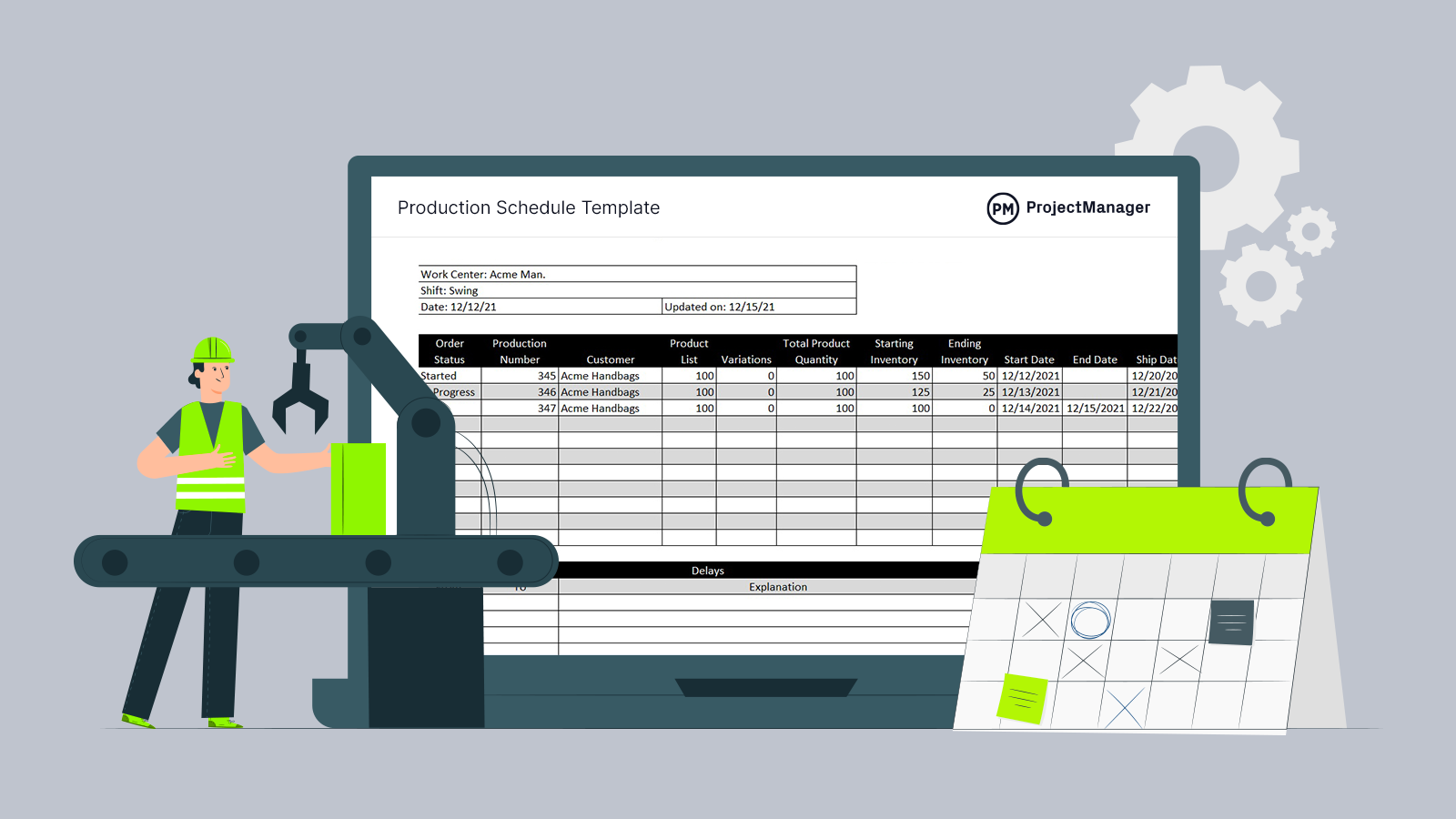
Get your free
- Production Schedule Template
Use this free Production Schedule Template for Excel to manage your projects better.
What Is Production Planning?
Production planning is the process of deciding how a product or service will be manufactured before the manufacturing process begins. In other words, it’s how you plan to manage your supply chain, raw materials, employees and the physical space where the manufacturing process occurs.
Production planning is important for manufacturers as it affects other important aspects of their business such as:
- Supply chain management
- Production scheduling
- Material requirements planning
- Production lead time
- Capacity planning
ProjectManager is project management software that helps manufacturers cover every aspect of production planning. Plan with Gantt charts, execute with kanban boards and manage resources along the way. No other software offers sophisticated project and resource management features in one intuitive package. Get started today for free.
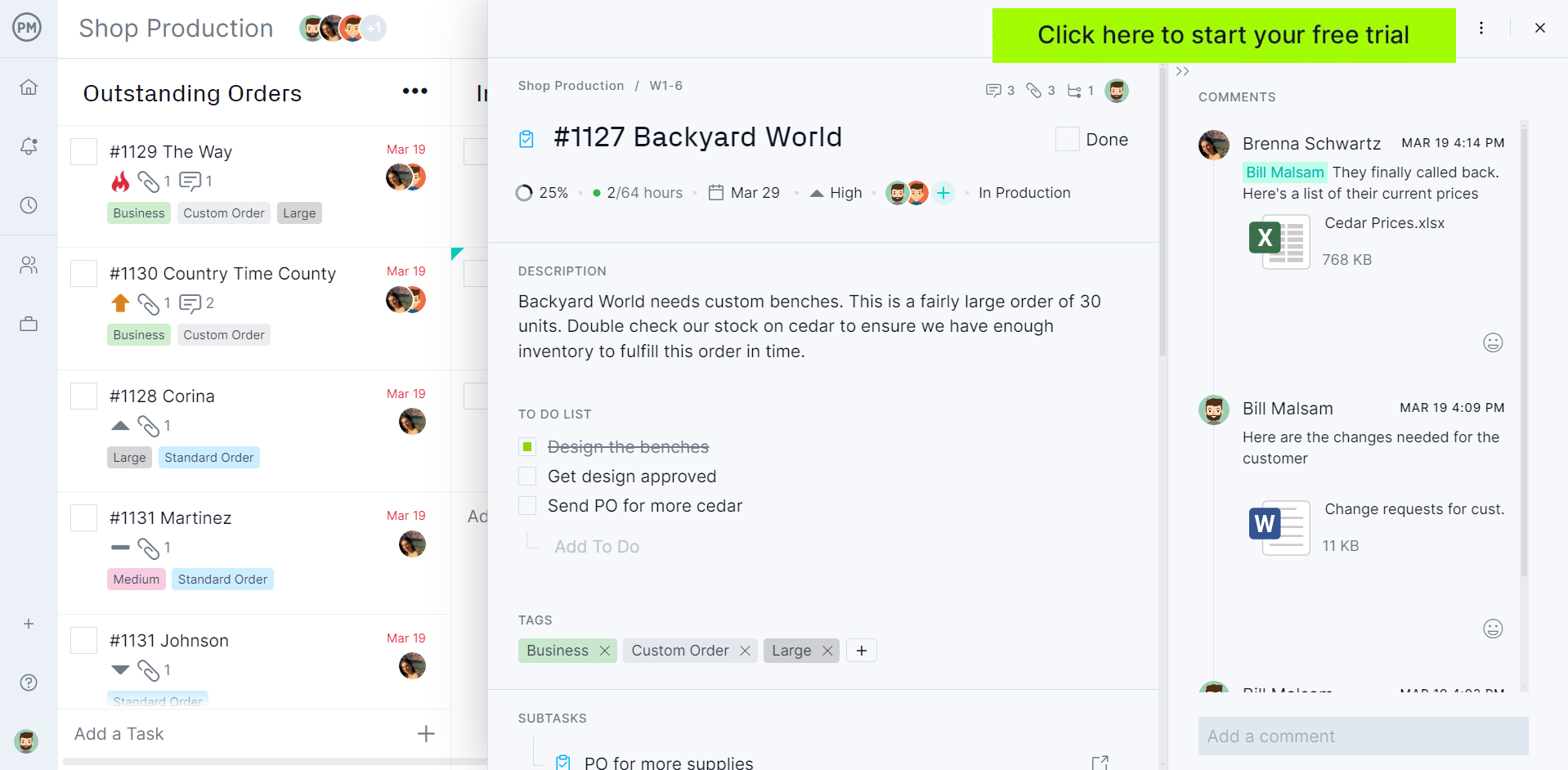
Why Is Production Planning Important?
If a manufacturing operation wishes to expand, that evolution demands careful production planning and scheduling. Someone must take on the responsibility of managing resources and deciding how they’ll be allocated. This process is a big part of capacity planning —how much can be made in a certain period, with the available resources?
Without production planning, it’s easy to use too much of a resource for one product and not leave enough for another, or fail to schedule your resources properly, which results in delays that affect your overall production management process. It’s just as easy to let resources go to waste. These issues indicate a lack of efficiency in your production planning process.
Production planning is the best way to ensure resources are used appropriately, products and services are high-quality and nothing goes over budget . In most organizations, a production manager manages the production planning process.

What Does a Production Planner Do?
A production planner is a team leader who oversees the production planning process, which defines how an organization will approach major areas of production management such as production scheduling, resource capacity planning, production control and production budgeting to manufacture products.
To better understand what a production planner does and the importance of this role in any manufacturing organization, let’s dive into each step of the production planning process.
10 Steps of the Production Planning Process
The production planning process consists of an organization’s actions to make a production strategy that allows it to manufacture products most efficiently and profitably. Here are 10 key steps you should follow when planning your production process.
1. Use Production Forecasting Methods for Estimating Customer Demand
The first step of the production planning process is to forecast the customer demand for your product for a future period like a year or a quarter. To do so, manufacturers rely on quantitative and qualitative techniques such as Delphi method, historical analogy method, moving average method and the analysis of business data and sales forecasts.
This process is known as demand planning , which helps manufacturers be better prepared to meet the demand for their products and manufacture the right quantity so they can minimize production and operational costs.
2. Gauge Your Production Capacity
The term production capacity refers to the maximum quantity of product a manufacturing company can produce based on its available production resources such as raw materials, labor, equipment and machinery.
Once you better understand the customer demand for your product, you’ll need to gauge the total quantity of product that needs to be manufactured and then evaluate if your production capacity is sufficient.
3. Map Out the Shop Floor Layout
Now think about the steps of the production process itself. Outline the production tasks that must be executed to transform raw materials, parts and components into a final product and the physical route that those elements will follow to move across the shop floor. This will allow you to pick a production floor layout that minimizes the time and effort required from your employees.
4. Make a Production Budget to Find the Optimal Production Volume
The next challenge in the production planning process is determining the exact number of units to manufacture to keep up with customer demand and maintain your desired stock levels.
This requires a production budget , a document used to calculate the number of units that should be produced by a company to meet the customer demand for a period such as a month, quarter or even a year.
Creating a production budget involves assessing the current product inventory, the production capacity, sales forecasts and the ending inventory that should remain at the end of the period. Once you analyze these variables and use the production budgeting formula, you’ll know the required production level for a given time.
5. Choose a Production Costing Technique
Choose a costing method for your production process such as activity-based costing, process costing, job costing or simply standard costing. Each has its pros and cons depending on your organization’s particular characteristics.
6. Create a Production Schedule
Now it’s time to make a production schedule that allows your organization to create a stock inventory, deliver products to distribution channels, fulfill customer orders and meet the obligations of any manufacturing contracts the organization has in place for the production timeline you’re planning for.
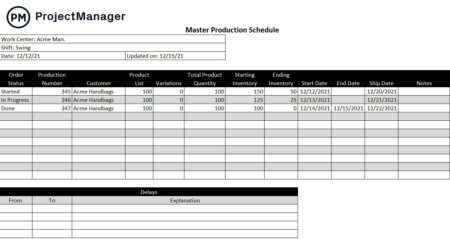
7. Establish a Production Control System
Next, it’s important to establish standard operating procedures and key performance indicators and use a variety of production control tools to create a system that allows you to track the production process to ensure your products meet quality standards and are manufactured on time and under budget.
8. Set Production Reporting Guidelines
After you’ve decided what KPIs will be used to monitor the efficiency of your production process, you’ll need to determine what types of reports will be used to communicate these metrics with stakeholders and the frequency in which they’ll be produced.
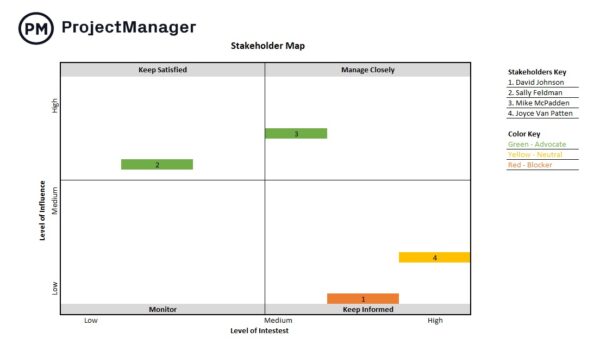
The documentation from each of these production planning stages, such as the production budget and production schedule are gathered in a larger document called the production plan.
What Is a Production Plan?
A production plan is a document that describes how production processes will be executed, and it’s the outcome of the production planning process. It describes the human resources, raw materials and equipment needed and the production schedule that will be followed.
The person responsible for production planning must also be very familiar with the operation’s inner workings, project resources and the products/services they produce. This usually entails collaborating with people on the floor, in the field or in different departments to create products and deliver services.
Production Plan Example
The best way to illustrate this process is through an example. When you set out to create a production plan, make sure to follow these steps to make it as robust as possible.
Sales Forecast
Making a sales forecast greatly helps you decide which product planning method is best for your operation given your production capacity. You’ll need to use diverse sales forecasting techniques to better understand what will be the future demand for your product. From here, you can estimate which resources are required and how they’ll be used in the manufacturing process to begin the production capacity planning process.
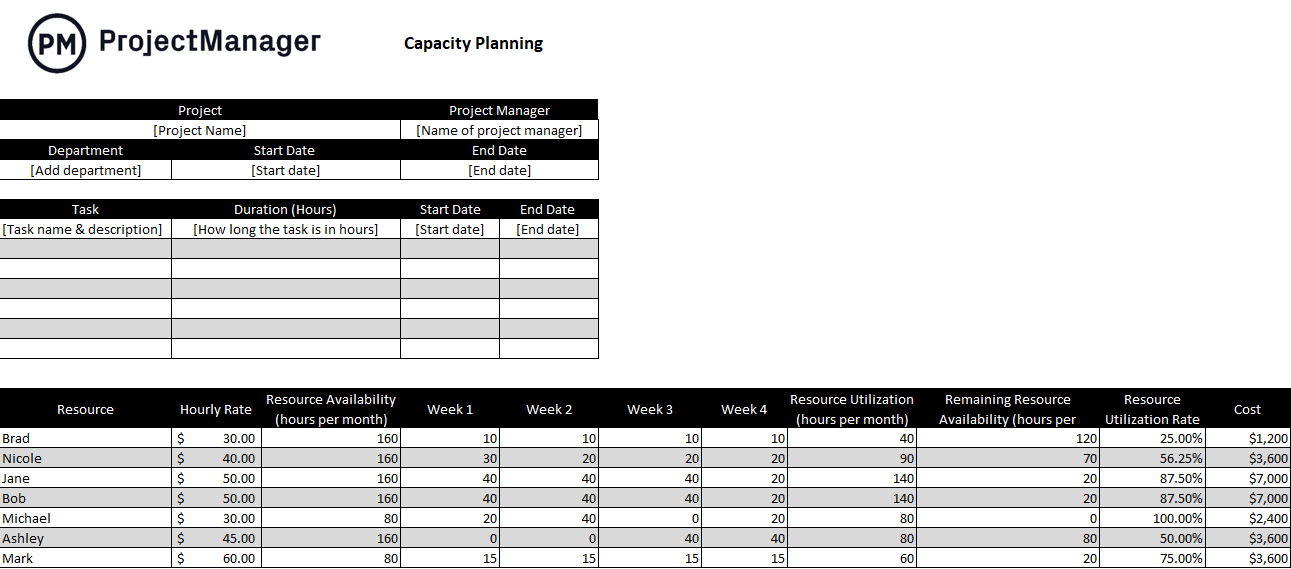
Inventory Management Plan
Accessing inventory is about more than simply taking stock: you should make an inventory management plan for your production inventory and work-in-progress inventory so that you don’t experience shortages that might halt production or let things go to waste. For this step, focus on the inventory control and inventory management techniques you can use to handle inventory in the most efficient way possible.

Production Budget
Most manufacturers use the production budgeting formula below to make a production budget that indicates the ideal production volume based on a starting inventory, sales forecasts, production capacity and expected ending inventory levels.
Required Production = Sales Forecast Expected Units + Desired Ending Inventory – Beginning Inventory
Resource Plan
A successful production plan requires you to be familiar with the resource planning details of the manufacturing process, which is why you’ll need to make a resource plan that outlines what resources such as labor, raw materials, equipment and any other capital assets are available for production and when they’re scheduled to be utilized.
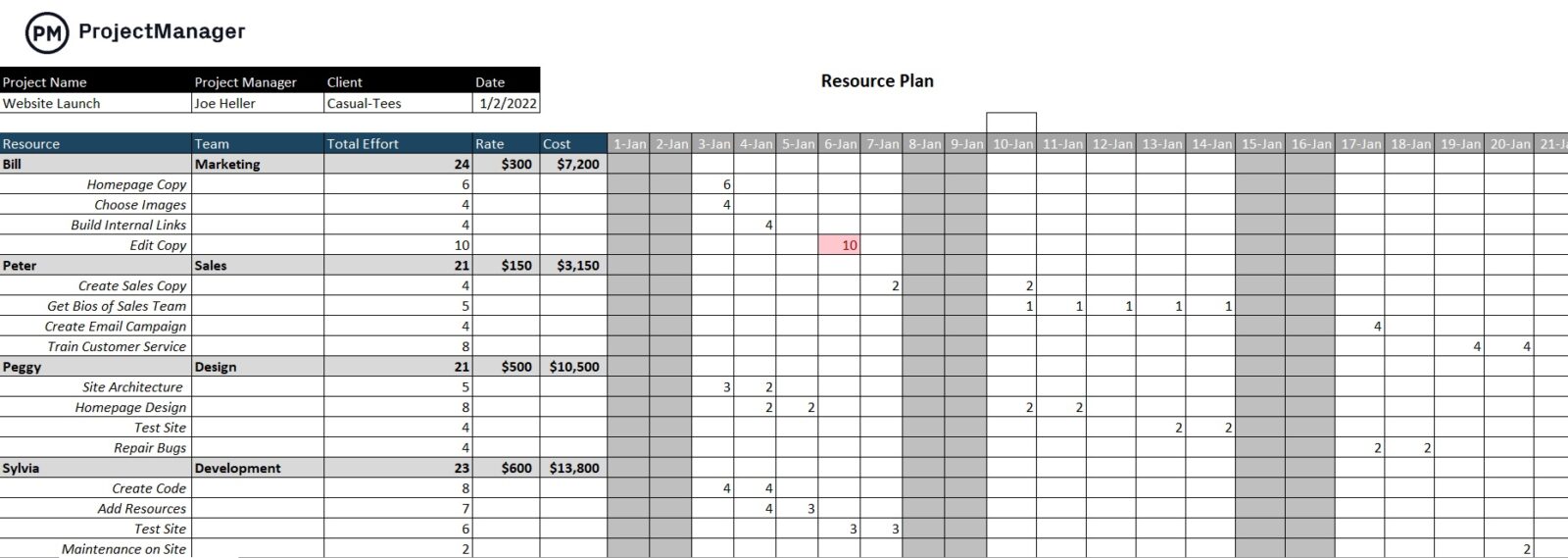
Production Cost Estimate
Once you’ve determined what the required level of production is and the resources that will be needed, you’ll need to estimate the cost of production . It’s important to ensure the production process will be profitable before creating a production schedule.
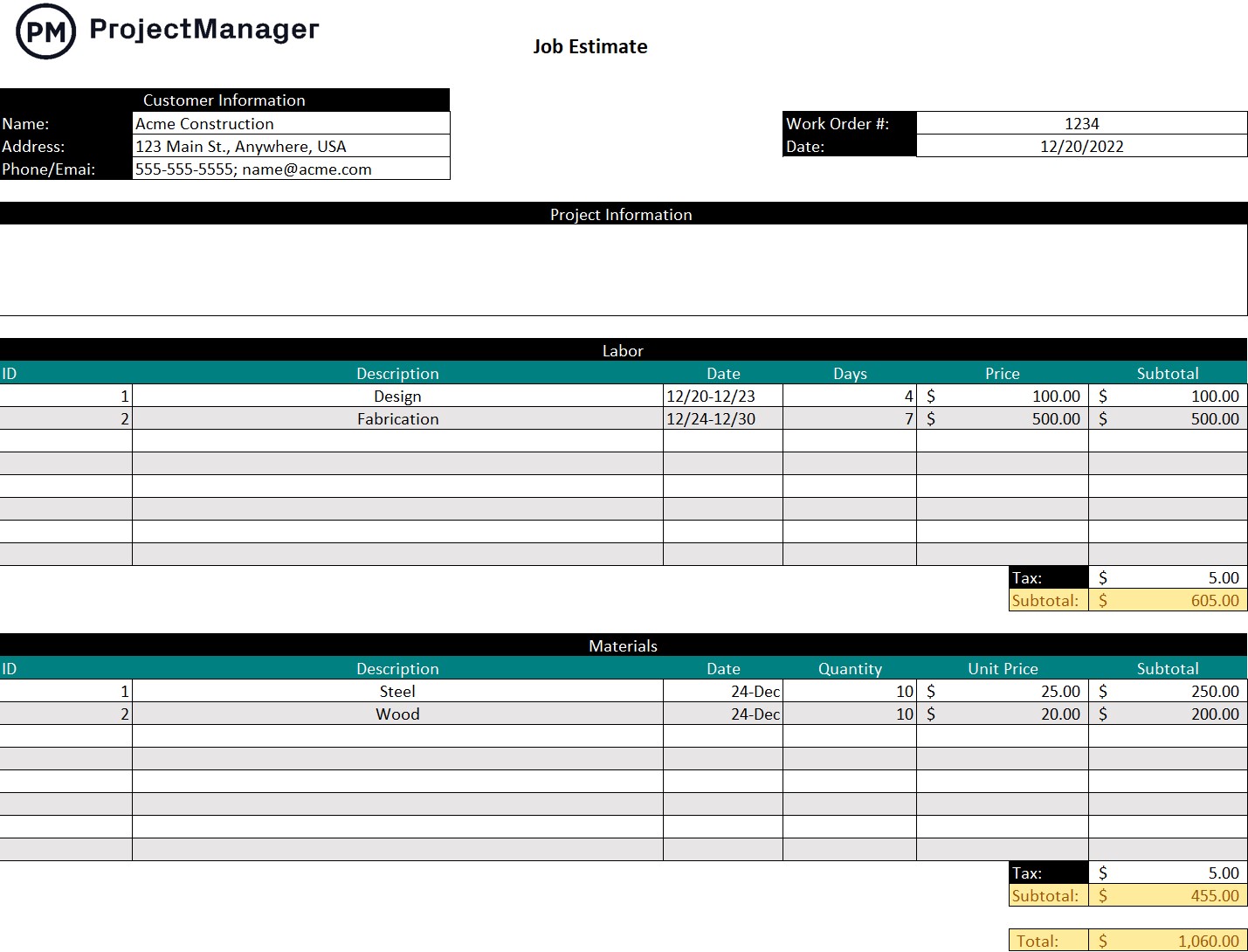
Production Schedule
As stated above, a production schedule is key to making sure your manufacturing team delivers products on time, but also guides efforts in other areas such as supply chain management and logistics management.
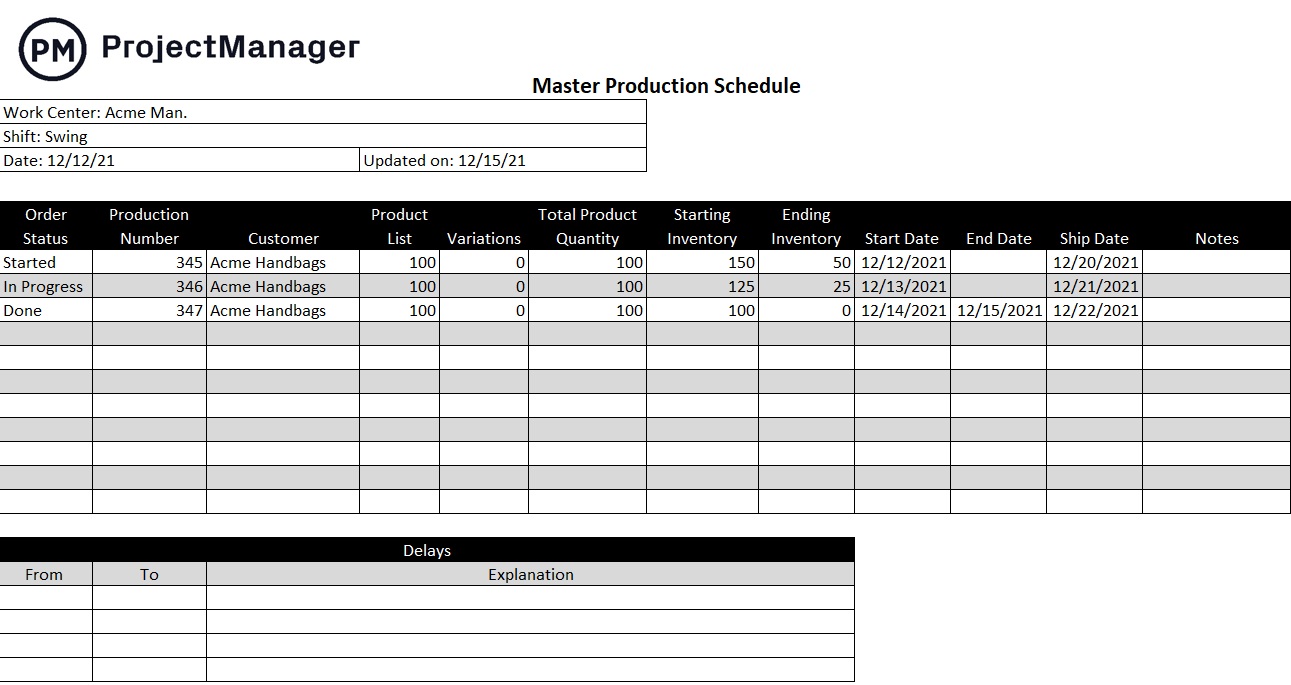
Production Control Plan
A production control plan should describe all the metrics, procedures, guidelines and tools that will be utilized to monitor how the results compare to the production schedule and resource management projections. This is something that should continually take place and be documented during the production process.
Types of Production Planning
Every operation is unique, and the same production plan isn’t right for everyone. To get the most from project planning, you decide which method is best for your manufacturing process. Here’s a quick intro to the different types of production planning.
The job method is often used when manufacturing a single product, for which a unique production plan is created. This production planning method is generally used in smaller-scale productions, but it can also be applied to larger manufacturing facilities. The job method is especially advantageous when a production order requires specific customizations.
Batch Production Method
Batch production consists of manufacturing goods in groups, instead of being produced individually or through continuous production . This method is useful when manufacturing products on a large scale.
Flow Method
The flow method is a demand-based manufacturing model that minimizes the production lead time by speeding up the production line. The manufacturing process starts based on work orders, and once it starts, it doesn’t stop until all finished goods are produced. This is called continuous production and it’s achieved by using machinery and little intervention to minimize waiting time.
Process Method
The process method is more or less what most people picture when they think about production—an assembly line. With the process method, there will generally be different types of machinery that complete separate tasks to put together the finished goods.
Mass Production Method
The mass production method primarily focuses on creating a continuous flow of identical products. It’s similar to the flow method, but at a much bigger scale, which cuts production costs. When uniformity is just as critical as efficiency, use “standardized processes” to guarantee all products look the same.

Production Planning Best Practices
No matter what product or service is being manufactured, there are many tried-and-true best practices to increase your operational efficiency . When creating a production plan, keep these two in mind.
Make Accurate Forecasts
When you don’t properly estimate the demand for your product or service, it’s impossible to create a detailed production plan. Demand planning is never static. Consider buying trends from previous years, changes in demographics, changes in resource availability and many other factors. These demand planning forecasts are the foundation of skillful production planning.
Know Your Capacity
Capacity planning means knowing the maximum capacity your operation can manage—the absolute most of a product or service it can offer during a period of time. This is the only way to anticipate how much of each resource you need to create X amount of products.
When you don’t know the production capacity, your production planning is like taking a shot in the dark.
Common Production Planning Mistakes
Stay vigilant of common missteps as you go through the production planning process. Here are three mistakes often made during production planning. Luckily, they can be prevented.
Not Expecting the Unexpected
This means having risk management strategies in place if things go awry. The goal is to never have to employ them, of course, but it’s better to have them and not need them. Production planning is incomplete if it doesn’t anticipate risks, issues and changes. When you plan for them, you’re ready to problem-solve if and when they happen.
Getting Stuck Behind the Desk
You should work with intelligent production planning tools, but that doesn’t mean you should only rely on enterprise resource planning software for production planning and not oversee resources and manufacturing operations in person. When production planning is only done from behind a screen, the result won’t be as informed as it could be. The best production planning is active and collaborative.
Neglecting Equipment
To get the most from your equipment, you need to take care of it. This means tracking usage and keeping up with regular maintenance. This looks different depending on the industry and product or service, but the principle is the same: continually take care of your equipment before it becomes a problem that slows down production.
Use ProjectManager for Production Planning and Scheduling
As the nature of manufacturing goods and services changes, you need modern tools to plan production and make schedules. ProjectManager is award-winning project management software that offers all the tools you need for excellent production planning and scheduling. With it, you can plan projects, create schedules, manage resources and track changes with one tool.
Plan With Gantt Charts
Manage your product manufacturing across a timeline with our Gantt chart view. With it, you can view your resources to help you track your cost of production to ensure you’re never overspending. You can then link any dependent tasks to avoid bottlenecks in your manufacturing.
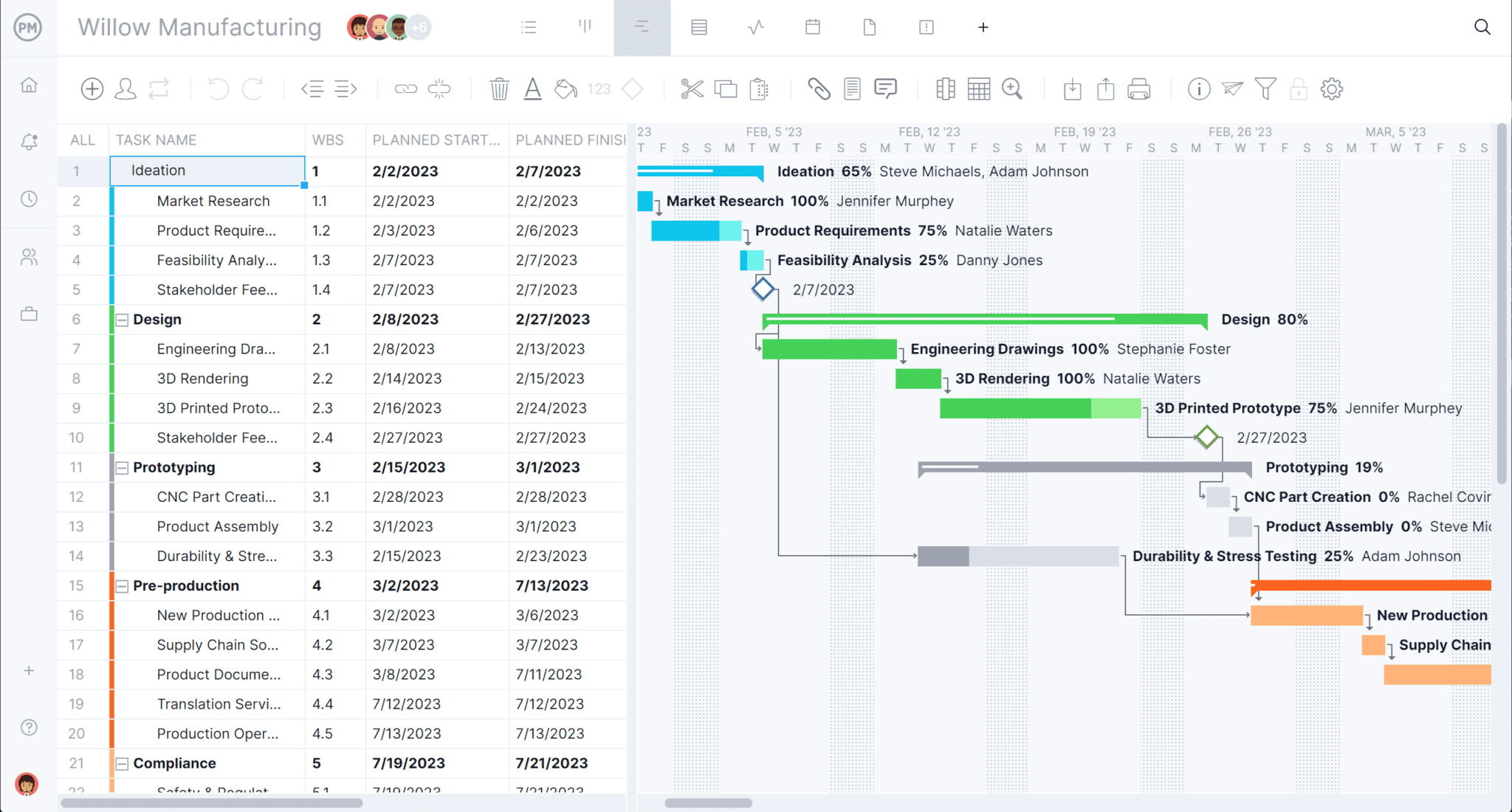
Get a Bird’s-Eye View
To keep your production plan on track, you need a high-level view to pinpoint setbacks before or as they occur. Our real-time dashboard collects data and converts it into colorful graphs and charts that give you at-a-glance analytics.
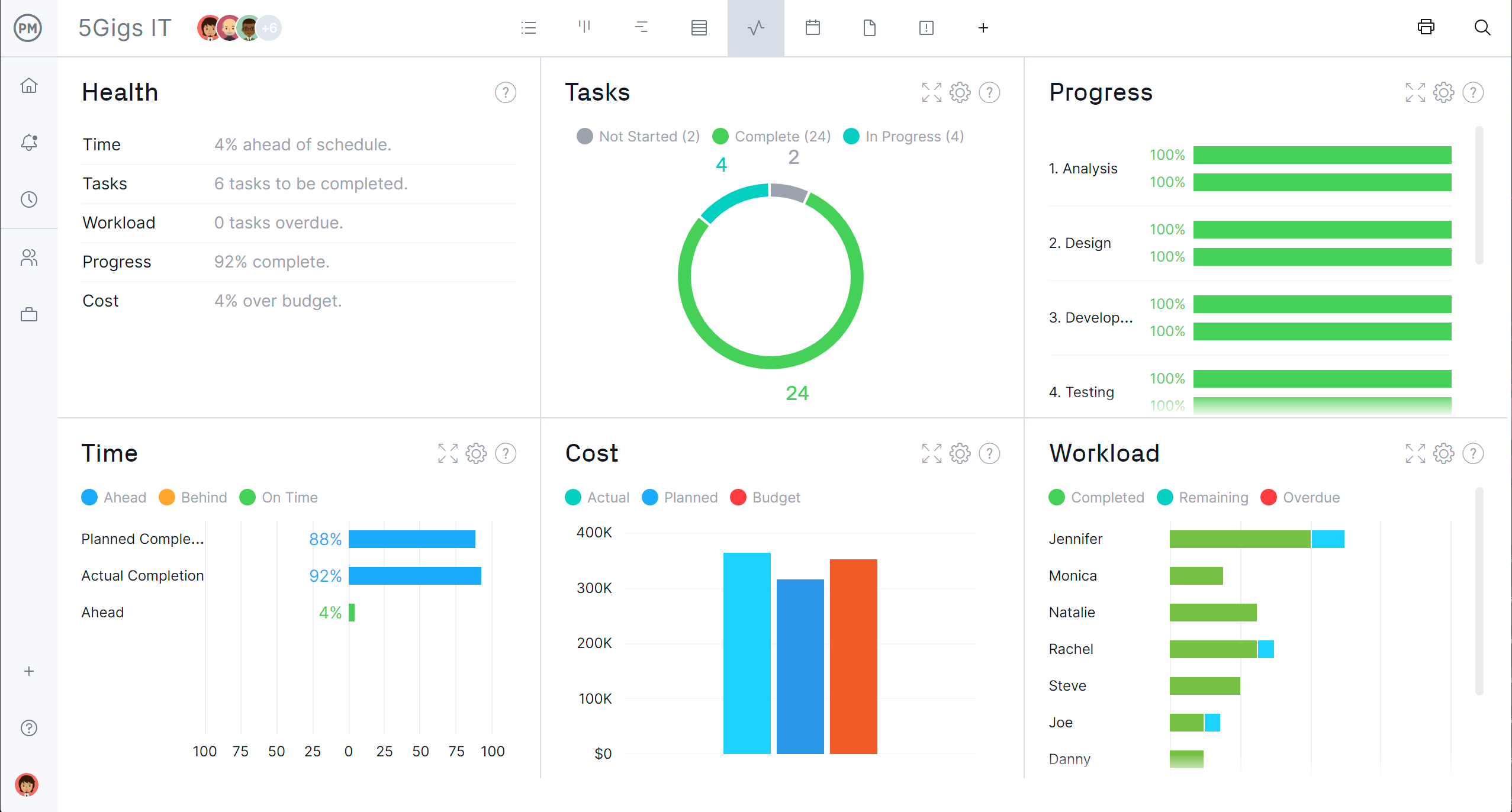
Easily Measure and Report Your Progress
Any operation will have stakeholders who want to be kept in the loop. ProjectManager’s project status reports make it easy to share key data points. They can be generated in a single click, making it simple to generate them before important meetings.
Related Production Planning Content
The production planning process involves many different activities such as estimating the quantity of goods to be produced, the resources needed, the production schedule and much more. That’s why we’ve created dozens of blogs, guides and templates on production management topics. Here are some of them.
- Production vs. Manufacturing
- How to Make a Production Flow Chart for Manufacturing
- Best Production Scheduling Software Rankings
- How to Create a Master Production Schedule (MPS)
Manage every detail of your operation with ProjectManager’s powerful online project management tools. Our suite of tools is trusted by tens of thousands of teams, from NASA to Volvo, to aid them in the planning, scheduling, tracking and reporting on the progress and performance of their production plans. Our software lets you get out from behind your desk and make adjustments on the go. Try it for yourself for free for 30 days!

Deliver your projects on time and on budget
Start planning your projects.
- Search Search Please fill out this field.
- Building Your Business
- Becoming an Owner
- Business Plans
How To Write the Operations Plan Section of the Business Plan
Susan Ward wrote about small businesses for The Balance for 18 years. She has run an IT consulting firm and designed and presented courses on how to promote small businesses.
:max_bytes(150000):strip_icc():format(webp)/SusanWardLaptop2crop1-57aa62eb5f9b58974a12bac9.jpg)
Stage of Development Section
Production process section, the bottom line, frequently asked questions (faqs).
The operations plan is the section of your business plan that gives an overview of your workflow, supply chains, and similar aspects of your business. Any key details of how your business physically produces goods or services will be included in this section.
You need an operations plan to help others understand how you'll deliver on your promise to turn a profit. Keep reading to learn what to include in your operations plan.
Key Takeaways
- The operations plan section should include general operational details that help investors understand the physical details of your vision.
- Details in the operations plan include information about any physical plants, equipment, assets, and more.
- The operations plan can also serve as a checklist for startups; it includes a list of everything that must be done to start turning a profit.
In your business plan , the operations plan section describes the physical necessities of your business's operation, such as your physical location, facilities, and equipment. Depending on what kind of business you'll be operating, it may also include information about inventory requirements, suppliers, and a description of the manufacturing process.
Keeping focused on the bottom line will help you organize this part of the business plan.
Think of the operating plan as an outline of the capital and expense requirements your business will need to operate from day to day.
You need to do two things for the reader of your business plan in the operations section: show what you've done so far to get your business off the ground and demonstrate that you understand the manufacturing or delivery process of producing your product or service.
When you're writing this section of the operations plan, start by explaining what you've done to date to get the business operational, then follow up with an explanation of what still needs to be done. The following should be included:
Production Workflow
A high-level, step-by-step description of how your product or service will be made, identifying the problems that may occur in the production process. Follow this with a subsection titled "Risks," which outlines the potential problems that may interfere with the production process and what you're going to do to negate these risks. If any part of the production process can expose employees to hazards, describe how employees will be trained in dealing with safety issues. If hazardous materials will be used, describe how these will be safely stored, handled, and disposed.
Industry Association Memberships
Show your awareness of your industry's local, regional, or national standards and regulations by telling which industry organizations you are already a member of and which ones you plan to join. This is also an opportunity to outline what steps you've taken to comply with the laws and regulations that apply to your industry.
Supply Chains
An explanation of who your suppliers are and their prices, terms, and conditions. Describe what alternative arrangements you have made or will make if these suppliers let you down.
Quality Control
An explanation of the quality control measures that you've set up or are going to establish. For example, if you intend to pursue some form of quality control certification such as ISO 9000, describe how you will accomplish this.
While you can think of the stage of the development part of the operations plan as an overview, the production process section lays out the details of your business's day-to-day operations. Remember, your goal for writing this business plan section is to demonstrate your understanding of your product or service's manufacturing or delivery process.
When writing this section, you can use the headings below as subheadings and then provide the details in paragraph format. Leave out any topic that does not apply to your particular business.
Do an outline of your business's day-to-day operations, including your hours of operation and the days the business will be open. If the business is seasonal, be sure to say so.
The Physical Plant
Describe the type, site, and location of premises for your business. If applicable, include drawings of the building, copies of lease agreements, and recent real estate appraisals. You need to show how much the land or buildings required for your business operations are worth and tell why they're important to your proposed business.
The same goes for equipment. Besides describing the equipment necessary and how much of it you need, you also need to include its worth and cost and explain any financing arrangements.
Make a list of your assets , such as land, buildings, inventory, furniture, equipment, and vehicles. Include legal descriptions and the worth of each asset.
Special Requirements
If your business has any special requirements, such as water or power needs, ventilation, drainage, etc., provide the details in your operating plan, as well as what you've done to secure the necessary permissions.
State where you're going to get the materials you need to produce your product or service and explain what terms you've negotiated with suppliers.
Explain how long it takes to produce a unit and when you'll be able to start producing your product or service. Include factors that may affect the time frame of production and describe how you'll deal with potential challenges such as rush orders.
Explain how you'll keep track of inventory .
Feasibility
Describe any product testing, price testing, or prototype testing that you've done on your product or service.
Give details of product cost estimates.
Once you've worked through this business plan section, you'll not only have a detailed operations plan to show your readers, but you'll also have a convenient list of what needs to be done next to make your business a reality. Writing this document gives you a chance to crystalize your business ideas into a clear checklist that you can reference. As you check items off the list, use it to explain your vision to investors, partners, and others within your organization.
What is an operations plan?
An operations plan is one section of a company's business plan. This section conveys the physical requirements for your business's operations, including supply chains, workflow , and quality control processes.
What is the main difference between the operations plan and the financial plan?
The operations plan and financial plan tackle similar issues, in that they seek to explain how the business will turn a profit. The operations plan approaches this issue from a physical perspective, such as property, routes, and locations. The financial plan explains how revenue and expenses will ultimately lead to the business's success.
Want to read more content like this? Sign up for The Balance's newsletter for daily insights, analysis, and financial tips, all delivered straight to your inbox every morning!
How to Write a Business Plan (Plus Examples & Templates)
Have you ever wondered how to write a business plan step by step? Mike Andes, told us:
This guide will help you write a business plan to impress investors.
Throughout this process, we’ll get information from Mike Andes, who started Augusta Lawn Care Services when he was 12 and turned it into a franchise with over 90 locations. He has gone on to help others learn how to write business plans and start businesses. He knows a thing or two about writing business plans!
We’ll start by discussing the definition of a business plan. Then we’ll discuss how to come up with the idea, how to do the market research, and then the important elements in the business plan format. Keep reading to start your journey!
What Is a Business Plan?
A business plan is simply a road map of what you are trying to achieve with your business and how you will go about achieving it. It should cover all elements of your business including:
- Finding customers
- Plans for developing a team
- Competition
- Legal structures
- Key milestones you are pursuing
If you aren’t quite ready to create a business plan, consider starting by reading our business startup guide .
Get a Business Idea
Before you can write a business plan, you have to have a business idea. You may see a problem that needs to be solved and have an idea how to solve it, or you might start by evaluating your interests and skills.
Mike told us, “The three things I suggest asking yourself when thinking about starting a business are:
- What am I good at?
- What would I enjoy doing?
- What can I get paid for?”

If all three of these questions don’t lead to at least one common answer, it will probably be a much harder road to success. Either there is not much market for it, you won’t be good at it, or you won’t enjoy doing it.
As Mike told us, “There’s enough stress starting and running a business that if you don’t like it or aren’t good at it, it’s hard to succeed.”
If you’d like to hear more about Mike’s approach to starting a business, check out our YouTube video
Conduct Market Analysis
Market analysis is focused on establishing if there is a target market for your products and services, how large the target market is, and identifying the demographics of people or businesses that would be interested in the product or service. The goal here is to establish how much money your business concept can make.
Product and Service Demand

A search engine is your best friend when trying to figure out if there is demand for your products and services. Personally, I love using presearch.org because it lets you directly search on a ton of different platforms including Google, Youtube, Twitter, and more. Check out the screenshot for the full list of search options.
With quick web searches, you can find out how many competitors you have, look through their reviews, and see if there are common complaints about the competitors. Bad reviews are a great place to find opportunities to offer better products or services.
If there are no similar products or services, you may have stumbled upon something new, or there may just be no demand for it. To find out, go talk to your most honest friend about the idea and see what they think. If they tell you it’s dumb or stare at you vacantly, there’s probably no market for it.
You can also conduct a survey through social media to get public opinion on your idea. Using Facebook Business Manager , you could get a feel for who would be interested in your product or service.
I ran a quick test of how many people between 18-65 you could reach in the U.S. during a week. It returned an estimated 700-2,000 for the total number of leads, which is enough to do a fairly accurate statistical analysis.
Identify Demographics of Target Market
Depending on what type of business you want to run, your target market will be different. The narrower the demographic, the fewer potential customers you’ll have. If you did a survey, you’ll be able to use that data to help define your target audience. Some considerations you’ll want to consider are:
- Other Interests
- Marital Status
- Do they have kids?
Once you have this information, it can help you narrow down your options for location and help define your marketing further. One resource that Mike recommended using is the Census Bureau’s Quick Facts Map . He told us,
“It helps you quickly evaluate what the best areas are for your business to be located.”
How to Write a Business Plan

Now that you’ve developed your idea a little and established there is a market for it, you can begin writing a business plan. Getting started is easier with the business plan template we created for you to download. I strongly recommend using it as it is updated to make it easier to create an action plan.
Each of the following should be a section of your business plan:
- Business Plan Cover Page
- Table of Contents
- Executive Summary
- Company Description
- Description of Products and Services
SWOT Analysis
- Competitor Data
- Competitive Analysis
- Marketing Expenses Strategy
Pricing Strategy
- Distribution Channel Assessment
- Operational Plan
- Management and Organizational Strategy
- Financial Statements and/or Financial Projections
We’ll look into each of these. Don’t forget to download our free business plan template (mentioned just above) so you can follow along as we go.
How to Write a Business Plan Step 1. Create a Cover Page
The first thing investors will see is the cover page for your business plan. Make sure it looks professional. A great cover page shows that you think about first impressions.
A good business plan should have the following elements on a cover page:
- Professionally designed logo
- Company name
- Mission or Vision Statement
- Contact Info
Basically, think of a cover page for your business plan like a giant business card. It is meant to capture people’s attention but be quickly processed.
How to Write a Business Plan Step 2. Create a Table of Contents
Most people are busy enough that they don’t have a lot of time. Providing a table of contents makes it easy for them to find the pages of your plan that are meaningful to them.
A table of contents will be immediately after the cover page, but you can include it after the executive summary. Including the table of contents immediately after the executive summary will help investors know what section of your business plan they want to review more thoroughly.
Check out Canva’s article about creating a table of contents . It has a ton of great information about creating easy access to each section of your business plan. Just remember that you’ll want to use different strategies for digital and hard copy business plans.
How to Write a Business Plan Step 3. Write an Executive Summary

An executive summary is where your business plan should catch the readers interest. It doesn’t need to be long, but should be quick and easy to read.
Mike told us,
How long should an executive summary bein an informal business plan?
For casual use, an executive summary should be similar to an elevator pitch, no more than 150-160 words, just enough to get them interested and wanting more. Indeed has a great article on elevator pitches . This can also be used for the content of emails to get readers’ attention.
It consists of three basic parts:
- An introduction to you and your business.
- What your business is about.
- A call to action
Example of an informal executive summary
One of the best elevator pitches I’ve used is:
So far that pitch has achieved a 100% success rate in getting partnerships for the business.
What should I include in an executive summary for investors?
Investors are going to need a more detailed executive summary if you want to secure financing or sell equity. The executive summary should be a brief overview of your entire business plan and include:
- Introduction of yourself and company.
- An origin story (Recognition of a problem and how you came to solution)
- An introduction to your products or services.
- Your unique value proposition. Make sure to include intellectual property.
- Where you are in the business life cycle
- Request and why you need it.
Successful business plan examples
The owner of Urbanity told us he spent 2 months writing a 75-page business plan and received a $250,000 loan from the bank when he was 23. Make your business plan as detailed as possible when looking for financing. We’ve provided a template to help you prepare the portions of a business plan that banks expect.
Here’s the interview with the owner of Urbanity:
When to write an executive summary?
Even though the summary is near the beginning of a business plan, you should write it after you complete the rest of a business plan. You can’t talk about revenue, profits, and expected expenditures if you haven’t done the market research and created a financial plan.
What mistakes do people make when writing an executive summary?
Business owners commonly go into too much detail about the following items in an executive summary:
- Marketing and sales processes
- Financial statements
- Organizational structure
- Market analysis
These are things that people will want to know later, but they don’t hook the reader. They won’t spark interest in your small business, but they’ll close the deal.
How to Write a Business Plan Step 4. Company Description
Every business plan should include a company description. A great business plan will include the following elements while describing the company:
- Mission statement
- Philosophy and vision
- Company goals
Target market
- Legal structure
Let’s take a look at what each section includes in a good business plan.
Mission Statement
A mission statement is a brief explanation of why you started the company and what the company’s main focus is. It should be no more than one or two sentences. Check out HubSpot’s article 27 Inspiring Mission Statement for a great read on informative and inspiring mission and vision statements.
Company Philosophy and Vision

The company philosophy is what drives your company. You’ll normally hear them called core values. These are the building blocks that make your company different. You want to communicate your values to customers, business owners, and investors as often as possible to build a company culture, but make sure to back them up.
What makes your company different?
Each company is different. Your new business should rise above the standard company lines of honesty, integrity, fun, innovation, and community when communicating your business values. The standard answers are corporate jargon and lack authenticity.
Examples of core values
One of my clients decided to add a core values page to their website. As a tech company they emphasized the values:
- Prioritize communication.
- Never stop learning.
- Be transparent.
- Start small and grow incrementally.
These values communicate how the owner and the rest of the company operate. They also show a value proposition and competitive advantage because they specifically focus on delivering business value from the start. These values also genuinely show what the company is about and customers recognize the sincerity. Indeed has a great blog about how to identify your core values .
What is a vision statement?
A vision statement communicate the long lasting change a business pursues. The vision helps investors and customers understand what your company is trying to accomplish. The vision statement goes beyond a mission statement to provide something meaningful to the community, customer’s lives, or even the world.
Example vision statements
The Alzheimer’s Association is a great example of a vision statement:
A world without Alzheimer’s Disease and other dementia.
It clearly tells how they want to change the world. A world without Alzheimers might be unachievable, but that means they always have room for improvement.
Business Goals
You have to measure success against goals for a business plan to be meaningful. A business plan helps guide a company similar to how your GPS provides a road map to your favorite travel destination. A goal to make as much money as possible is not inspirational and sounds greedy.
Sure, business owners want to increase their profits and improve customer service, but they need to present an overview of what they consider success. The goals should help everyone prioritize their work.
How far in advance should a business plan?
Business planning should be done at least one year in advance, but many banks and investors prefer three to five year business plans. Longer plans show investors that the management team understands the market and knows the business is operating in a constantly shifting market. In addition, a plan helps businesses to adjust to changes because they have already considered how to handle them.
Example of great business goals
My all time-favorite long-term company goals are included in Tesla’s Master Plan, Part Deux . These goals were written in 2016 and drive the company’s decisions through 2026. They are the reason that investors are so forgiving when Elon Musk continually fails to meet his quarterly and annual goals.
If the progress aligns with the business plan investors are likely to continue to believe in the company. Just make sure the goals are reasonable or you’ll be discredited (unless you’re Elon Musk).

You did target market research before creating a business plan. Now it’s time to add it to the plan so others understand what your ideal customer looks like. As a new business owner, you may not be considered an expert in your field yet, so document everything. Make sure the references you use are from respectable sources.
Use information from the specific lender when you are applying for lending. Most lenders provide industry research reports and using their data can strengthen the position of your business plan.
A small business plan should include a section on the external environment. Understanding the industry is crucial because we don’t plan a business in a vacuum. Make sure to research the industry trends, competitors, and forecasts. I personally prefer IBIS World for my business research. Make sure to answer questions like:
- What is the industry outlook long-term and short-term?
- How will your business take advantage of projected industry changes and trends?
- What might happen to your competitors and how will your business successfully compete?
Industry resources
Some helpful resources to help you establish more about your industry are:
- Trade Associations
- Federal Reserve
- Bureau of Labor Statistics
Legal Structure
There are five basic types of legal structures that most people will utilize:
- Sole proprietorships
- Limited Liability Companies (LLC)
Partnerships
Corporations.
- Franchises.
Each business structure has their pros and cons. An LLC is the most common legal structure due to its protection of personal assets and ease of setting up. Make sure to specify how ownership is divided and what roles each owner plays when you have more than one business owner.
You’ll have to decide which structure is best for you, but we’ve gathered information on each to make it easier.
Sole Proprietorship
A sole proprietorship is the easiest legal structure to set up but doesn’t protect the owner’s personal assets from legal issues. That means if something goes wrong, you could lose both your company and your home.
To start a sole proprietorship, fill out a special tax form called a Schedule C . Sole proprietors can also join the American Independent Business Alliance .
Limited Liability Company (LLC)
An LLC is the most common business structure used in the United States because an LLC protects the owner’s personal assets. It’s similar to partnerships and corporations, but can be a single-member LLC in most states. An LLC requires a document called an operating agreement.
Each state has different requirements. Here’s a link to find your state’s requirements . Delaware and Nevada are common states to file an LLC because they are really business-friendly. Here’s a blog on the top 10 states to get an LLC.
Partnerships are typically for legal firms. If you choose to use a partnership choose a Limited Liability Partnership. Alternatively, you can just use an LLC.
Corporations are typically for massive organizations. Corporations have taxes on both corporate and income tax so unless you plan on selling stock, you are better off considering an LLC with S-Corp status . Investopedia has good information corporations here .

There are several opportunities to purchase successful franchises. TopFranchise.com has a list of companies in a variety of industries that offer franchise opportunities. This makes it where an entrepreneur can benefit from the reputation of an established business that has already worked out many of the kinks of starting from scratch.
How to Write a Business Plan Step 5. Products and Services
This section of the business plan should focus on what you sell, how you source it, and how you sell it. You should include:
- Unique features that differentiate your business products from competitors
- Intellectual property
- Your supply chain
- Cost and pricing structure
Questions to answer about your products and services
Mike gave us a list of the most important questions to answer about your product and services:
- How will you be selling the product? (in person, ecommerce, wholesale, direct to consumer)?
- How do you let them know they need a product?
- How do you communicate the message?
- How will you do transactions?
- How much will you be selling it for?
- How many do you think you’ll sell and why?
Make sure to use the worksheet on our business plan template .
How to Write a Business Plan Step 6. Sales and Marketing Plan
The marketing and sales plan is focused on the strategy to bring awareness to your company and guides how you will get the product to the consumer. It should contain the following sections:
SWOT Analysis stands for strengths, weaknesses, opportunities, and threats. Not only do you want to identify them, but you also want to document how the business plans to deal with them.
Business owners need to do a thorough job documenting how their service or product stacks up against the competition.
If proper research isn’t done, investors will be able to tell that the owner hasn’t researched the competition and is less likely to believe that the team can protect its service from threats by the more well-established competition. This is one of the most common parts of a presentation that trips up business owners presenting on Shark Tank .
SWOT Examples

Examples of strengths and weaknesses could be things like the lack of cash flow, intellectual property ownership, high costs of suppliers, and customers’ expectations on shipping times.
Opportunities could be ways to capitalize on your strengths or improve your weaknesses, but may also be gaps in the industry. This includes:
- Adding offerings that fit with your current small business
- Increase sales to current customers
- Reducing costs through bulk ordering
- Finding ways to reduce inventory
- And other areas you can improve
Threats will normally come from outside of the company but could also be things like losing a key member of the team. Threats normally come from competition, regulations, taxes, and unforeseen events.
The management team should use the SWOT analysis to guide other areas of business planning, but it absolutely has to be done before a business owner starts marketing.
Include Competitor Data in Your Business Plan
When you plan a business, taking into consideration the strengths and weaknesses of the competition is key to navigating the field. Providing an overview of your competition and where they are headed shows that you are invested in understanding the industry.
For smaller businesses, you’ll want to search both the company and the owners names to see what they are working on. For publicly held corporations, you can find their quarterly and annual reports on the SEC website .
What another business plans to do can impact your business. Make sure to include things that might make it attractive for bigger companies to outsource to a small business.
Marketing Strategy
The marketing and sales part of business plans should be focused on how you are going to make potential customers aware of your business and then sell to them.
If you haven’t already included it, Mike recommends:
“They’ll want to know about Demographics, ages, and wealth of your target market.”
Make sure to include the Total addressable market . The term refers to the value if you captured 100% of the market.
Advertising Strategy
You’ll explain what formats of advertising you’ll be using. Some possibilities are:
- Online: Facebook and Google are the big names to work with here.
- Print : Print can be used to reach broad groups or targeted markets. Check out this for tips .
- Radio : iHeartMedia is one of the best ways to advertise on the radio
- Cable television : High priced, hard to measure ROI, but here’s an explanation of the process
- Billboards: Attracting customers with billboards can be beneficial in high traffic areas.
You’ll want to define how you’ll be using each including frequency, duration, and cost. If you have the materials already created, including pictures or links to the marketing to show creative assets.
Mike told us “Most businesses are marketing digitally now due to Covid, but that’s not always the right answer.”
Make sure the marketing strategy will help team members or external marketing agencies stay within the brand guidelines .

This section of a business plan should be focused on pricing. There are a ton of pricing strategies that may work for different business plans. Which one will work for you depends on what kind of a business you run.
Some common pricing strategies are:
- Value-based pricing – Commonly used with home buying and selling or other products that are status symbols.
- Skimming pricing – Commonly seen in video game consoles, price starts off high to recoup expenses quickly, then reduces over time.
- Competition-based pricing – Pricing based on competitors’ pricing is commonly seen at gas stations.
- Freemium services – Commonly used for software, where there is a free plan, then purchase options for more functionality.
HubSpot has a great calculator and blog on pricing strategies.
Beyond explaining what strategy your business plans to use, you should include references for how you came to this pricing strategy and how it will impact your cash flow.
Distribution Plan
This part of a business plan is focused on how the product or service is going to go through the supply chain. These may include multiple divisions or multiple companies. Make sure to include any parts of the workflow that are automated so investors can see where cost savings are expected and when.
Supply Chain Examples
For instance, lawn care companies would need to cover aspects such as:
- Suppliers for lawn care equipment and tools
- Any chemicals or treatments needed
- Repair parts for sprinkler systems
- Vehicles to transport equipment and employees
- Insurance to protect the company vehicles and people.
Examples of Supply Chains
These are fairly flat supply chains compared to something like a clothing designer where the clothes would go through multiple vendors. A clothing company might have the following supply chain:
- Raw materials
- Shipping of raw materials
- Converting of raw materials to thread
- Shipping thread to produce garments
- Garment producer
- Shipping to company
- Company storage
- Shipping to retail stores
There have been advances such as print on demand that eliminate many of these steps. If you are designing completely custom clothing, all of this would need to be planned to keep from having business disruptions.
The main thing to include in the business plan is the list of suppliers, the path the supply chain follows, the time from order to the customer’s home, and the costs associated with each step of the process.
According to BizPlanReview , a business plan without this information is likely to get rejected because they have failed to research the key elements necessary to make sales to the customer.
How to Write a Business Plan Step 7. Company Organization and Operational Plan
This part of the business plan is focused on how the business model will function while serving customers. The business plan should provide an overview of how the team will manage the following aspects:
Quality Control
- Legal environment
Let’s look at each for some insight.
Production has already been discussed in previous sections so I won’t go into it much. When writing a business plan for investors, try to avoid repetition as it creates a more simple business plan.
If the organizational plan will be used by the team as an overview of how to perform the best services for the customer, then redundancy makes more sense as it communicates what is important to the business.

Quality control policies help to keep the team focused on how to verify that the company adheres to the business plan and meets or exceeds customer expectations.
Quality control can be anything from a standard that says “all labels on shirts can be no more than 1/16″ off center” to a defined checklist of steps that should be performed and filled out for every customer.
There are a variety of organizations that help define quality control including:
- International Organization for Standardization – Quality standards for energy, technology, food, production environments, and cybersecurity
- AICPA – Standard defined for accounting.
- The Joint Commission – Healthcare
- ASHRAE – HVAC best practices
You can find lists of the organizations that contribute most to the government regulation of industries on Open Secrets . Research what the leaders in your field are doing. Follow their example and implement it in your quality control plan.
For location, you should use information from the market research to establish where the location will be. Make sure to include the following in the location documentation.
- The size of your location
- The type of building (retail, industrial, commercial, etc.)
- Zoning restrictions – Urban Wire has a good map on how zoning works in each state
- Accessibility – Does it meet ADA requirements?
- Costs including rent, maintenance, utilities, insurance and any buildout or remodeling costs
- Utilities – b.e.f. has a good energy calculator .
Legal Environment
The legal requirement section is focused on defining how to meet the legal requirements for your industry. A good business plan should include all of the following:
- Any licenses and/or permits that are needed and whether you’ve obtained them
- Any trademarks, copyrights, or patents that you have or are in the process of applying for
- The insurance coverage your business requires and how much it costs
- Any environmental, health, or workplace regulations affecting your business
- Any special regulations affecting your industry
- Bonding requirements, if applicable
Your local SBA office can help you establish requirements in your area. I strongly recommend using them. They are a great resource.
Your business plan should include a plan for company organization and hiring. While you may be the only person with the company right now, down the road you’ll need more people. Make sure to consider and document the answers to the following questions:
- What is the current leadership structure and what will it look like in the future?
- What types of employees will you have? Are there any licensing or educational requirements?
- How many employees will you need?
- Will you ever hire freelancers or independent contractors?
- What is each position’s job description?
- What is the pay structure (hourly, salaried, base plus commission, etc.)?
- How do you plan to find qualified employees and contractors?
One of the most crucial parts of a business plan is the organizational chart. This simply shows the positions the company will need, who is in charge of them and the relationship of each of them. It will look similar to this:

Our small business plan template has a much more in-depth organizational chart you can edit to include when you include the organizational chart in your business plan.
How to Write a Business Plan Step 8. Financial Statements
No business plan is complete without financial statements or financial projections. The business plan format will be different based on whether you are writing a business plan to expand a business or a startup business plan. Let’s dig deeper into each.
Provide All Financial Income from an Existing Business
An existing business should use their past financial documents including the income statement, balance sheet, and cash flow statement to find trends to estimate the next 3-5 years.
You can create easy trendlines in excel to predict future revenue, profit and loss, cash flow, and other changes in year-over-year performance. This will show your expected performance assuming business continues as normal.
If you are seeking an investment, then the business is probably not going to continue as normal. Depending on the financial plan and the purpose of getting financing, adjustments may be needed to the following:
- Higher Revenue if expanding business
- Lower Cost of Goods Sold if purchasing inventory with bulk discounts
- Adding interest if utilizing financing (not equity deal)
- Changes in expenses
- Addition of financing information to the cash flow statement
- Changes in Earnings per Share on the balance sheet
Financial modeling is a challenging subject, but there are plenty of low-cost courses on the subject. If you need help planning your business financial documentation take some time to watch some of them.
Make it a point to document how you calculated all the changes to the income statement, balance sheet, and cash flow statement in your business plan so that key team members or investors can verify your research.
Financial Projections For A Startup Business Plan
Unlike an existing business, a startup doesn’t have previous success to model its future performance. In this scenario, you need to focus on how to make a business plan realistic through the use of industry research and averages.
Mike gave the following advice in his interview:
Financial Forecasting Mistakes
One of the things a lot of inexperienced people use is the argument, “If I get one percent of the market, it is worth $100 million.” If you use this, investors are likely to file the document under bad business plan examples.
Let’s use custom t-shirts as an example.
Credence Research estimated in 2018 there were 11,334,800,000 custom t-shirts sold for a total of $206.12 Billion, with a 6% compound annual growth rate.
With that data, you can calculate that the industry will grow to $270 Billion in 2023 and that the average shirt sold creates $18.18 in revenue.
Combine that with an IBIS World estimate of 11,094 custom screen printers and that means even if you become an average seller, you’ll get .009% of the market.
Here’s a table for easier viewing of that information.

The point here is to make sure your business proposal examples make sense.
You’ll need to know industry averages such as cost of customer acquisition, revenue per customer, the average cost of goods sold, and admin costs to be able to create accurate estimates.
Our simple business plan templates walk you through most of these processes. If you follow them you’ll have a good idea of how to write a business proposal.
How to Write a Business Plan Step 9. Business Plan Example of Funding Requests
What is a business plan without a plan on how to obtain funding?
The Small Business Administration has an example for a pizza restaurant that theoretically needed nearly $20k to make it through their first month.
In our video, How to Start a $500K/Year T-Shirt Business (Pt. 1 ), Sanford Booth told us he needed about $200,000 to start his franchise and broke even after 4 months.
Freshbooks estimates it takes on average 2-3 years for a business to be profitable, which means the fictitious pizza company from the SBA could need up to $330k to make it through that time and still pay their bills for their home and pizza shop.
Not every business needs that much to start, but realistically it’s a good idea to assume that you need a fairly large cushion.
Ways to get funding for a small business
There are a variety of ways to cover this. the most common are:
- Bootstrapping – Using your savings without external funding.
- Taking out debt – loans, credit cards
- Equity, Seed Funding – Ownership of a percentage of the company in exchange for current funds
- Crowdsourcing – Promising a good for funding to create the product
Keep reading for more tips on how to write a business plan.
How funding will be used
When asking for business financing make sure to include:
- How much to get started?
- What is the minimum viable product and how soon can you make money?
- How will the money be spent?
Mike emphasized two aspects that should be included in every plan,
How to Write a Business Plan Resources
Here are some links to a business plan sample and business plan outline.
- Sample plan
It’s also helpful to follow some of the leading influencers in the business plan writing community. Here’s a list:
- Wise Plans – Shares a lot of information on starting businesses and is a business plan writing company.
- Optimus Business Plans – Another business plan writing company.
- Venture Capital – A venture capital thread that can help give you ideas.
How to Write a Business Plan: What’s Next?
We hope this guide about how to write a simple business plan step by step has been helpful. We’ve covered:
- The definition of a business plan
- Coming up with a business idea
- Performing market research
- The critical components of a business plan
- An example business plan
In addition, we provided you with a simple business plan template to assist you in the process of writing your startup business plan. The startup business plan template also includes a business model template that will be the key to your success.
Don’t forget to check out the rest of our business hub .
Have you written a business plan before? How did it impact your ability to achieve your goals?
80% of businesses fail... Learn how not to.
Learn from business failures and successes in 5 min or less. The stories, frameworks, and tactics that will make you a 10x better founder.
Brandon Boushy
Related articles

How to Start a Clothing Boutique (And Make $102K/Month)
What is an online boutique?
- Accessories
- Shopping bags
Defining the Idea
- What type of business models are used in successful boutiques and which is best for me?
- Who are the major players in clothing boutiques?
What is the industry outlook?
Which business model is best for a clothing boutique.

The traditional retail boutique
An online boutique, both a retail boutique and an online boutique.
- Increasing brand awareness
- Having higher cost-per-item with drop shipping because you are not ordering in bulk
Who are the major players in the clothing boutique business?
- Asos $2.5B/year in revenue
- Revolve $479.5M/year in revenue
- NastyGal $167.7M/year in revenue
- Lulus $385M/year in revenue
- Francesca's $34M/ year in revenue
- Urbanity $102K/month in revenue
- Check out our interview with Marcus
- Throwbacks NW $25K/month in revenue
- Trendy & Tipsy
Starting a successful boutique

- Writing a Boutique Business Plan
- Purchasing Inventory For Your Boutique
- How Much Does It Cost To Start A Clothing Boutique?
- How to start your own clothing boutique with little or no capital
Funding Your Clothing Boutique
- How Profitable is a boutique?
Naming Your Clothing Boutique
- Getting a domain name
- Meeting the legal requirements for a boutique business.
Write a Boutique Business Plan
- One-page business plan
- U.S. Small Business Administration (SBA) Business Guide
- State-specific templates
- Business Plan Template for a Startup Business
- UpFlip’s blog on How to Write a Business Plan
- SCORE’s free business plans and startup assistance resources
- The Complete Business Plan Course (Includes 50 Templates)
Where to buy clothes for a boutique
- Check out resellers like Goodwill and other nonprofits. Sometimes you can find steals for a low cost.
- If you frequent other boutiques, you can sometimes find improperly priced items. A friend of mine has sold over 1,500 items on Poshmark this way.
- Magic Fashion Events are a great way to keep up with trends in the fashion industry.
- Dropshipping companies which I discussed earlier.
- Check out Brands Gateway's blog about 70 wholesalers for a great list of wholesalers to contact.
How Much Does It Cost To Start A Boutique?
How to start a boutique with no money.
- Shopify - 14-day free trial, which is plenty of time to set up an online shop and sell some products.
- Dropshipping - Check Shopify's app store for options that sell the brand-name clothing you want to sell.
- Amazon - Connect Shopify to Amazon Marketplace to increase exposure to potential customers
- Instagram - Create an Instagram shop and connect your Shopify to it.
- Use social media marketing to start selling to potential customers.
- Reinvest earnings to get some inventory for photoshoots and paid advertising to start marketing and attract even more customers.

- Personal funds/personal assets
- A loan from family or friends
- Funds from a business partner
- Government programs
- Crowdfunding
- Credit cards
- Home equity loan
- Business loan - check out our partners
- Rollover for business startups (ROBS)
How much profit can a boutique make?
- Does it describe what you do?
- Is it easy to remember?
- Does it prevent weird acronyms?
- Is it available as a domain name? Check that the domain name and social media accounts are available with namechk .
Get a domain name
- Google Domains
Meeting the legal requirements for a boutique business

Sole proprietorship
Limited liability corporation (llc), partnerships and corporations, apply for an ein, sales tax permit.

Tax filing and withholding
Federal employment and labor law posters.
- Employment Eligibility Verification (Form I-9)
- State’s New Hire Program
- Worker’s Compensation Insurance
- Disability Insurance—varies by states
- Occupational Safety and Health Administration (OSHA)
Unemployment Insurance
Launch a website, product pages.
- The backend of the platform
- Cybersecurity requirements to protect your customers’ credit card information

- Multiple pictures of the product. I suggest following Amazon photography specs as they are the leader in e-Commerce sales.
- Capitalize the 1st letter of each word in the title but don’t use all caps. Make sure the brand and product name is in the title too.
- Include the price, quantity, and an add-to-cart button.
- Product descriptions should communicate the purpose of the product, important features, dimensions, care instructions, and warranty.
- Product identifier that is used to differentiate products. To learn about them or buy some for your products, go to the GS1 website . You’ll need a separate barcode for each variation of size, color, style, or quantity.
- Quick checkout buttons, like the Checkout with Paypal button, are fabulous for conversions.
- Manufacturer information if it is not your own brand.
The back end of a boutique online store
- Woocommerce
- SquareSpace
Cybersecurity requirements
Payment processors, strategies for opening day of a clothing boutique.
- Set up social media pages for your business. Post whole pictures of whole outfits on your social media with links to each product page. Add a discount if they buy the whole outfit.
- Partner with popular brands and do popup stores at fun locations.
- If you are comfortable with Facebook Live, TikTok, or other social media that uses video, launch your brand there.
- Hire teenagers to help you keep an eye on the market and help spread the word with your business.
Grow through marketing

Market Research
- Marketing Plan
- Marketing on Social Media
- Growing Your Email List
- Tapping Into and Growing Your Network
How do I find out who my potential customers are?
Demographics and psychographics.
- Number of children
Use Demographics and interests to build your target market
Use your marketing plan and update it regularly.

Marketing with Social Media
- Facebook (rebranding as Meta) - the largest platform with over 2 billion global monthly users. You can use it for lead generation and email collection.
- Instagram - another Meta-owned platform with approximately 500 million global monthly users. With the highest engagement rate and the best ability to reach 18-29-year-olds, Instagram is best for showing off outfits and linking to product pages.
- Twitter Advertising - I'll be honest with you: I find Twitter to be a way to communicate in industries that move the quickest. While fashion changes, it doesn't change as fast as politics, current events, crypto, and other financial news. If your target market falls into these categories, it might be worth it. If not, don't bother.
- Pinterest Advertising - 175 million monthly users that are mostly women. Pinterest is best for products without being a promotion because the promoted pins blend in with the rest of the styles.
- LinkedIn Advertising - 227 million monthly users that are primarily in the B2B market. I'd only use this if you are offering fashion for business professionals that are too busy to do their own shopping.
Grow Your Email List
Tap into your network, running your boutique, hiring employees.

- Post Open Jobs
- Conduct Interviews
- Establish Compensation
- Manage Tax Filings and withholdings
- Comply with Federal and local labor laws
Job Posting
- Zip Recruiter
- Who is your current favorite designer?
- How does your previous experience make you a better fit than other applicants?
- How do you respond to a customer when you don’t know the answer to your question?
- Have an article (or articles) of clothing ready and ask them to go through the store and find accessories to go with it.
- What are your compensation expectations?
- Do you have any ongoing commitments that impact your availability? If so, what dates and times will it impact?
Compensation

Hybrid Models
Outsourcing.
- State’s New Hire Program - This is required so that people who owe child support remain in compliance
- Worker’s Compensation Insurance - Insurance for when employees get hurt on the job. Check out this guide to state laws
- Disability insurance - California, Hawaii, New Jersey, New York, and Rhode Island, and Puerto Rico have requirements. Learn more about disability insurance
- Occupational Safety and Health Administration (OSHA) - Federal and state laws govern what are safe working conditions. Fines can be up to $136,532/violation or up to $13,653/day. Make sure you understand your area’s laws at OSHA.gov .
How To Retain Customers For Your Clothing Boutique

- Can they shop without logging in?
- How many steps does it take to check out?
- Can customers easily get to other products that will look good with the item they've added to the cart?
- Do you save items they've added to the cart?
- If they leave the cart (and you have their contact info), do you send them a friendly reminder in case they got distracted?
Managing inventory
Top influencers.

- CladandCloth
- The Pretty Dress
- Check out StarNGage for a ton of other influencers that might fit your boutique.

How to Start a $100K/Year Massage Business (Step-By-Step Guide)
1. Make a Plan

How Do I Start a Massage Business?
Start-up costs.
- Training and Education
- Massage Room Décor
- Deposit (if you're opening an office)
- Equipment and Supplies (table, oils, stools, and sheets)
- Accountant or Accounting Software (QuickBooks)
- Marketing Materials
Ongoing costs
- Lease (if renting an office)
- Laundry and Cleaning
- Website, Phone, Internet
2. Purchase Equipment

What Equipment and Supplies Do I Need?
Choose safety, protect your body.
- Massage Table
- Massage Chair
- Linens and Towels (Have enough to change between each client)
- Oils, lotions (You may get a discount from a supplier if you purchase in bulk)
- Candles and Music
- Laundry and Cleaning Equipment
- Carrying Equipment
3. Licensing and Certification


License or Certification?
Defining license or certification, 4. training and education.
- National Holistic Institute
- National University of Health Sciences
- Myotherapy College of Utah
- Cortiva Institute Schools of Massage Therapy
Board Certification Training and Specialization

- Sports Massage
- Military Veteran Massage
- Oncology Massage
- Clinical Rehabilitative Massage
5. Location: Home or Office?

How do I Start a Massage Business from Home?
You need a big room, don't forget the other tasks, save money and be free.

How do I Start a Massage Business at an Office?
Rent a room, purchase later, where do i rent a massage therapy space.
- American Massage Therapy Association (AMTA)
- Associated Bodywork & Massage Professionals (ABMP)
6. Business Registration

What Type of Business is a Massage Business?
Local registration, 7. insurance, personal health insurance, 8. write a business plan.

- Market Analysis
Personal Funds and Business Loans
Zero-interest credit card, 10. marketing.

- Squarespace
Scheduling Applications
- Hubspot Meetings Tool
Social Media

11. Customer Service
Create a stress-free environment., keep your hygiene in check., be personable, but don't be pushy, give clients self-care tips., 12. financial goals and massage business profits.

Cancellation Policy
Can you make good money as a massage therapist, 13. take care of your body.

Profit and Loss Statement 101: (Includes Free Template)
- P&L Meaning
- P&L Example
Profit and Loss Statement Template
- The Differences Between Financial Statements
What is Net Income?
What are operating expenses.
- How to Compare P and L Statements
What is a Profit and Loss Statement (P&L Statement)?

- P&L statement
- Income statement
- Statement of financial results or income
- Statement of profit and loss
- Earnings statement
- Statement of operations
- Expense statement
- Operating statement
- P&L report
Are P&L Statements Required?
Accounting p&l statement example.
| Cost of goods sold | $2,000,000.00 | $700,000.00 | 185.71% |
| Selling, general, and administrative (SG&A) | $350,000.00 | $120,000.00 | 191.67% |
| Research and development (R&D) | $175,000.00 | $60,000.00 | 191.67% |
| Interest on financial products | $4,200.00 | $4,200.00 | |
| Other operating (income) expenses | $5,000.00 | $2,400.00 | 108.33% |
| Interest expense excluding financial products | $484.00 | $465.00 | 4.09% |
| Other income (expense) | $239.00 | -$35.00 | |
| Earning before income tax | $1,672,455.00 | $347,467.00 | 381.33% |
| Income taxes | $351,215.55 | $72,968.07 | 381.33% |
- Equity in profit (loss) of unconsolidated affiliated companies
- Profit of consolidated and affiliated companies
- Less: Profit (loss) attributable to noncontrolling interests
- Profit ( attributable to common shareholders )
- Profit per common share
- Profit per common share — diluted
- Cash dividends declared per common share

How do Companies Measure Financial Performance?
- P&L Statement : The profit and loss statement is simply revenue and other earnings minus expenses during a specific period of time to get a net profit or loss.
- Balance Sheet : The balance sheet provides a snapshot of the assets and liabilities on a specific date, normally the end of the quarter or fiscal year. Comparing the assets (especially liquid assets) to the liabilities helps investors project whether the company can meet its financial obligations.
- Cash Flow Statement : The third document shows cash flow from operating income and expenses, investment decisions, and financing decisions. If cash flow is positive, your company is typically in good financial health, but if it is negative, you may have issues.
Profit and Loss Statement vs Balance Sheet
Income statement vs profit and loss (p&l) statement, profit & loss statement vs cash flow statement.
| Net Earnings | $1,321,239.45 |
| Depreciation | $26,424.79 |
| Decrease in Accts Receivable | $9,909.30 |
| Increase In Accts Payable | $9,909.30 |
| Increase in Taxes Payable | $1,321.24 |
| Increase in Inventory | -$19,818.59 |
| Equipment | -$330,309.86 |
| Dividends | $26,424.79 |
| Cash from Financing | -$303,885.07 |
| Notes Payable | $6,606.20 |
| Cash Flow From Period | $1,051,706.60 |
| Previous Period Cash on Hand | $283,256.00 |

- Cost of Goods Sold/Costs Associated With Sales
- Sales, General, and Admin (SG&A) Expenses
- Rent and Utilities
- Technology Costs
- Research and Development
How to Compare Profit and Loss (P&L) Statements
Company’s revenues.

Cost of Goods Sold (COGS)
Gross profit, sales, general, and admin ( sg&a), operating profit.

Interest Expense
Accrual method accounts vs cash basis.

Now It’s Time to Hold Yourself Accountable
nice work https://binarychemist.com/
My Name is PRETTY NGOMANE. A south African female. Aspiring to do farming. And finding a home away from home for the differently abled persons in their daily needs.
Become a business owner in less than 90 days
Start your 10-day free trial of the UpFlip Academy and learn how to start your own business from scratch.
Get business advice straight to your Inbox
- Start a Company > Business Plan > Writing a Business Plan
How to Write the Operations and Production Chapter of a Business Plan

Writing a Business Plan
Written by Samuel Muriithi for Gaebler Ventures
This chapter of the business plan details how the production of a given product or service will be done and the operations that must be accomplished for this to happen. It is a narrative describing what and who is required for production, how and how much of this will be achieved, and what measures will be implemented after production.
In writing the operations and production chapter of a business plan several fundamental issues have to be highlighted.
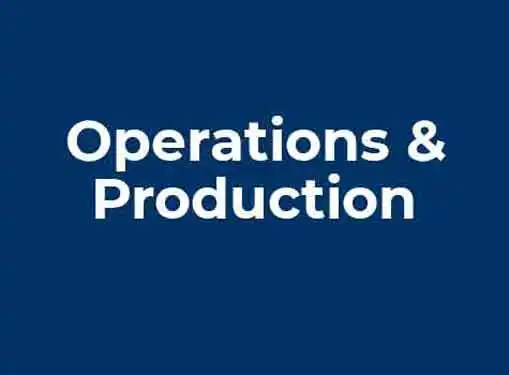
It is quite in order to sequence these fundamentals in terms of what the production involves, the resources available to accomplish this, the actual process, and finally the activities that will ensue after production is done.
Begin by describing the production process in detail. Here you should provide information on the various stages of production and how materials will be moved from one stage to the next. Describe the different technologies that will be employed in this process and what the various inherent advantages and disadvantages are. Indicate all the production ingredients that will be outsourced, from whom they will be outsourced and at what cost. Finally you should indicate what the other production costs are.
Next, the operations and production chapter of a business plan should provide details about the equipment to be used . After listing all the equipment you should describe its condition and ownership status i.e. is it wholly owned or partially owed. Describe the unavailable equipment you'll need to purchase, the source and the anticipated cost.
Move on to the aspects of labor where you should start by describing the quantity and nature of employees at your disposal i.e. are they permanent or casual workers and do they earn salaries or wages etc. Describe the desired qualifications for each aspect of production. Give details on how these employees will be organized as they work and who will supervise them. It is also appropriate to indicate how long each shift will be and the number of these per week.
A description of the capacity should also feature in the operations and production chapter of a business plan. Here you are meant to describe the quantity of production that your current/planned facilities can churn out in a given timeframe and the amount of labor that is required to meet this output. Make suggestions as to how capacity can be increased and on how excess capacity can be utilized.
Issues of quality control should also be addressed in this chapter. You should indicate who will be in charge of quality control and what the defined standards of quality are. Details about every quality control check performed from the start to the end of the production process should be provided. You should also describe how the employees will be motivated to ensure that quality is upheld and how feedback on the quality of the product will be collected from the end-users or consumers.
In the operations and production chapter of a business plan details about inventory control measures to be employed should be provided. The person responsible should be identified as should the maximum and minimum levels of inventory. Further, the minimum and maximum times for inventory receipt from suppliers, goods/service production, and delivery to consumers should be indicated. A description of the information system to be used for inventory management is required. Equally important are descriptions of the procedures that will be implemented to address inventory issues like storage requirements, damage and theft.
Samuel Muriithi is a business owner in Nairobi, Kenya. He has extensive international business experience in the United States and India.
Share this article
Additional Resources for Entrepreneurs
Lists of Venture Capital and Private Equity Firms Franchise Opportunities Contributors Business Glossary
Conversation Board
We greatly appreciate any advice you can provide on this topic. Please contribute your insights on this topic so others can benefit.
Leave a Reply
Questions, Comments, Tips, and Advice
Problem Viewing Image? Load New Code
Related Articles
Want to learn more about this topic? If so, you will enjoy these articles:

Completely Pain Free Business Planning - In 10 Steps - Part One
Going in blind when it comes to writing up a business plan can lead even the most stoic of people to lose heart. Approaching the tasks methodically can make it pain free. A bit like that old adage about how to eat an...

The Fine Essences of Writing a Business Plan
Writing a business plan is a fundamental requirement by many potential investors. As a potential or established business owner do you know all what is included in this blueprint and how these contents are ordered and articulated?
- Terms of Use
- Privacy Policy
- Franchise Directory
- Entrepreneurial Resources
- Small Business News
- Gaebler France
- Gaebler Mexico
- Gaebler Philippines
- Gaebler Czech Republic
- Gaebler Germany
- Gaebler China
Copyright © 2001-2024. Gaebler Ventures. All rights reserved.
- Sources of Business Finance
- Small Business Loans
- Small Business Grants
- Crowdfunding Sites
- How to Get a Business Loan
- Small Business Insurance Providers
- Best Factoring Companies
- Types of Bank Accounts
- Best Banks for Small Business
- Best Business Bank Accounts
- Open a Business Bank Account
- Bank Accounts for Small Businesses
- Free Business Checking Accounts
- Best Business Credit Cards
- Get a Business Credit Card
- Business Credit Cards for Bad Credit
- Build Business Credit Fast
- Business Loan Eligibility Criteria
- Small-Business Bookkeeping Basics
- How to Set Financial Goals
- Business Loan Calculators
- How to Calculate ROI
- Calculate Net Income
- Calculate Working Capital
- Calculate Operating Income
- Calculate Net Present Value (NPV)
- Calculate Payroll Tax
12 Key Elements of a Business Plan (Top Components Explained)
Starting and running a successful business requires proper planning and execution of effective business tactics and strategies .
You need to prepare many essential business documents when starting a business for maximum success; the business plan is one such document.
When creating a business, you want to achieve business objectives and financial goals like productivity, profitability, and business growth. You need an effective business plan to help you get to your desired business destination.
Even if you are already running a business, the proper understanding and review of the key elements of a business plan help you navigate potential crises and obstacles.
This article will teach you why the business document is at the core of any successful business and its key elements you can not avoid.
Let’s get started.
Why Are Business Plans Important?
Business plans are practical steps or guidelines that usually outline what companies need to do to reach their goals. They are essential documents for any business wanting to grow and thrive in a highly-competitive business environment .
1. Proves Your Business Viability
A business plan gives companies an idea of how viable they are and what actions they need to take to grow and reach their financial targets. With a well-written and clearly defined business plan, your business is better positioned to meet its goals.
2. Guides You Throughout the Business Cycle
A business plan is not just important at the start of a business. As a business owner, you must draw up a business plan to remain relevant throughout the business cycle .
During the starting phase of your business, a business plan helps bring your ideas into reality. A solid business plan can secure funding from lenders and investors.
After successfully setting up your business, the next phase is management. Your business plan still has a role to play in this phase, as it assists in communicating your business vision to employees and external partners.
Essentially, your business plan needs to be flexible enough to adapt to changes in the needs of your business.
3. Helps You Make Better Business Decisions
As a business owner, you are involved in an endless decision-making cycle. Your business plan helps you find answers to your most crucial business decisions.
A robust business plan helps you settle your major business components before you launch your product, such as your marketing and sales strategy and competitive advantage.
4. Eliminates Big Mistakes
Many small businesses fail within their first five years for several reasons: lack of financing, stiff competition, low market need, inadequate teams, and inefficient pricing strategy.
Creating an effective plan helps you eliminate these big mistakes that lead to businesses' decline. Every business plan element is crucial for helping you avoid potential mistakes before they happen.
5. Secures Financing and Attracts Top Talents
Having an effective plan increases your chances of securing business loans. One of the essential requirements many lenders ask for to grant your loan request is your business plan.
A business plan helps investors feel confident that your business can attract a significant return on investments ( ROI ).
You can attract and retain top-quality talents with a clear business plan. It inspires your employees and keeps them aligned to achieve your strategic business goals.
Key Elements of Business Plan
Starting and running a successful business requires well-laid actions and supporting documents that better position a company to achieve its business goals and maximize success.
A business plan is a written document with relevant information detailing business objectives and how it intends to achieve its goals.
With an effective business plan, investors, lenders, and potential partners understand your organizational structure and goals, usually around profitability, productivity, and growth.
Every successful business plan is made up of key components that help solidify the efficacy of the business plan in delivering on what it was created to do.
Here are some of the components of an effective business plan.
1. Executive Summary
One of the key elements of a business plan is the executive summary. Write the executive summary as part of the concluding topics in the business plan. Creating an executive summary with all the facts and information available is easier.
In the overall business plan document, the executive summary should be at the forefront of the business plan. It helps set the tone for readers on what to expect from the business plan.
A well-written executive summary includes all vital information about the organization's operations, making it easy for a reader to understand.
The key points that need to be acted upon are highlighted in the executive summary. They should be well spelled out to make decisions easy for the management team.
A good and compelling executive summary points out a company's mission statement and a brief description of its products and services.

An executive summary summarizes a business's expected value proposition to distinct customer segments. It highlights the other key elements to be discussed during the rest of the business plan.
Including your prior experiences as an entrepreneur is a good idea in drawing up an executive summary for your business. A brief but detailed explanation of why you decided to start the business in the first place is essential.
Adding your company's mission statement in your executive summary cannot be overemphasized. It creates a culture that defines how employees and all individuals associated with your company abide when carrying out its related processes and operations.
Your executive summary should be brief and detailed to catch readers' attention and encourage them to learn more about your company.
Components of an Executive Summary
Here are some of the information that makes up an executive summary:
- The name and location of your company
- Products and services offered by your company
- Mission and vision statements
- Success factors of your business plan
2. Business Description
Your business description needs to be exciting and captivating as it is the formal introduction a reader gets about your company.
What your company aims to provide, its products and services, goals and objectives, target audience , and potential customers it plans to serve need to be highlighted in your business description.
A company description helps point out notable qualities that make your company stand out from other businesses in the industry. It details its unique strengths and the competitive advantages that give it an edge to succeed over its direct and indirect competitors.
Spell out how your business aims to deliver on the particular needs and wants of identified customers in your company description, as well as the particular industry and target market of the particular focus of the company.
Include trends and significant competitors within your particular industry in your company description. Your business description should contain what sets your company apart from other businesses and provides it with the needed competitive advantage.
In essence, if there is any area in your business plan where you need to brag about your business, your company description provides that unique opportunity as readers look to get a high-level overview.
Components of a Business Description
Your business description needs to contain these categories of information.
- Business location
- The legal structure of your business
- Summary of your business’s short and long-term goals
3. Market Analysis
The market analysis section should be solely based on analytical research as it details trends particular to the market you want to penetrate.
Graphs, spreadsheets, and histograms are handy data and statistical tools you need to utilize in your market analysis. They make it easy to understand the relationship between your current ideas and the future goals you have for the business.
All details about the target customers you plan to sell products or services should be in the market analysis section. It helps readers with a helpful overview of the market.
In your market analysis, you provide the needed data and statistics about industry and market share, the identified strengths in your company description, and compare them against other businesses in the same industry.
The market analysis section aims to define your target audience and estimate how your product or service would fare with these identified audiences.

Market analysis helps visualize a target market by researching and identifying the primary target audience of your company and detailing steps and plans based on your audience location.
Obtaining this information through market research is essential as it helps shape how your business achieves its short-term and long-term goals.
Market Analysis Factors
Here are some of the factors to be included in your market analysis.
- The geographical location of your target market
- Needs of your target market and how your products and services can meet those needs
- Demographics of your target audience
Components of the Market Analysis Section
Here is some of the information to be included in your market analysis.
- Industry description and statistics
- Demographics and profile of target customers
- Marketing data for your products and services
- Detailed evaluation of your competitors
4. Marketing Plan
A marketing plan defines how your business aims to reach its target customers, generate sales leads, and, ultimately, make sales.
Promotion is at the center of any successful marketing plan. It is a series of steps to pitch a product or service to a larger audience to generate engagement. Note that the marketing strategy for a business should not be stagnant and must evolve depending on its outcome.
Include the budgetary requirement for successfully implementing your marketing plan in this section to make it easy for readers to measure your marketing plan's impact in terms of numbers.
The information to include in your marketing plan includes marketing and promotion strategies, pricing plans and strategies , and sales proposals. You need to include how you intend to get customers to return and make repeat purchases in your business plan.

5. Sales Strategy
Sales strategy defines how you intend to get your product or service to your target customers and works hand in hand with your business marketing strategy.
Your sales strategy approach should not be complex. Break it down into simple and understandable steps to promote your product or service to target customers.
Apart from the steps to promote your product or service, define the budget you need to implement your sales strategies and the number of sales reps needed to help the business assist in direct sales.
Your sales strategy should be specific on what you need and how you intend to deliver on your sales targets, where numbers are reflected to make it easier for readers to understand and relate better.

6. Competitive Analysis
Providing transparent and honest information, even with direct and indirect competitors, defines a good business plan. Provide the reader with a clear picture of your rank against major competitors.
Identifying your competitors' weaknesses and strengths is useful in drawing up a market analysis. It is one information investors look out for when assessing business plans.

The competitive analysis section clearly defines the notable differences between your company and your competitors as measured against their strengths and weaknesses.
This section should define the following:
- Your competitors' identified advantages in the market
- How do you plan to set up your company to challenge your competitors’ advantage and gain grounds from them?
- The standout qualities that distinguish you from other companies
- Potential bottlenecks you have identified that have plagued competitors in the same industry and how you intend to overcome these bottlenecks
In your business plan, you need to prove your industry knowledge to anyone who reads your business plan. The competitive analysis section is designed for that purpose.
7. Management and Organization
Management and organization are key components of a business plan. They define its structure and how it is positioned to run.
Whether you intend to run a sole proprietorship, general or limited partnership, or corporation, the legal structure of your business needs to be clearly defined in your business plan.
Use an organizational chart that illustrates the hierarchy of operations of your company and spells out separate departments and their roles and functions in this business plan section.
The management and organization section includes profiles of advisors, board of directors, and executive team members and their roles and responsibilities in guaranteeing the company's success.
Apparent factors that influence your company's corporate culture, such as human resources requirements and legal structure, should be well defined in the management and organization section.
Defining the business's chain of command if you are not a sole proprietor is necessary. It leaves room for little or no confusion about who is in charge or responsible during business operations.
This section provides relevant information on how the management team intends to help employees maximize their strengths and address their identified weaknesses to help all quarters improve for the business's success.
8. Products and Services
This business plan section describes what a company has to offer regarding products and services to the maximum benefit and satisfaction of its target market.
Boldly spell out pending patents or copyright products and intellectual property in this section alongside costs, expected sales revenue, research and development, and competitors' advantage as an overview.
At this stage of your business plan, the reader needs to know what your business plans to produce and sell and the benefits these products offer in meeting customers' needs.
The supply network of your business product, production costs, and how you intend to sell the products are crucial components of the products and services section.
Investors are always keen on this information to help them reach a balanced assessment of if investing in your business is risky or offer benefits to them.
You need to create a link in this section on how your products or services are designed to meet the market's needs and how you intend to keep those customers and carve out a market share for your company.
Repeat purchases are the backing that a successful business relies on and measure how much customers are into what your company is offering.
This section is more like an expansion of the executive summary section. You need to analyze each product or service under the business.
9. Operating Plan
An operations plan describes how you plan to carry out your business operations and processes.
The operating plan for your business should include:
- Information about how your company plans to carry out its operations.
- The base location from which your company intends to operate.
- The number of employees to be utilized and other information about your company's operations.
- Key business processes.
This section should highlight how your organization is set up to run. You can also introduce your company's management team in this section, alongside their skills, roles, and responsibilities in the company.
The best way to introduce the company team is by drawing up an organizational chart that effectively maps out an organization's rank and chain of command.
What should be spelled out to readers when they come across this business plan section is how the business plans to operate day-in and day-out successfully.
10. Financial Projections and Assumptions
Bringing your great business ideas into reality is why business plans are important. They help create a sustainable and viable business.
The financial section of your business plan offers significant value. A business uses a financial plan to solve all its financial concerns, which usually involves startup costs, labor expenses, financial projections, and funding and investor pitches.
All key assumptions about the business finances need to be listed alongside the business financial projection, and changes to be made on the assumptions side until it balances with the projection for the business.
The financial plan should also include how the business plans to generate income and the capital expenditure budgets that tend to eat into the budget to arrive at an accurate cash flow projection for the business.
Base your financial goals and expectations on extensive market research backed with relevant financial statements for the relevant period.
Examples of financial statements you can include in the financial projections and assumptions section of your business plan include:
- Projected income statements
- Cash flow statements
- Balance sheets
- Income statements
Revealing the financial goals and potentials of the business is what the financial projection and assumption section of your business plan is all about. It needs to be purely based on facts that can be measurable and attainable.
11. Request For Funding
The request for funding section focuses on the amount of money needed to set up your business and underlying plans for raising the money required. This section includes plans for utilizing the funds for your business's operational and manufacturing processes.
When seeking funding, a reasonable timeline is required alongside it. If the need arises for additional funding to complete other business-related projects, you are not left scampering and desperate for funds.
If you do not have the funds to start up your business, then you should devote a whole section of your business plan to explaining the amount of money you need and how you plan to utilize every penny of the funds. You need to explain it in detail for a future funding request.
When an investor picks up your business plan to analyze it, with all your plans for the funds well spelled out, they are motivated to invest as they have gotten a backing guarantee from your funding request section.
Include timelines and plans for how you intend to repay the loans received in your funding request section. This addition keeps investors assured that they could recoup their investment in the business.
12. Exhibits and Appendices
Exhibits and appendices comprise the final section of your business plan and contain all supporting documents for other sections of the business plan.
Some of the documents that comprise the exhibits and appendices section includes:
- Legal documents
- Licenses and permits
- Credit histories
- Customer lists
The choice of what additional document to include in your business plan to support your statements depends mainly on the intended audience of your business plan. Hence, it is better to play it safe and not leave anything out when drawing up the appendix and exhibit section.
Supporting documentation is particularly helpful when you need funding or support for your business. This section provides investors with a clearer understanding of the research that backs the claims made in your business plan.
There are key points to include in the appendix and exhibits section of your business plan.
- The management team and other stakeholders resume
- Marketing research
- Permits and relevant legal documents
- Financial documents
Was This Article Helpful?
Martin luenendonk.
Martin loves entrepreneurship and has helped dozens of entrepreneurs by validating the business idea, finding scalable customer acquisition channels, and building a data-driven organization. During his time working in investment banking, tech startups, and industry-leading companies he gained extensive knowledge in using different software tools to optimize business processes.
This insights and his love for researching SaaS products enables him to provide in-depth, fact-based software reviews to enable software buyers make better decisions.
Business Plan Example and Template
Learn how to create a business plan
What is a Business Plan?
A business plan is a document that contains the operational and financial plan of a business, and details how its objectives will be achieved. It serves as a road map for the business and can be used when pitching investors or financial institutions for debt or equity financing .

A business plan should follow a standard format and contain all the important business plan elements. Typically, it should present whatever information an investor or financial institution expects to see before providing financing to a business.
Contents of a Business Plan
A business plan should be structured in a way that it contains all the important information that investors are looking for. Here are the main sections of a business plan:
1. Title Page
The title page captures the legal information of the business, which includes the registered business name, physical address, phone number, email address, date, and the company logo.
2. Executive Summary
The executive summary is the most important section because it is the first section that investors and bankers see when they open the business plan. It provides a summary of the entire business plan. It should be written last to ensure that you don’t leave any details out. It must be short and to the point, and it should capture the reader’s attention. The executive summary should not exceed two pages.
3. Industry Overview
The industry overview section provides information about the specific industry that the business operates in. Some of the information provided in this section includes major competitors, industry trends, and estimated revenues. It also shows the company’s position in the industry and how it will compete in the market against other major players.
4. Market Analysis and Competition
The market analysis section details the target market for the company’s product offerings. This section confirms that the company understands the market and that it has already analyzed the existing market to determine that there is adequate demand to support its proposed business model.
Market analysis includes information about the target market’s demographics , geographical location, consumer behavior, and market needs. The company can present numbers and sources to give an overview of the target market size.
A business can choose to consolidate the market analysis and competition analysis into one section or present them as two separate sections.
5. Sales and Marketing Plan
The sales and marketing plan details how the company plans to sell its products to the target market. It attempts to present the business’s unique selling proposition and the channels it will use to sell its goods and services. It details the company’s advertising and promotion activities, pricing strategy, sales and distribution methods, and after-sales support.
6. Management Plan
The management plan provides an outline of the company’s legal structure, its management team, and internal and external human resource requirements. It should list the number of employees that will be needed and the remuneration to be paid to each of the employees.
Any external professionals, such as lawyers, valuers, architects, and consultants, that the company will need should also be included. If the company intends to use the business plan to source funding from investors, it should list the members of the executive team, as well as the members of the advisory board.
7. Operating Plan
The operating plan provides an overview of the company’s physical requirements, such as office space, machinery, labor, supplies, and inventory . For a business that requires custom warehouses and specialized equipment, the operating plan will be more detailed, as compared to, say, a home-based consulting business. If the business plan is for a manufacturing company, it will include information on raw material requirements and the supply chain.
8. Financial Plan
The financial plan is an important section that will often determine whether the business will obtain required financing from financial institutions, investors, or venture capitalists. It should demonstrate that the proposed business is viable and will return enough revenues to be able to meet its financial obligations. Some of the information contained in the financial plan includes a projected income statement , balance sheet, and cash flow.
9. Appendices and Exhibits
The appendices and exhibits part is the last section of a business plan. It includes any additional information that banks and investors may be interested in or that adds credibility to the business. Some of the information that may be included in the appendices section includes office/building plans, detailed market research , products/services offering information, marketing brochures, and credit histories of the promoters.

Business Plan Template
Here is a basic template that any business can use when developing its business plan:
Section 1: Executive Summary
- Present the company’s mission.
- Describe the company’s product and/or service offerings.
- Give a summary of the target market and its demographics.
- Summarize the industry competition and how the company will capture a share of the available market.
- Give a summary of the operational plan, such as inventory, office and labor, and equipment requirements.
Section 2: Industry Overview
- Describe the company’s position in the industry.
- Describe the existing competition and the major players in the industry.
- Provide information about the industry that the business will operate in, estimated revenues, industry trends, government influences, as well as the demographics of the target market.
Section 3: Market Analysis and Competition
- Define your target market, their needs, and their geographical location.
- Describe the size of the market, the units of the company’s products that potential customers may buy, and the market changes that may occur due to overall economic changes.
- Give an overview of the estimated sales volume vis-à-vis what competitors sell.
- Give a plan on how the company plans to combat the existing competition to gain and retain market share.
Section 4: Sales and Marketing Plan
- Describe the products that the company will offer for sale and its unique selling proposition.
- List the different advertising platforms that the business will use to get its message to customers.
- Describe how the business plans to price its products in a way that allows it to make a profit.
- Give details on how the company’s products will be distributed to the target market and the shipping method.
Section 5: Management Plan
- Describe the organizational structure of the company.
- List the owners of the company and their ownership percentages.
- List the key executives, their roles, and remuneration.
- List any internal and external professionals that the company plans to hire, and how they will be compensated.
- Include a list of the members of the advisory board, if available.
Section 6: Operating Plan
- Describe the location of the business, including office and warehouse requirements.
- Describe the labor requirement of the company. Outline the number of staff that the company needs, their roles, skills training needed, and employee tenures (full-time or part-time).
- Describe the manufacturing process, and the time it will take to produce one unit of a product.
- Describe the equipment and machinery requirements, and if the company will lease or purchase equipment and machinery, and the related costs that the company estimates it will incur.
- Provide a list of raw material requirements, how they will be sourced, and the main suppliers that will supply the required inputs.
Section 7: Financial Plan
- Describe the financial projections of the company, by including the projected income statement, projected cash flow statement, and the balance sheet projection.
Section 8: Appendices and Exhibits
- Quotes of building and machinery leases
- Proposed office and warehouse plan
- Market research and a summary of the target market
- Credit information of the owners
- List of product and/or services
Related Readings
Thank you for reading CFI’s guide to Business Plans. To keep learning and advancing your career, the following CFI resources will be helpful:
- Corporate Structure
- Three Financial Statements
- Business Model Canvas Examples
- See all management & strategy resources
- Share this article

Create a free account to unlock this Template
Access and download collection of free Templates to help power your productivity and performance.
Already have an account? Log in
Supercharge your skills with Premium Templates
Take your learning and productivity to the next level with our Premium Templates.
Upgrading to a paid membership gives you access to our extensive collection of plug-and-play Templates designed to power your performance—as well as CFI's full course catalog and accredited Certification Programs.
Already have a Self-Study or Full-Immersion membership? Log in
Access Exclusive Templates
Gain unlimited access to more than 250 productivity Templates, CFI's full course catalog and accredited Certification Programs, hundreds of resources, expert reviews and support, the chance to work with real-world finance and research tools, and more.
Already have a Full-Immersion membership? Log in
- Search Search Please fill out this field.
What Is a Business Plan?
Understanding business plans, how to write a business plan, common elements of a business plan, how often should a business plan be updated, the bottom line, business plan: what it is, what's included, and how to write one.
Adam Hayes, Ph.D., CFA, is a financial writer with 15+ years Wall Street experience as a derivatives trader. Besides his extensive derivative trading expertise, Adam is an expert in economics and behavioral finance. Adam received his master's in economics from The New School for Social Research and his Ph.D. from the University of Wisconsin-Madison in sociology. He is a CFA charterholder as well as holding FINRA Series 7, 55 & 63 licenses. He currently researches and teaches economic sociology and the social studies of finance at the Hebrew University in Jerusalem.
:max_bytes(150000):strip_icc():format(webp)/adam_hayes-5bfc262a46e0fb005118b414.jpg)
- How to Start a Business: A Comprehensive Guide and Essential Steps
- How to Do Market Research, Types, and Example
- Marketing Strategy: What It Is, How It Works, How To Create One
- Marketing in Business: Strategies and Types Explained
- What Is a Marketing Plan? Types and How to Write One
- Business Development: Definition, Strategies, Steps & Skills
- Business Plan: What It Is, What's Included, and How to Write One CURRENT ARTICLE
- Small Business Development Center (SBDC): Meaning, Types, Impact
- How to Write a Business Plan for a Loan
- Business Startup Costs: It’s in the Details
- Startup Capital Definition, Types, and Risks
- Bootstrapping Definition, Strategies, and Pros/Cons
- Crowdfunding: What It Is, How It Works, and Popular Websites
- Starting a Business with No Money: How to Begin
- A Comprehensive Guide to Establishing Business Credit
- Equity Financing: What It Is, How It Works, Pros and Cons
- Best Startup Business Loans
- Sole Proprietorship: What It Is, Pros & Cons, and Differences From an LLC
- Partnership: Definition, How It Works, Taxation, and Types
- What is an LLC? Limited Liability Company Structure and Benefits Defined
- Corporation: What It Is and How to Form One
- Starting a Small Business: Your Complete How-to Guide
- Starting an Online Business: A Step-by-Step Guide
- How to Start Your Own Bookkeeping Business: Essential Tips
- How to Start a Successful Dropshipping Business: A Comprehensive Guide
A business plan is a document that details a company's goals and how it intends to achieve them. Business plans can be of benefit to both startups and well-established companies. For startups, a business plan can be essential for winning over potential lenders and investors. Established businesses can find one useful for staying on track and not losing sight of their goals. This article explains what an effective business plan needs to include and how to write one.
Key Takeaways
- A business plan is a document describing a company's business activities and how it plans to achieve its goals.
- Startup companies use business plans to get off the ground and attract outside investors.
- For established companies, a business plan can help keep the executive team focused on and working toward the company's short- and long-term objectives.
- There is no single format that a business plan must follow, but there are certain key elements that most companies will want to include.
Investopedia / Ryan Oakley
Any new business should have a business plan in place prior to beginning operations. In fact, banks and venture capital firms often want to see a business plan before they'll consider making a loan or providing capital to new businesses.
Even if a business isn't looking to raise additional money, a business plan can help it focus on its goals. A 2017 Harvard Business Review article reported that, "Entrepreneurs who write formal plans are 16% more likely to achieve viability than the otherwise identical nonplanning entrepreneurs."
Ideally, a business plan should be reviewed and updated periodically to reflect any goals that have been achieved or that may have changed. An established business that has decided to move in a new direction might create an entirely new business plan for itself.
There are numerous benefits to creating (and sticking to) a well-conceived business plan. These include being able to think through ideas before investing too much money in them and highlighting any potential obstacles to success. A company might also share its business plan with trusted outsiders to get their objective feedback. In addition, a business plan can help keep a company's executive team on the same page about strategic action items and priorities.
Business plans, even among competitors in the same industry, are rarely identical. However, they often have some of the same basic elements, as we describe below.
While it's a good idea to provide as much detail as necessary, it's also important that a business plan be concise enough to hold a reader's attention to the end.
While there are any number of templates that you can use to write a business plan, it's best to try to avoid producing a generic-looking one. Let your plan reflect the unique personality of your business.
Many business plans use some combination of the sections below, with varying levels of detail, depending on the company.
The length of a business plan can vary greatly from business to business. Regardless, it's best to fit the basic information into a 15- to 25-page document. Other crucial elements that take up a lot of space—such as applications for patents—can be referenced in the main document and attached as appendices.
These are some of the most common elements in many business plans:
- Executive summary: This section introduces the company and includes its mission statement along with relevant information about the company's leadership, employees, operations, and locations.
- Products and services: Here, the company should describe the products and services it offers or plans to introduce. That might include details on pricing, product lifespan, and unique benefits to the consumer. Other factors that could go into this section include production and manufacturing processes, any relevant patents the company may have, as well as proprietary technology . Information about research and development (R&D) can also be included here.
- Market analysis: A company needs to have a good handle on the current state of its industry and the existing competition. This section should explain where the company fits in, what types of customers it plans to target, and how easy or difficult it may be to take market share from incumbents.
- Marketing strategy: This section can describe how the company plans to attract and keep customers, including any anticipated advertising and marketing campaigns. It should also describe the distribution channel or channels it will use to get its products or services to consumers.
- Financial plans and projections: Established businesses can include financial statements, balance sheets, and other relevant financial information. New businesses can provide financial targets and estimates for the first few years. Your plan might also include any funding requests you're making.
The best business plans aren't generic ones created from easily accessed templates. A company should aim to entice readers with a plan that demonstrates its uniqueness and potential for success.
2 Types of Business Plans
Business plans can take many forms, but they are sometimes divided into two basic categories: traditional and lean startup. According to the U.S. Small Business Administration (SBA) , the traditional business plan is the more common of the two.
- Traditional business plans : These plans tend to be much longer than lean startup plans and contain considerably more detail. As a result they require more work on the part of the business, but they can also be more persuasive (and reassuring) to potential investors.
- Lean startup business plans : These use an abbreviated structure that highlights key elements. These business plans are short—as short as one page—and provide only the most basic detail. If a company wants to use this kind of plan, it should be prepared to provide more detail if an investor or a lender requests it.
Why Do Business Plans Fail?
A business plan is not a surefire recipe for success. The plan may have been unrealistic in its assumptions and projections to begin with. Markets and the overall economy might change in ways that couldn't have been foreseen. A competitor might introduce a revolutionary new product or service. All of this calls for building some flexibility into your plan, so you can pivot to a new course if needed.
How frequently a business plan needs to be revised will depend on the nature of the business. A well-established business might want to review its plan once a year and make changes if necessary. A new or fast-growing business in a fiercely competitive market might want to revise it more often, such as quarterly.
What Does a Lean Startup Business Plan Include?
The lean startup business plan is an option when a company prefers to give a quick explanation of its business. For example, a brand-new company may feel that it doesn't have a lot of information to provide yet.
Sections can include: a value proposition ; the company's major activities and advantages; resources such as staff, intellectual property, and capital; a list of partnerships; customer segments; and revenue sources.
A business plan can be useful to companies of all kinds. But as a company grows and the world around it changes, so too should its business plan. So don't think of your business plan as carved in granite but as a living document designed to evolve with your business.
Harvard Business Review. " Research: Writing a Business Plan Makes Your Startup More Likely to Succeed ."
U.S. Small Business Administration. " Write Your Business Plan ."
:max_bytes(150000):strip_icc():format(webp)/GettyImages-1456193345-2cc8ef3d583f42d8a80c8e631c0b0556.jpg)
- Terms of Service
- Editorial Policy
- Privacy Policy
AI ASSISTANTS
Upmetrics AI Your go-to AI-powered business assistant
AI Writing Assist Write, translate, and refine your text with AI
AI Financial Assist Automated forecasts and AI recommendations
TOP FEATURES
AI Business Plan Generator Create business plans faster with AI
Financial Forecasting Make accurate financial forecasts faster
INTEGRATIONS
Quickbooks (Coming soon...) Sync and compare with your quickbooks data
Strategic Planning Develop actionable strategic plans on-the-go
AI Pitch Deck Generator Use AI to generate your investor deck
Xero Sync and compare with your Xero data
See how it works →
AI-powered business planning software
Very useful business plan software connected to AI. Saved a lot of time, money and energy. Their team is highly skilled and always here to help.
- Julien López
BY USE CASE
Secure Funding, Loans, Grants Create plans that get you funded
Starting & Launching a Business Plan your business for launch and success
Validate Your Business Idea Discover the potential of your business idea
E2 Visa Business Plan Create a business plan to support your E2 - Visa
Business Consultant & Advisors Plan with your team members and clients
Incubators & Accelerators Empowering startups for growth
Business Schools & Educators Simplify business plan education for students
Students & Learners Your e-tutor for business planning
- Sample Plans
WHY UPMETRICS?
Reviews See why customers love Upmetrics
Customer Success Stories Read our customer success stories
Blogs Latest business planning tips and strategies
Strategic Planning Templates Ready-to-use strategic plan templates
Business Plan Course A step-by-step business planning course
Help Center Help & guides to plan your business
Ebooks & Guides A free resource hub on business planning
Business Tools Free business tools to help you grow
How to Write an Operations Plan Section of your Business Plan

Free Operations Plan Template
Ayush Jalan
- December 14, 2023

Your business plan is an elaborate set of instructions stating how to run your business to achieve objectives and goals. Each section describes a part of the process of reaching your desired goal. Similarly, the operations plan section of your business plan explains the production and supply of your product.
An operations plan is formed to turn plans into actions. It uses the information you gathered from the analysis of the market , customers, and competitors mentioned in the previous parts of your business plan and allows for the execution of relevant strategies to achieve desired results.
What Is an Operations Plan?
An operations plan is an in-depth description of your daily business activities centered on achieving the goals and objectives described in the previous sections of your business plan. It outlines the processes, activities, responsibilities of various departments and the timeframe of the execution.
The operations section of your business plan explains in detail the role of a team or department in the collective accomplishment of your goals. In other words, it’s a strategic allocation of physical, financial, and human resources toward reaching milestones within a specific timeframe.
A well-defined operational plan section of your business plan should be able to answer the following questions:
- Who is responsible for a specific task or department?
- What are the tasks that need to be completed?
- Where will these operations take place?
- When should the tasks be completed? What are the deadlines?
- How will the tasks be performed? Is there a standard procedure?
- How much is it going to cost to complete these tasks?
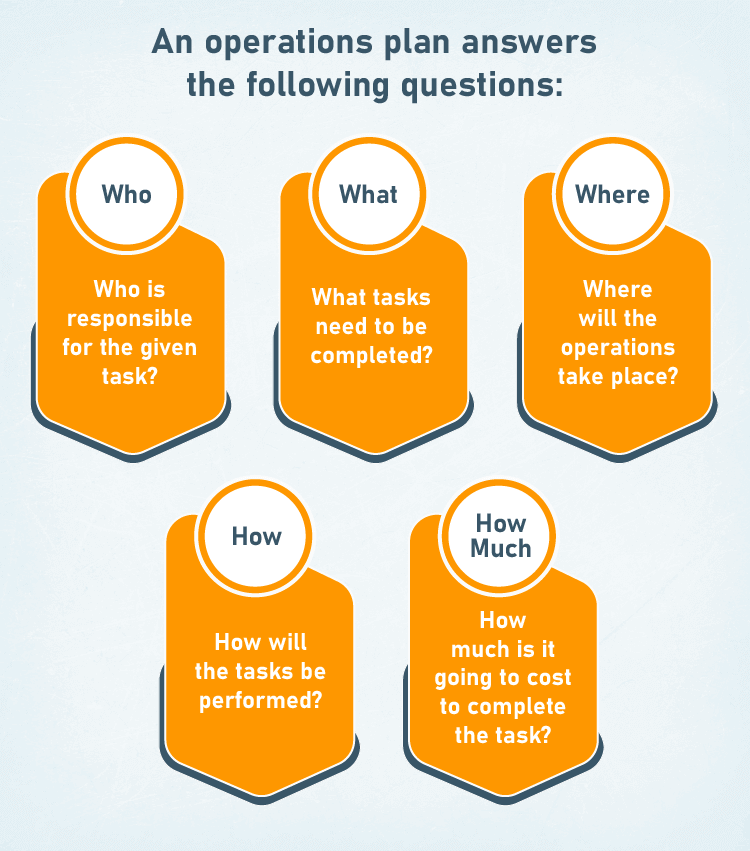
How to Write an Operations Plan Section?
Creating an operational plan has two major stages, both addressing different aspects of your company. The first stage includes the work that has been done so far, whereas the second stage describes it in detail.
1. Development Phase

In this stage, you mention what you’ve done to get your business operations up and running. Explain what you aim to change and improvise in the processes. These are the elements your development section will contain:
Production workflow
: Explain all the steps involved in creating your product. This should be a highly informative, elaborate description of the steps. Here, you also mention any inefficiencies that exist and talk about the actions that need to be taken to tackle them.
Supply chains
Quality control, 2. manufacturing phase.

The development stage acquaints the reader with the functioning of your business, while the manufacturing stage describes the day-to-day operation.
This includes the following elements:
Outline of daily activities:
Tools and equipment:, special requirements:, raw materials:, productions:, feasibility:, why do you need an operations plan.
An operations plan is essentially an instruction manual about the workings of your business. It offers insight into your business operations. It helps investors assess your credibility and understand the structure of your operations and predict your financial requirements.
An operations plan reflects the real-time application of a business plan.
Internally, an operations plan works as a guide, which helps your employees and managers to know their responsibilities. It also helps them understand how to execute their tasks in the desired manner—all whilst keeping account of deadlines.
The operations plan helps identify and cut the variances between planned and actual performance and makes necessary changes. It helps you visualize how your operations affect revenue and gives you an idea of how and when you need to implement new strategies to maximize profits.
Advantages of Preparing an Operations Plan:
- Offers Clarity: Operational planning, among other things, makes sure that everyone in the audience and team are aware of the daily, weekly, and monthly work. It improves concentration and productivity.
- Contains A Roadmap: Operational planning makes it much easier to reach long-term objectives. When members have a clear strategy to follow: productivity rises, and accountability is maintained.
- Sets A Benchmark: It sets a clear goal for everyone about what is the destination of the company and how to reach there.
Operations Plan Essentials
Now that you have understood the contents of an operations plan and how it should be written, you can continue drafting one for your business plan. But before doing so, take a look at these key components you need to remember while creating your operational plan.
- Your operations plan is fundamentally a medium for implementing your strategic plan. Hence, it’s crucial to have a solid strategic plan to write an effective operations plan.
- Focus on setting SMART goals and prioritizing the most important ones. This helps you create a clear and crisp operations plan. Focusing on multiple goals will make your plan complicated and hard to implement.
- To measure your goals, use leading indicators instead of lagging indicators. Leading indicators is a metric that helps you track your progress and predict when you will reach a goal. On the other hand, lagging indicators can only confirm a trend by taking the past as input but cannot predict the accomplishment of a goal.
- It is essential to choose the right Key Performance Indicators (KPIs) . It is a good practice to involve all your teams while you decide your KPIs.
- An operations plan should effectively communicate your goals, metrics, deadlines, and all the processes.
Now you’re all set to write an operations plan section for your business plan. To give you a headstart, we have created an operations plan example.
Operations Plan Example
Operations plan by a book publishing house
| Goal | Strategy | Actions | Responsibility | Deadlines |
|---|---|---|---|---|
| Save capital spent on the raw materials for book pages | Cost reduction | Negotiate with the raw materials supplier to reduce the price | Sean Davis | February 2022 |
| Increase the number of books proofread by 10% | Improve productivity | 1. Distribute manuscripts among all the editors to avoid burden on some. 2. Hire new editors to increase productivity. | Rebecca Brown | December 2021 |
| Improve cover page quality | Enhance quality | Repair (if not replace) the faulty machine that prints the covers of the books | Luke Williams | September 2021 |
Track and Accomplish Goals With an Operations Plan
Drafting the operations plan section of your business plan can be tricky due to the uncertainties of the business environment and the risks associated with it. Depending on variables like your market analysis, product development, supply chain, etc., the complexity of writing an operations plan will vary.
The core purpose here is to put all the pieces together to create a synergy effect and get the engine of your business running. Create an effective operations plan to convey competence to investors and clarity to employees.
Build your Business Plan Faster
with step-by-step Guidance & AI Assistance.
Frequently Asked Questions
What role does the operations plan play in securing funding for a business.
The operations plan defines the clear goals of your business and what actions will be taken on a daily basis to reach them. So, investors need to know where your business stands, and it will prove the viability of the goals helping you in getting funded.
What are the factors affecting the operations plan?
- The mission of the company
- Goals to be achieved
- Finance and resources your company will need
Can an operations plan be created for both start-up and established businesses?
Yes, both a startup and a small business needs an operations plan to get a better idea of the roadmap they want for their business.
About the Author

Ayush is a writer with an academic background in business and marketing. Being a tech-enthusiast, he likes to keep a sharp eye on the latest tech gadgets and innovations. When he's not working, you can find him writing poetry, gaming, playing the ukulele, catching up with friends, and indulging in creative philosophies.
Related Articles

How to Write an Effective Company Overview for Your Business Plan

How to Write a Business Plan: 10 Easy Steps + Examples

How to Prepare a Financial Plan for Startup Business (w/ example)
Reach your goals with accurate planning.
No Risk – Cancel at Any Time – 15 Day Money Back Guarantee
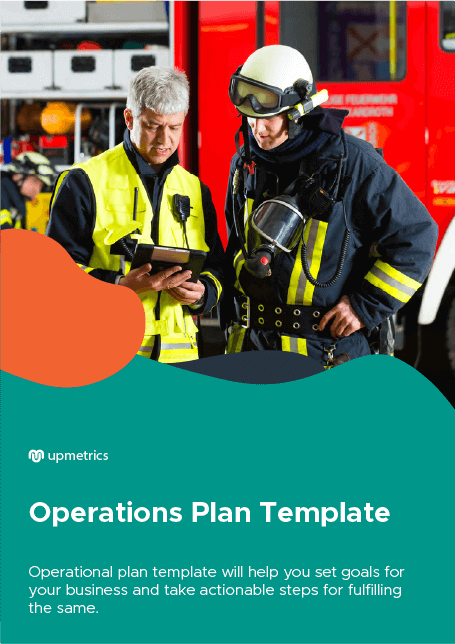
An Ultimate Guide for Better Operations
- Operates towards success
- Describe business milestones
- Plan such as financials, budget planning
- Turn your goals into an actionable plan
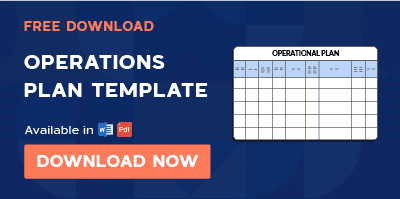
Chapter 12: Managing Processes
Production planning.

Learning Outcomes
- Explain facility location
- Explain facility layout
- Explain materials-requirement planning (MRP)
- Explain just-in-time inventory control (JIT)
- Differentiate between Gantt charts, PERT, and the critical path method
Components of Production Planning
Introduction.
All this production doesn’t happen by magic. Much of an operation manager’s time is spent planning the production process. Think about hosting a large party for your parents’ anniversary. The first thing you have to do is find a location that is large enough to accommodate all the people you will be inviting. Once you have identified the location, you then need to visit the site and decide how it will be laid out. Where should the tables and chairs go, where will you set up refreshments, and what about a gift table? Once you’ve decided on the layout, then you need to start making a list of the materials you’ll need for the party. This includes everything from plates, cups, and napkins to hiring a DJ and a caterer. Lastly, based on the number of guests, you’ll need to calculate how much of everything—food, drinks, etc.—to order.
Operations managers engage in similar planning, but they use different terminology to describe the different parts of the plan. In production planning, the components are facility location, facility layout, materials-requirement planning (MRP), and inventory control.
Facility Location
Of all the pieces of the planning puzzle, facility location is the most strategic and critical. Once you build a new manufacturing facility, you have made a substantial investment of time, resources, and capital that can’t be changed for a long time. Selecting the wrong location can be disastrous. Some of the key factors that influence facility location are the following:
- Proximity to customers, suppliers, and skilled labor
- Environmental regulations
- Financial incentives offered by state and local development authorities
- Quality-of-life considerations
- Potential for future expansion
The next step, after planning the production process, is deciding on plant layout—how equipment, machinery, and people will be arranged to make the production process as efficient as possible.
Facility Layout
The primary aim of facility layout is to design a workflow that maximizes worker and production efficiency. Facility layout is complex because it must take into account the available space, the work processes, the delivery of components and parts, the final product, worker safety, and operational efficiency. A poorly laid-out production facility creates inefficiencies, increases costs, and leads to employee frustration and confusion.
The four most common types of facility layout are process, product, cellular, and fixed position.
Process Layout
A process layout aims to improve efficiency by arranging equipment according to its function. Ideally, the production line should be designed to eliminate waste in material flows, inventory handling, and management. In process layout, the work stations and machinery are not arranged according to the production sequence. Instead, there is an assembly of similar operations or similar machinery in each department (for example, a drill department, a paint department, etc.)
Product Layout
In a product layout , high-volume goods are produced efficiently by people, equipment, or departments arranged in an assembly line—that is, a series of workstations at which already-made parts are assembled.
In the following video, Jansen, a Swiss steel maker, describes how the company’s offices were designed to maximize the productivity and creativity of its engineers:
Cellular Layout
A cellular layout is a lean method of producing similar products using cells, or groups of team members, workstations, or equipment, to facilitate operations by eliminating set-up and unnecessary costs between operations. Cells might be designed for a specific process, part, or a complete product. The goal of cellular manufacturing is to move as quickly as possible and make a wide variety of similar products with as little waste as possible. This type of layout is well suited for single-piece and one-touch production methods. Because of increased speed and minimal handling of materials, cells can result in great cost and time savings and reduced inventory.
Fixed Position
It is easy to move marshmallow candies around the factory while you are making them, but what about airplanes or ships? For the production of large items, manufacturers use fixed-position layout in which the product stays in one place and the workers (and equipment) go to the product. To see an excellent example of fixed-position layout, watch the following video that shows how Boeing builds an airplane.
After the facility location has been selected and the best layout has been determined, the next stage in production planning is to determine our material requirements.
Material-Requirements Planning (MRP)
Material-requirements planning (MRP) is a production planning, scheduling, and inventory control system used to manage manufacturing processes. Most MRP systems are software-based, but it is possible to do MRP by hand, as well.
An MRP system is intended to meet the following objectives simultaneously:
- Ensure that materials are available for production and products are available for delivery to customers
- Maintain the lowest possible material and product levels in store
- Plan manufacturing activities, delivery schedules, and purchasing activities
Some manufacturing firms have moved beyond MRP systems and are now using enterprise resource planning (ERP) systems. ERP systems provides an integrated and continuously updated view of core business processes using shared databases maintained by a database management system. ERP systems track business resources—cash, raw materials, production capacity—and the status of business commitments—orders, purchase orders, and payroll. The applications that make up the system share data from and between various departments (e.g., manufacturing, purchasing, sales, accounting, etc.). ERP facilitates information flow between all business functions and manages connections to outside stakeholders.
Even with the implementation of highly integrated planning software, operations managers still need to plan for and control inventory.
Just-in-Time (JIT) Manufacturing
Just-in-time (JIT) manufacturing is strategy that companies employ to increase efficiency and decrease waste by receiving goods only when they are needed in the production process, thereby reducing inventory costs. In theory, a JIT system would have parts and materials arriving on the warehouse dock at the exact moment they are needed in the production process. To make this happen, manufacturers and suppliers must work together closely to prevent just-in-time from becoming just-isn’t-there. Operations managers must accurately forecast the need for materials, since even the slightest deviation can result in a slowdown of production.
Scheduling Tools

Izmailovo Hotel complex, Moscow, Russia
As you might expect, operations managers find that complex processes involve complex planning and scheduling. Consider the Izmailovo Hotel in Moscow shown in the photograph at the right. Built to house athletes during the 1980 Olympics, the complex has 7,500 guest rooms and is the largest hotel in the world. Think about cleaning all those rooms—in four thirty-story-high towers—or checking in the thousands of guests. No small operation! Although the Izmailovo doesn’t produce a tangible good, it relies on many of the same operations management principles used in manufacturing to stay in business. To increase operational efficiency in complex processes like those of running a giant hotel, operations managers use three common planning tools: Gantt charts, PERT, and the critical path method (CPM).
Gantt Charts
A Gantt chart—named after the designer Henry Gantt—is an easy-to-use graphical tool that helps operations managers schedule the activities and determine the status of projects. Devised by Gantt in the 1910s, this chart illustrates the start and finish dates of the elements of a project. Modern Gantt charts also show the dependency relationships between activities. Although now regarded as a common planning technique, Gantt charts were considered revolutionary when they were first introduced.

Let’s look at a Gantt chart for producing a birdhouse. Suppose the following activities are required to build and package each birdhouse:
- Determine which birdhouse the customer has ordered
- Trace pattern onto wood
- Cut the pieces of wood from the birdhouse pattern
- Assemble the pieces into a birdhouse
- Paint birdhouse
- Attach decorations to the birdhouse
- Prepare a shipping carton
- Pack birdhouse into shipping carton
- Prepare customer invoice
- Prepare packing slip and shipping label
- Deliver carton to shipping department
Below is the corresponding Gantt chart:

Figure 1. Gantt Chart
As you can see, the tasks on the list are displayed against time. On the left of the chart are all the tasks, and along the top is the time scale. A bar represents each work task; the position and length of the bar indicate the start date, duration, and end date of the task. At a glance, we can determine the following:
- What the various activities are
- When each activity begins and ends
- How long each activity lasts
- Where activities overlap with other ones, and by how much
- The start and end date of the whole project
Gantt charts are useful when the production process is simple and the activities are not interdependent. For more complex schedules, operations managers use PERT, which stands for “program evaluation and review technique.” This is a method of analyzing the tasks involved in completing a given project, especially the time needed to complete each task and to identify the minimum time needed to complete the total project. PERT was developed primarily to simplify the planning and scheduling of large and complex projects. The key to this technique is that it organizes activities in the most efficient sequence. It can also help managers determine the critical path, which is discussed below.
Critical Path Method (CPM)
The critical path method (CPM) is a step-by-step technique for process planning that identifies critical and noncritical tasks in order to prevent time-frame problems and process bottlenecks. The CPM is ideally suited to operations consisting of numerous activities that interact in a complex manner. It’s often used in conjunction with PERT.
The essential technique for using CPM is to construct a model of the project that includes the following:
- A list of all activities needed to complete the project
- The time that each activity will take to complete,
- The dependencies between the activities and,
- Logical end points such as milestones or deliverable items.
Using these values, CPM calculates the longest path of planned activities (expressed in time) to logical end points or to the end of the project, and the earliest and latest that each activity can start and finish without making the project longer. This process determines which activities are “critical” (i.e., on the longest path) and which can be delayed without extending the overall project duration. Take a look at Figure 2, below. What was the critical path in our construction of a birdhouse?

Figure 2. Critical Path
Our critical path was the path that took the longest amount of time! This was sequence of activities that included the customer invoice and packing and shipping label (from the start to G to H), which totaled 180 minutes. The problem is that even if we were able to assemble and decorate the birdhouse faster, the birdhouse would just and wait for the paperwork to be completed. In other words, we can gain efficiency only by improving our performance in one or more of the activities along the critical path.
DID YOU KNOW…?
PERT was developed by the U.S. Navy. The Navy’s Special Projects Office devised this statistical technique for measuring and forecasting progress while they were designing the Polaris-Submarine weapon system and the Fleet Ballistic Missile capability.
CPM was first used for major skyscraper development in 1966 for the construction of the former World Trade Center Twin Towers in New York City. [1]
Check Your Understanding
Answer the question(s) below to see how well you understand the topics covered above. This short quiz does not count toward your grade in the class, and you can retake it an unlimited number of times.
Use this quiz to check your understanding and decide whether to (1) study the previous section further or (2) move on to the next section.
- Kerzner, Harold (2003). Project Management: A Systems Approach to Planning, Scheduling, and Controlling (8th ed.) ↵
- Revision and adaptation. Authored by : Linda Williams and Lumen Learning. License : CC BY-SA: Attribution-ShareAlike
- Check Your Understanding. Authored by : Lumen Learning. License : CC BY: Attribution
- Provided by : Wikipedia. Located at : https://en.wikipedia.org/wiki/Material_requirements_planning . License : CC BY-SA: Attribution-ShareAlike
- rover 200 framing line. Authored by : spencer cooper. Located at : https://www.flickr.com/photos/spenceyc/7481166880/ . License : CC BY-ND: Attribution-NoDerivatives
- Office Space: Jansen. Provided by : BBC. Located at : https://youtu.be/aT-eZXDLQl0 . License : CC BY-NC-ND: Attribution-NonCommercial-NoDerivatives
- Moscow Izmailovo hotel complex evening. Authored by : Artem Svetlov . Located at : https://en.wikipedia.org/wiki/Izmailovo_Hotel#/media/File:Moscow_Izmailovo_hotel_complex_evening_(14575121847).jpg . License : CC BY: Attribution
- Gantt Chart. Provided by : Wikipedia. Located at : https://en.wikipedia.org/wiki/Gantt_chart . License : CC BY-SA: Attribution-ShareAlike
- Program Evaluation and Review Technique. Provided by : Wikipedia. Located at : https://en.wikipedia.org/wiki/Program_evaluation_and_review_technique . License : CC BY-SA: Attribution-ShareAlike
- Critical Path Method. Provided by : Wikipedia. Located at : https://en.wikipedia.org/wiki/Critical_path_method . License : CC BY-SA: Attribution-ShareAlike
- Homes for Sale. Authored by : Bennilover. Located at : https://www.flickr.com/photos/75885098@N05/32260033073/ . License : CC BY-ND: Attribution-NoDerivatives
- Making of a Boeing air plane. Authored by : Dial647. Located at : https://youtu.be/-ovNi1cB7a4 . License : All Rights Reserved . License Terms : Standard YouTube License
Filter by Keywords
10 Production Schedule Templates for Production Planning
Praburam Srinivasan
Growth Marketing Manager
February 13, 2024
If you’re in the business of making something—a new app, a website, or even a multimedia project—you need to carefully plan, control, and execute your production to succeed. A good production schedule helps you to deliver your goods on time while optimizing your resources.
These blueprint plans keep everyone in the know and on track throughout every stage of the production process. These schedules specify who is responsible for each task, the completion date, and the next steps in the process .
In this guide, we’ll cover the benefits of a well-designed schedule and share 10 production schedule templates you can start using now. 🦄
What is a Production Planning Template?
Benefits of using a master production schedule template, what makes a good production planning template, 1. clickup production tracking template, 2. clickup production cost analysis template, 3. clickup daily production report template, 4. clickup manufacturing project plan template, 5. clickup manufacturing communication plan template, 6. clickup sprint planning template, 7. clickup development schedule template, 8. clickup build plan template, 9. clickup release planning template, 10. excel production schedule template by simple sheets.
A production planning template is a framework that creates a visual representation of production scheduling. The schedule establishes a production process and assigns a plan and budget, outlining the task sequence, timing, and allocation of necessary resources to create something or deliver services.
Production schedules usually include details on the production status, such as task description, start and end dates, role and responsibility assignments, and required materials for each step.
These resources are handy for optimizing workflows and minimizing obstacles that could delay production. They help project managers ensure on-time and on-budget delivery of goods and services.
A well-planned production schedule assists businesses in making intelligent, well-informed decisions and planning more efficiently.
Using a production schedule template improves your business’s efficiency and organization while contributing to the overall success of the production process. Some of the key advantages of using a production planning template include:
- More efficient resource allocation : A good production plan will help you allocate resources efficiently, including workforce, equipment, and materials. This helps reduce production costs and improve profitability
- Better time management : Production schedule templates help you create clear, reasonable timelines for each task, giving teams actionable deadlines and avoiding burnout or bottlenecks. You’ll also avoid unnecessary downtime
- Standardized processes : A production plan creates a framework for your operations and provides a consistent and replicable production process. This enhances quality control and reduces potential errors in production
- More transparency with accountability : Production schedules allow you to assign roles and responsibilities for each task, making it clear who’s responsible for each step. This makes the process transparent and holds team members accountable for their contributions
Some templates also allow you to run “what-if” scenarios. This helps you plan for different production scenarios and see how your team could overcome potential challenges. It’s a great way to build flexibility into your production schedule and keep things running smoothly, even when the unexpected happens.
A good production planning template helps make your production more efficient, flexible, and cost-efficient. The template must have an organized, logical layout and be easy to use, edit, and update.
Users need to identify tasks, timelines, and resources at a glance. Suitable templates should also have space for additional information, such as task descriptions and start and end dates. Production planning templates also benefit from built-in communication aids, including notes and comments sections, which promote collaboration within the team.
Excellent production schedule templates offer dependency indications for a smooth workflow and guide resource allocation. They typically incorporate visual elements, such as Gantt charts and milestone trackers, to mark progress within the project.
The best production planning templates are the ones that help you coordinate production tasks, minimize waste, and propel you to better on-time delivery. Experiment with several templates to see what works best for your team.
10 Production Planning Schedule Templates to Use in 2024
Here are 10 versatile and efficient production planning templates to try this year.
The ClickUp Production Tracking Template offers a comprehensive solution for any organization that needs to master production management. The template seamlessly integrates with the ClickUp ecosystem, so you can use the framework to streamline production tasks while taking advantage of the platform’s robust project planning tools .
The template allows you to meticulously map tasks, allocate resources, establish priorities, and identify dependencies by featuring an incredibly intuitive interface, complete with click-and-drag functionalities. The multiple views available let you create dynamic visualizations of the workflow to spot potential problems and remove them before they cause production issues.
ClickUp’s commitment to collaboration shines through in this template. It offers plenty of space for feedback, notes, and comments and informs teams with real-time updates. It’s a great way to avoid any issues with missed emails or poor version management because everything your team needs to stay on track is in one centralized hub.

Efficient production is vital for your bottom line, and the ClickUp Production Cost Analysis Template covers materials, labor, and overhead costs to help inform your decisions. You can gain insight into your production inefficiencies and forecast pricing impacts.
Product managers can leverage the template’s information to make better decisions and improve the production process. By gaining better cost visibility in your production process, you can optimize your resources and boost your long-term profitability and efficiency.
Let this template do the heavy lifting by collecting essential data and providing key actionable insights. It connects with the rest of the ClickUp platform, so it’s an excellent option if you already use the program as strategic planning software for your business.

Production planning templates offer a high-level view of your process, but you must also know the daily details. The ClickUp Daily Production Report Template is an excellent addition to your product development process , giving your team space to update everyone on daily events.
Using the template within the ClickUp platform allows you to create real-time insights and progress tracking for more efficient reporting and better decision-making.
The Daily Production Report Template offers total customization, including status, fields, and multiple view options to incorporate it with your workflow. It’s a great way to maintain oversight, provide accountability, and create transparent collaboration with your production team.

For those working specifically within the manufacturing industry, the ClickUp Manufacturing Project Plan Template will streamline the planning and organization process. The template has space for project objectives , manufacturing tasks, resource allocation, progress tracking, and more.
Execute your projects more effectively and efficiently while optimizing your budget and resources. With careful planning and this functional template, you’ll reduce operation costs and make your production line more profitable.
It’s a great addition to your ClickUp ecosystem and a perfect addition if you already use ClickUp as a CRM platform for manufacturers . Add this template to your current ClickUp lineup and see how it strengthens your manufacturing plans, making them faster and more cost-effective.
Learn about the best manufacturing schedule software !
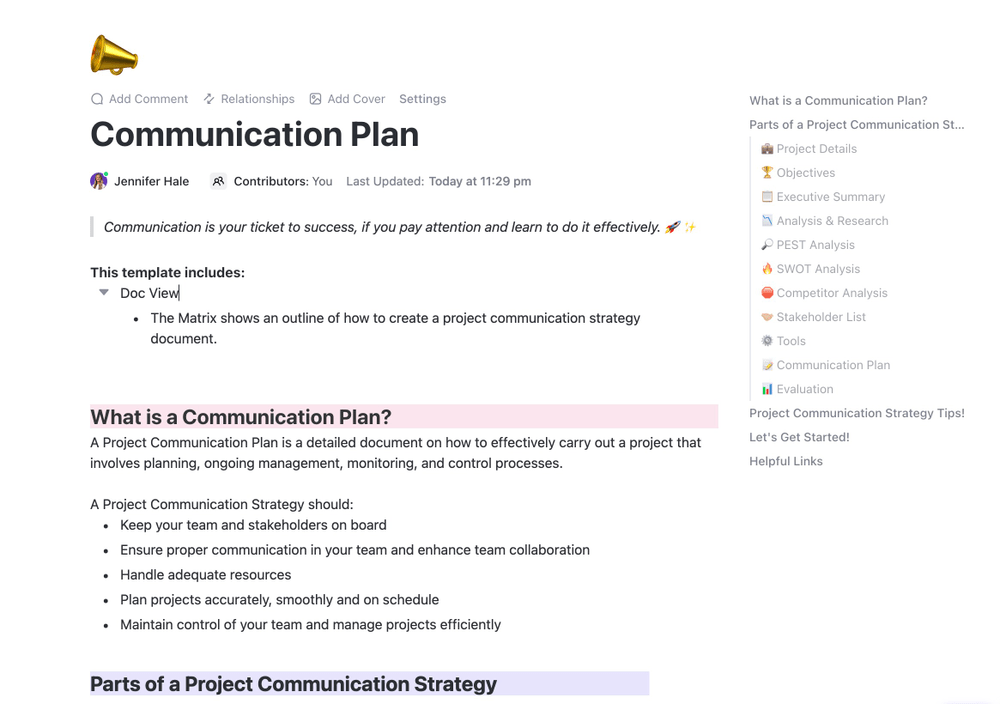
Our next free production schedule template is the ClickUp Manufacturing Communication Plan Template for better coordination and team collaboration, so you’ll avoid misunderstandings that may cause delays in the manufacturing processes.
This template helps you establish better communication paths between departments, suppliers, and stakeholders to keep information flowing and ensure everyone gets the same regular updates. Using this template, you’ll be able to document critical decisions and actions so everyone stays on the same page.
No matter the size of your operation, this template is a must-have in your collection of product management tools .

If your team operates on an Agile project management approach, sprint planning is a big part of your production plan. Make sprint planning more efficient with the ClickUp Sprint Planning Template . The template’s design makes it easier to plan each sprint, bringing clarity to a task regardless of complexity.
Use the platform’s many visualization features to create easy-to-read task planning and schedules because it plugs into ClickUp seamlessly. ClickUp’s collaborative features also make it easy for your team to keep the planning template current, so any project manager or team member can monitor progress throughout the sprint lifecycle and know where the team is at with every task on the list.

Are you looking for a way to keep your development team on track? The ClickUp Development Schedule Template is the resource you need, no matter what you’re working on and what stage of development you’re in.
The template streamlines creating a schedule with visual task management, collaborative features, real-time updates, and automated reminders. This keeps your team on track with tasks and ensures they meet deliverable deadlines.
The Development Schedule Template provides stakeholders with real-time updates. It’s a great way to update them on progress so they have the information they need at any time. With everything in one central hub, they can easily check progress while allowing the development team to continue working on their tasks.

You have an idea. Now, you need a plan to build it. The ClickUp Build Plan Template helps you organize your resources, timelines, and milestones to create a comprehensive plan for making your idea a reality.
From concept to launch, the build plan template becomes a roadmap where you can visualize tasks and progress while getting real-time updates from your team. It’s perfect for gaining clarity in each project development phase. It helps you set realistic deadlines while using internal and external resources wisely.
ClickUp’s free Build Plan Template offers plenty of customization options, including statuses, fields, and views, so you can tweak the template to suit the needs of your team. Use this template to create innovative plans for your next big idea.
This resource also works as a film production schedule template to align all departments and partners on development!

Are you trying to plan your next big software release? Keep your team on the same page with the ClickUp Release Planning Template . This is an alternative production planning template for those within the software development business. ClickUp designed the template to help oversee the launch of new software, giving you a way to organize your release plan strategically.
Start with plotting tasks, milestones, and dependencies to anticipate and remove potential bottlenecks. The template provides an insight into your team’s progress through each phase and helps you coach them to better performance.
From software inception to final deployment, the template creates a central hub for release planning, making it a seamless, collaborative effort. Take control over your release cycles and make them more efficient and effective for everyone involved.
If you’re looking for Excel templates, Simple Sheets has you covered. Its Excel Production Schedule template allows you to manage every aspect of your production process, from supply chain to operation rates, custom orders, and more.
Simple Sheets has carefully designed the spreadsheet with smart auto-population to save you from too much manual entry. Excel-savvy users can customize the spreadsheet to closely meet their team’s workflow process.
If you opt for this template, you’ll get all the benefits of working in the Excel environment, such as analyzing data and creating helpful charts to maximize efficiencies. The template is compatible with Google Sheets, too!
Track All the Production Activities and Resources in ClickUp
A great production schedule can be the backbone of your operation. It transforms the most complex processes into organized management steps. With a well-planned production schedule, you can oversee the timely delivery of goods and services while optimizing your resources and keeping everyone accountable for their responsibilities.
If you’re ready to take your production planning to the next level, check out ClickUp.
This productivity platform has a vast library of free templates to help you plan and organize your next project, whether refining an old project or developing something from the ground up. You can track tasks, allocate resources, and create timelines while working in a collaborative platform that puts communication and transparency first.
Revolutionize your production process on the ClickUp platform today!
Questions? Comments? Visit our Help Center for support.
Receive the latest WriteClick Newsletter updates.
Thanks for subscribing to our blog!
Please enter a valid email
- Free training & 24-hour support
- Serious about security & privacy
- 99.99% uptime the last 12 months
- Skip to primary navigation
- Skip to main content
- Skip to footer
How to Write a Business Plan [Complete Guide]
Last Updated on – Aug 8, 2023 @ 3:22 pm
Preparing to write your business plan? You’re already one step ahead of other entrepreneurs who don’t see its value.
A well-thought-out and well-written plan for starting and running your business helps you focus on what you need to do to make your business idea work. It can also boost your chance of getting investments and loans to finance your business .
Did you know that half of small businesses fail in their first four years? Planning is such a crucial step to reducing the risks of managing an enterprise. Turn your business idea from something abstract and uncertain into a successful venture. It starts with drafting a good business plan.
Here’s your definitive guide to writing a business plan that speaks for itself.
What is a Business Plan?
A business plan is a written document that details what a business is, what direction it will take, and how you’ll get it there.
Practically speaking, the business plan evaluates your business’ viability. As the Department of Trade and Industry (DTI) puts it , the document allows entrepreneurs to find out whether or not their business idea will bring in more money than how much it costs to start and run it.
More than just a document, the business plan helps business owners to figure out the key aspects of an enterprise, including the following:
- Business goals and strategies to meet them
- Competitive edge and how to leverage it
- Potential problems and how to solve them
- Funding required to start the business
- Equipment, facilities, and manpower needed for operations
Who Needs a Business Plan and What Is It Used For?
Every aspiring entrepreneur who will spend a great amount of money, time, and energy to earn a profit needs a business plan.
Business planning is a crucial part of starting an entrepreneurial journey, no matter how small or big a business is. Never skip this step—as they say, failing to plan is planning to fail.
Here are some examples of business types that benefit much from business planning:
Founders of startup businesses seek funds to begin their new venture. Business plans help them persuade investors and lenders to provide the funding they need.
For startups, a business plan explains the nature of the new venture, how it will achieve its goals, and why the founders are the best people to lead the company. The startup business plan should also specify the capital needed to jumpstart the new business.
Related: Fast-Growing Startups in the Philippines
Existing Businesses
Not only do startups gain advantage from a business plan—existing enterprises need it, too.
But business plans for growing businesses serve a different purpose. Usually, a business plan helps a middle-stage business raise funds for additional facilities, equipment, manpower, and others needed for expansion. This document also defines strategies for growth and allocates resources based on strategic priorities.
Growing businesses also use business plans to communicate their vision to various stakeholders such as customers, business partners, potential investors and lenders, employees, and suppliers.
For such needs, a business plan for existing businesses lays out the goals, strategies, metrics to evaluate success, responsibilities, and resource allocation.
Social Enterprises
Social enterprises may not be as profit-driven as other business types, but that doesn’t mean they need business planning any less.
A social enterprise needs to prepare a business plan to achieve its social objectives and keep empowering the communities it’s supporting. This document is what government agencies and donor agencies require and evaluate when approving grants for funding a social project .
A social enterprise business plan determines the social issue that a business idea will solve, its beneficiaries, products or services, target market, and sales projections, among many others.
Non-Profit Organizations/NGOs
Like social enterprises, non-governmental organizations (NGOs) can also use business plans to source funds for their campaigns and projects.
A nonprofit business plan discusses the problems an NGO is trying to solve through a certain project, as well as how it will do that and how much resources are needed.
It also helps the organization and its board members to prepare for risks by making projections on how likely the activities will push through and how the current sources of funds will continue to yield a certain level of revenue. Most importantly, the business plan defines the Plan B if the original plan ends up failing.
Business Plan Format and Its Components
How does a business plan exactly look like? There’s no recommended universal format for business plans. Ideally, yours is customized according to the nature of your business and what you’re going to use the plan for.
However, all business plans have sections in common. Here’s a quick walkthrough of the six components that make up a business plan.
1. Executive Summary
Like an abstract of a college thesis or a foreword of a book, the executive summary is meant to provide a brief overview of the document. It presents the highlights of a business plan in a page or two.
The executive summary the first thing that readers see, so keep it short yet engaging and compelling enough to make them want to view more details in your plan.
2. Company Profile
The company profile is your chance to introduce yourself and your business to people outside your company. It’s also called the company summary, company information, business description, and business profile.
This section quickly answers the five Ws and one H of your business: who, what, when, where, why, and how.
Think of it as your business calling card. Being the shortest section of the business plan, the company profile provides a quick overview of the business—who the owner and founder is, management team, business goals, business address, product or service, and what makes it unique.
3. Operations Plan
The operations plan explains how you’ll run your business, focusing on the different aspects of manufacturing your product. This section includes the following information, among many others:
- Type of business (sole proprietorship, partnership, corporation , or non-profit)
- How the product is made or the service completed
- Necessary materials, equipment, and facilities to manufacture the product or complete the service
- Any subcontractors needed
- Quality control system
4. Organizational Plan
Your people should play a major role in your business plan, just as how they’re important to your business success . The organizational plan includes a chart that shows how your company is structured according to key departments or functions such as administration, production/manufacturing, marketing, and finance. This organizational chart not only presents the levels of authority in a company but also clarifies who is responsible for which people and function.
Aside from the organizational chart, the organizational plan also includes these details:
- Number of employees to hire
- Responsibilities of each job role
- Qualifications of workers who will perform each role
- Salaries and benefits per job assignment
5. Marketing Plan
The marketing plan and the succeeding chapters are the heart and soul of your business plan, explaining the things that will make your business work. This section details how you plan to promote your product or service in the market.
Specifically, the marketing plan covers the following:
- How the product or service will work and how it will benefit customers
- Target market and its profile
- Strategies for packaging, advertising, public relations, and distribution
- Competitive advantage
6. Financial Plan
A critical section in your business plan, the financial plan helps you assess how much money you’ll need to start or grow your enterprise and identify your funding sources to get your business off the ground and sustain its operations. This is where you’ll provide financial estimates that cover at least one year of running your business.
Investors and lenders specifically look for these financial details in business plans:
- How much you’re going to borrow, what you’ll use the loan for, and how you’ll pay it back
- How much profit you’re expecting to make (through an income statement and balance sheet)
- How you can finance your business operations (through a cash flow statement)
- Whether to keep the business going or close it down to cut losses (through a break-even analysis)
Related: How to Write a Business Proposal
Should You Use a Business Plan Template?
Business plan templates identify what information to put into each section and how it should be structured.
They provide instructions to guide entrepreneurs through the process. This way, nothing is missed out while writing the plan.
Thus, using a business plan template is a great idea, especially if this is your first time to prepare a plan for starting or growing your enterprise.
Helpful as it as may be, a business plan template doesn’t make business planning 100% effortless. While it provides the outline that makes writing the plan easy and quick, you still need to do your homework.
For example, a template won’t compute the financial projections for you—it’s a task you have to complete either on your own or with the help of a professional.
So before you use a business plan template, manage your expectations first and be prepared to do a lot of math!
8 Free Business Plan Templates
Yes, you read it right—you can download free online business plan templates. Some of these templates are designed for a specific niche, while others offer sample business plans for a wide range of business categories and industries.
Start off by choosing any of these free templates that suit your business planning needs.
1. Business Plan Format by the DTI
DTI has a wealth of useful information for micro, small, and medium businesses in the Philippines. Of course, it’s free to access since it comes from the government.
On the DTI website, simply look for the Business Planning section and download the business plan format in a PDF file. This document not only lists down all the information to be included in every section of a business plan, but it also provides guide questions per section—making business planning easier for first-timers.
If you want a more detailed discussion of what should go into each component of your business plan plus sample scenarios, check the DTI’s Negosyo Center e-book that fleshes out things for small business owners.
2. Simple Business Plan Template by The Balance Small Business
The Balance is an online resource for small business owners. It has a free business plan template that’s simple and easy to understand for beginners, with instructions on how to use it. Broken down into sections, the simple business plan template tells you what to include in each component of the plan.
Simply copy the free template and paste it into a word document or spreadsheet. From there, you can start drafting your business plan with the template as a guide.
3. Free Sample Business Plans by Bplans
This website features a collection of over 500 free business plan samples for various industries, including restaurants, e-commerce, real estate, services, nonprofit, and manufacturing.
Under each category are links to many sample business plans for specific types of business. Each sample comes with a plan outline, too. For example, under the Services category, you’ll find sample plans for businesses like auto repair shops, advertising agencies, catering companies, health spas, photography studios, and more.
4. Business Plan Samples by LivePlan
More than 500 free sample business plans are available at the LivePlan website, so you’re likely to find one that suits your business best. The samples allow users to know how other businesses structured and worded each component of their business plans. You can copy and paste the sections into your own plan.
To download a full business plan sample, you’ll have to sign up by submitting your name and email address through the website.
5. Business Plan Templates by PandaDoc
PandaDoc offers free business plan templates for NGOs, startups, restaurants, cafes, bakeries, hotels, and salons. These documents can be downloaded in PDF format.
But if you want a customizable template, you can download the PandaDoc template for a 14-day free trial. This template allows you to edit the document, choose a theme that matches your branding, and add pictures and videos.
The website also has free templates for executive summaries and business letters.
6. The One-Page Business Plan by The $100 Startup
If your business has a simple concept, then a one-page business plan template is ideal to use. This downloadable PDF file is a very simple outline made up of a few sections with questions that you have to answer in just a short sentence or two.
7. Business Plans by Microsoft
Microsoft provides a broad selection of templates for its users, including business plan templates in Word, business plan presentations in PowerPoint, and business plan checklists in Excel.
- Sample business plan template (Word) – Provides the steps in writing a complete business plan
- Business plan presentation template (PowerPoint) – Consists of slides for different sections of a business plan that highlight the key points for viewers
- Business plan checklist template (Excel) – Enumerates the important things to do when writing a business plan, using the Strength, Weakness, Opportunity, and Threat (SWOT) analysis framework
The advantage of using a template from Microsoft is having a professional-looking document, slideshow presentation, or spreadsheet. No need to do the formatting by yourself because the template is already formatted. All you have to do is enter the necessary information into the template to complete your business plan.
8. Social Business Plan Guidelines by the Ateneo de Manila
This free business plan format for social entrepreneurs comes from the Ateneo de Manila University’s John Gokongwei School of Management. In a glimpse, it provides the basic information you need to plan a social enterprise.
It also has more detailed business plan guidelines you can refer to. Simply click the link to the word document at the bottommost part of the page.
Related: 11 Best MBA Programs & Schools in the Philippines
How to Write a Business Plan
An outstanding business plan covers everything your stakeholders need to know about your business. So don’t just wing it—put a lot of thought into this critical document.
Let’s get down to the nitty-gritty of drafting a business plan, whether you’ll use a template or not.
1. Brainstorm about your business idea
You may have a very promising business idea, but it won’t fly unless you develop it into a clear-cut concept.
Brainstorm with your team about everything you can think of about starting and running the business. Then list them all down.
Be as creative as possible. No need to be too critical at this point.
While brainstorming, aim to answer these key questions:
- Why do you want to start the business? What has inspired you to go for it?
- What product or service do you plan to sell?
- Who will be your target customers? What are their problems that you’re hoping to solve through your product or service? How will you promote your offerings to them?
- What will be your business branding ? How will you position your brand in the industry?
- What is your competitive advantage? What makes your business unique?
- Where do you see your business within a year?
2. Validate your business idea
Research on the specifics of your business idea—paying special attention to your product or service, target market, and competitors.
According to entrepreneurship experts, it’s best to spend twice as much time on this step as spending the time to the actual drafting of the business plan.
Here are some ways to validate your business idea:
- Read studies and research to find information and trends about your industry .
- Conduct market research to gather insights from industry leaders, potential customers, and suppliers . You can do this through surveys, focus group discussions, and one-on-one interviews with your stakeholders.
- Collect data about your competitors , especially the product or service they offer and how they reach their customers. Consider buying from them or visiting their store to get a feel of their products and customer experience.
Gather all relevant information and analyze your findings to assess whether the business idea is feasible or not. You may need to tweak your business idea based on your evaluation of its feasibility.
3. Define the purpose of your business plan
It’s extremely difficult to carry out anything if you aren’t sure about why you’re doing it in the first place. Without a clear purpose, you’re like driving a car without knowing where you’re headed to.
When it comes to writing your business plan, you should have its purpose in mind from the get-go. It can be one or more of the following:
- Create a roadmap to provide the directions the business must take to achieve your goals and overcome challenges. This is ideal for bootstrapping or self-funding startups.
- Seek investments and loans to finance a business. If this is your purpose for making a business plan, it should be compelling enough to attract investors and lenders.
- Set your targets, budget, timelines, and milestones. When you put them all in writing, it’s so much easier to evaluate and measure your business’ actual performance versus your goals.
- Communicate your vision and strategic priorities with the management team. With this purpose, your business plan must establish specific goals for your managers so that they have something to commit to, you can track progress, and get them to follow through on their commitments. Also, having a business plan for this purpose ensures that everybody involved in running your business is on the same page.
- Minimize risks. Running a business in itself involves a lot of risks, and it gets riskier with a poorly researched business idea. A business plan can help entrepreneurs mitigate them by organizing activities and preparing for contingencies.
4. Create an outline for the executive summary
The first section of any business plan is the executive summary. You don’t have to draft it yet at this point, but it helps to write an outline for it before you proceed with the rest of the sections.
In a sentence or two, describe these key aspects of your business:
- Product or service
- Target market
- Competitors
- Unique value proposition (how you set your business apart from the competition)
- Management team
- Short-term and long-term business goals
- Possible sources of revenue
5. Describe your business
The next step is to write your company profile. Get your readers to become familiar with your business and realize why they should be interested in it.
If you have no idea what specifically goes into this crucial business plan section, you can check the company profiles of businesses in your industry. Usually, you can find them on their websites at the About Us or About the Company page. Take note of the information included and how they’re written.
Here are the must-haves of a great company profile:
- Brief history of the company
- Mission and vision
- Product or service lineup
- Target market and audience
- How the business will address the customers’ pain points
- What makes the business unique
6. Provide details about your operations and organizational structure
Anyone who will read your business plan needs to know what they should expect when they deal with you. They need to see a solid plan for your operations and the people who make up your team. So give your operations plan and organizational plan a careful thought.
For your operations plan, choose carefully the right legal structure for your business. Will you be a sole proprietor? Or will you partner with someone or form a corporation? Your choice will have an impact not only on your business operations but also on the taxes you’ll pay and your personal liability .
As for the organizational plan, it’s where you put your organizational chart that shows a glimpse of the hierarchy within your organization. You can easily create this chart in Microsoft Word, Excel, or PowerPoint.
Also introduce the people who comprise your management team—their relevant experience, qualifications, and expertise . The organizational plan must also include information of the support personnel, as well as who reports to whom and who manages whom.
If you’ll be outsourcing some of your business functions, add them to your organizational plan, too. These may include consultants , accountants , lawyers , logistics specialists, and IT specialists. This way, you’re showing that you’re planning to fill in any expertise and skill gaps in your in-house team.
Also Read: Business Process Outsourcing to the Philippines [Complete Guide]
7. Compose your marketing plan
Make this section of your business plan as comprehensive and detailed as possible. You’d want to prove that you’ll take a strategic and aggressive approach to reach your target customers and promote your brand and product or service to them.
Divide your marketing plan into five subsections: objectives, product/service description, target market profile, competition profile, and promotional activities.
A. Objectives
Zero in on the what and the why of your marketing activities. Under the marketing objectives section, list down all your goals and the strategies you’ll implement to meet them.
Your marketing goals can be any of the following:
- Raise brand awareness
- Introduce a new product or service
- Regain or get more customers for an existing product or service
- Secure long-term contracts with your ideal clients
- Increase sales in a certain market, product, or price point
- Improve product manufacturing or product/service delivery
- Increase prices without affecting sales
B. Product/Service Description
Describe each product or service you’ll offer, including its features and benefits. You can use storytelling , images, charts, tables, or any visual element that best illustrates how each item will work to the benefit of your target customers.
C. Target Market Profile
Present as much relevant data as you can about your potential customers. Make sure to include the following:
- Demographic profile: age range, gender, income level, education, interests, etc.
- Buying behaviors
- Factors that influence their buying decisions: purchasing power, personal preferences, economic conditions, marketing campaigns, social factors (such as peer pressure and social media influencers ), cultural factors, etc.
D. Competition Profile
Your marketing plan must focus not only on your own business but also those of your competitors. List down the similar products or services that they offer to your target customers.
Also, provide an assessment of your competitors’ performance. Which areas are they doing well? How can you improve on their strengths and weaknesses? How can your business stand out? Is it your more competitive pricing? Better customer service? Superior product quality?
To come up with a good competition profile, take the time to research about your competitors. When interviewing your target customers, ask them about the brands they use or businesses they deal with.
You can also do an online search of your competitors. For example, if you’ll run a pet supplies store in Pasig, search for “pet stores Pasig” on Google. The search engine results page may show you the different stores that sell the same products as the ones you plan to offer. Read customer reviews online to get deeper insights on how these businesses serve their clients.
Consider doing a “secret shopping” in your competitor’s store. This way, you can experience firsthand how they treat their customers and how they market and sell their products or services. You might even be able to get information about their product lineup and pricing.
E. Promotional Activities
The last subsection of your marketing plan must discuss how you’ll promote your brand and products or services and connect with customers. Also, be ready to allocate budget for each marketing activity you identify in your plan.
Create a list of marketing activities you plan to implement. Will you reach your audience through SEO (organic online search), paid advertising, and/or social media? Or will you go the traditional route through print and TV advertising or joining expos, exhibits, and trade shows? The right choice depends on the nature of your business and the type of audience you’re trying to reach.
8. Develop your financial plan
The financial plan is the section where you’ll crunch the numbers. Unless you’re really good at math, it’s best to hire an accountant or business consultant who will work with you to develop a foolproof financial plan.
Put simply, a financial plan explains how a business will spend money and make more money. It also estimates the amount of time it will take for the business to earn a profit.
Here are the specifics of a good financial plan:
- Total capital requirement
- Business financing plan and any loan requirement
- Collateral to put up for a business loan
- Schedule for loan repayment
- Financial statements : cash flow statement, income statement/profit and loss statement, and balance sheet
- Break-even analysis
- Return on investment (ROI)
- Financial analysis
Ultimately, these financial projections answer the question, “Is your business financially feasible?”
9. Back up your business plan with supporting documents
Books and theses have an appendix section at the end that provides additional resources. Your business plan should have one, too. This final section consists of documents, surveys, studies, charts, tables, images, and other elements that provide supporting data.
Depending on the information you’ve presented in the other sections of the plan, your appendix may include these things:
- Market research data and findings
- Resumes of the management team
- Relevant financial documents
- Lease agreements
- Bank statements
- Licenses and permits
10. Review and refine your business plan
Your business plan is almost done at this point. Now all you have to do is go over the document once more to ensure you’ve covered everything and nothing crucial is left out.
Check your final draft and be sure it has the following:
- Sound business idea – If you’ve done Step 2 properly (validating business idea), you can be confident that you have a sound business idea.
- Comprehensive and in-depth look into your business in a professional format
- Thorough understanding of your target customers , their behaviors, interests, and needs
- Competent management team – The people who make up your team must possess the skills and expertise that complement yours.
- Business focus or specialization
Aside from yourself, ask a business partner, proofreader, and accountant or financial expert to review your business plan and spot any errors and inconsistencies. You’d want to make sure that it looks professional and is accurate.
11. Write the executive summary
Lastly, get back to the outline you created in Step 4 and write it based on your final draft. Make sure to craft an engaging executive summary that hooks people into reading the rest of the plan.
6 Actionable Tips on Writing a Business Plan
Anyone can write a business plan—but it takes more than great writing skills to create an exceptional one.
Here are some tips to help you prepare an effective business plan that goes beyond the ordinary.
1. Write with your audience in mind
When drafting your business plan, you’re writing not for yourself but for people who will play key roles in starting and running your enterprise. This is why it’s important that you know whom you’re writing for and keep them in mind while preparing your business plan.
If you think you can’t create a plan that caters to all your audience groups, consider having different versions of the document. For example, you can come up with a business plan for investors, another for lenders, one for employees, and so on. But keep the data consistent across all versions.
To write a business plan that suits a particular audience, you have to use the right language, highlight the parts that interest them, and adjust the format accordingly.
A. Use the Right Language
One of the most important rules in business writing: use the language that your target audience easily understands. If you’re writing for engineers, finance people, or lawyers, your language can be technical—meaning you can use jargons and terminologies familiar to them.
However, if you’re writing for investors who barely have technical knowledge, tweak your language in simple terms that are easy to grasp and appreciate.
Likewise, if you’re writing a business plan to communicate internally with managers and employees your company’s direction and strategies, it’s best to use more casual language than you would when writing for high-level, external stakeholders.
B. Appeal to Your Audience’s Interests
It also helps to understand what interests your audience because they will influence how you’ll write your business plan.
Your management team, for instance, will be interested in knowing your business goals and strategies so that they can help you steer the company in the right direction.
Investors and lenders look at the business plan differently—they’ll be more interested in your financial statements to determine your financial health, like if your business is worth investing in or has the ability to pay back a loan.
C. Adopt a Suitable Business Plan Format
There’s no one-size-fits-all format for business plans because it depends mainly on your audience, aside from the nature of your business.
Let’s say you’ll set up a restaurant, and you’re drafting a business plan to apply for a business loan. To convince lenders that your business is viable, details such as your restaurant’s location and possible renovations are crucial.
Meanwhile, if you’re writing the plan for potential big-time investors, you’ll take a different approach. A good restaurant business plan focuses on the business aspects that will lead to growth and profitability (Remember that investors are interested in how they’ll make money from partnering with you).
2. Keep it concise
How long should a business plan be? According to the U.S. Small Business Administration (SBA) , it depends on various factors such as the specific audience it’s written for and the nature of a business. The SBA cites surveys that found the ideal length to be at least 25 to 100 pages.
Sounds a lot? If you have a simple business idea and you’re writing a business plan for busy people who don’t have time to pore over hundreds of pages, then one page up to 20 pages should be fine.
However, you may need to provide more explanation (which will take up more pages in your business plan) if you’re planning to build a new kind of business, and a risky one at that.
The size of your business also affects the length of your business plan. Business plans for small businesses need not exceed 30 pages. Corporate business plans are expected to be longer.
What matters more than length is how concise your business plan is. Meaning, it provides all the necessary information—including solid research and analysis—using the fewest words possible. No place for wordiness here!
3. Document everything related to your business
Support your claims in the business plan with solid facts and proof. Investors, for instance, need an assurance that they won’t lose their investment when they trust you with their money. This is where documenting your business thoroughly plays a crucial role.
What kinds of documentation can you include in your business plan?
- Industry forecast or projections
- Licensing agreements
- Location strategy
- Prototype of your product or service
- Survey and FGD results
- Resumes of your management team
4. Show your passion and dedication to your business
Although business plans have straightforward, matter-of-fact content, you can still establish an emotional connection with your readers through your plan. After all, your readers are humans with feelings and motivations.
No need to be dramatic about it—you can show your passion and dedication while still sounding professional in your business plan. Write about the mistakes you’ve had (like a failed business in the past), what you’ve learned from the experience, the values you hold, and the problems of your customers you want to solve through your product or service.
5. Know your competition and how you’ll stand out
Your business won’t be the single player in your industry. Other businesses in the same niche have started way ahead of you, and some new ones will also compete for business in the future.
Write your business plan in such a way that you know your competitors so well. Identify all of them and what makes your business unique compared with the rest without belittling them.
6. Be realistic and conservative in all your estimates
In any aspect of your business, it’s better to underpromise and overdeliver than the other way around. This also holds true when writing a business plan. You wouldn’t want to set unrealistic expectations that will lead to disappointments and worse, losses, when you fail to deliver on your promise.
There’s no place for too much optimism in your business plan. Your budget allocation, timelines, capital requirements, sales and revenue targets, and financial projections must be reasonable, realistic, and conservative. These will lend credibility to your business plan and yourself as an entrepreneur. Because there are a lot of factors beyond your control, always assume that things will get completed longer and cost more ( consider inflation over time! ).
This is where your research prior to writing the draft comes extremely helpful. You have something solid and factual to benchmark against. For example, if your analysis based on the facts you’ve gathered indicates that you’ll be able to get 40% share off the market in your first year of operations, consider making your estimates a bit more conservative and attainable.
Related: The Ultimate Guide to Business Valuation in the Philippines
10 Mistakes to Avoid When Writing a Business Plan
Now, let’s explore the mistakes entrepreneurs often commit when writing a business plan. Listing them all down here to let you know what to avoid.
1. Prioritizing Form Over Substance
Spend most of your time and energy on building solid research and facts rather than obsessing about which font type or background color will look best for your document.
2. Overthinking
Many entrepreneurs take too long to complete their business plans because they worry too much about it. Don’t get intimidated by business planning—you don’t have to be an expert or a degree holder in business management or business administration to be able to write an outstanding business plan. Overthinking will just lead to analysis paralysis and get nothing done.
As long as you know your business well and are passionate about it, then writing a business plan won’t be as difficult as you think, especially if you’re using a template.
3. Submitting the Document Without Proofreading It
If your business plan is filled with typos and grammatical errors, readers will get distracted even if you’re presenting substantial information. It may also give your audience an impression that you’re careless—and who wants to deal with a person who isn’t professional and careful enough?
Even if it costs you money, pay a professional proofreader to check your work and correct any errors so that the message you wanted to convey through your business plan will get across.
4. Making Empty Claims
Any statement that isn’t sufficiently supported by solid research or documentation has to go. For example, if you want to claim to be the top player in your industry but you don’t have any evidence to back it up, rethink about including it in your business plan.
5. Writing an Overly Long and Wordy Plan
Make sure that everything you put into your business plan is relevant and serves your purpose. Otherwise, remove unnecessary statements that just add fluff to the document.
Also, don’t waste your readers’ time by using too many words—including highfalutin ones. Remember, your goal is to make your audience understand your business, not to impress them with beautiful or complex prose.
6. Using Too Many Superlatives
Even if you really feel that your business, business idea, or projection is incredible, amazing, the best, great, fantastic, or one of a kind, avoid using these superlatives because they aren’t appropriate for formal documents like a business plan.
7. Doing the Financial Projections on Your Own
Unless you’re an accountant yourself, it’s best that you get a professional to do the job for you. It will save you time and the headache of dealing with numbers and formatting your financial plan properly.
8. Overestimating Your Projections
The business plan is not a place to make impossible promises—while they look good on paper, you might run into trouble fulfilling them. To avoid this mistake, always do your research. Find out how other businesses do it and what the typical timeframes and financial projections are before you come up with your estimates.
9. Long-Term Business Planning
As much as possible, limit your projections to only a year. A lot of things can happen and make your business different from how you initially planned it. Stick with your short-term or one-year targets and estimates, then just tweak your business plan as time goes by.
10. Including Unfounded Rumors About Your Competitors
Not only do rumors make your business plan look unprofessional, but they also distract your readers from your intended message, which is to highlight what makes your business different from the competition. Avoid including details based only on hearsay. Everything in your plan must be backed up by solid, quantifiable facts.
Key Takeaway
A business plan is more than just a document that you prepare once and will never look at again. Rather, it’s a strategic tool that you should use from time to time to guide your business operations, get the buy-in of your stakeholders, and grow your business over time.
Once you’re done with writing your business plan, make the most of it for your business. Use it and modify it as often as needed!
Ready and confident to start writing your business plan? Share your thoughts and questions below!
Other Useful Business Resources from Grit PH:
- How to Sell a Business in the Philippines
About Venus Zoleta
Venus Zoleta is an experienced writer and editor, specializing in personal finance and digital marketing.
She has been a regular columnist for some of the biggest business & finance publications in the Philippines, such as MoneyMax.ph and Filipiknow.net.
Hoping to retire early, she started investing and bought a home in her early 20s. This crazy cat mom eats ramen like there's no tomorrow.
Education: University of the Philippines (B.A. Journalism) Focus: Personal Finance, Personal Development, and Entrepreneurship
Reader Interactions
March 3, 2020 at 10:00 am
I like it, and i want to learn more about for business
March 6, 2020 at 9:46 am
Hello Ms. Venus, Rise Against Hunger Philippines, N.G.O. , branching out into a new high ways… and i am newly hired as a social enterprise development officer… whose main tasks to launch a product line; an up-cycled tarpaulin bags.. manufactured by a group of community women (skills training’s, coordinated by life coached; aiming w-holistic transformation and sustainability program.. . with such a big tasks, i need a step by step guides, and if possible a coach for i cannot do it alone… thank you, henry reandino chua
Leave a Reply Cancel reply
Your email address will not be published. Required fields are marked *
We need your help!
Our team is currently conducting research for an upcoming guide focusing on starting a business in the Philippines . We would greatly appreciate your contribution, which should only require a few seconds of your time.
Thank you in advance!
- Digital Marketing
- Search Engine Optimization (SEO)
- Digital PR & Link Building
- Social Media Marketing
- Digital Advertising (PPC & Social)
- Content Marketing
- Copywriting
- Email Marketing
- Conversion Optimization
- Web/App Development
- Ecommerce Development
Please enable JavaScript in your browser to complete this form. Name * Location of Business * Number of Employees * 1 - 10 11 -50 51 - 100 100 - 500 500+ Phone Number * Email * Insurance Company Standard Insurance AXA Philippines BDO AIG Submit
Please enable JavaScript in your browser to complete this form. Full Name * Company Name * Mobile Number * Email Address * Submit
Please enable JavaScript in your browser to complete this form. Name * Contact Number * Email Address * Target Location Preferred Developer * Ayala Land SM Prime Megaworld Alveo Land DMCI Homes Federal Land Robinsons Land Corp Vista Land and Lifescapes Filinvest Land Shang Properties Century Properties Empire East Rockwell Land Website Submit
Disclosure: Your personal details will not be shared with any third-party companies. We’ll just need your contact details so our resident real estate agents can reach you to provide you with the details for any of the listed property developments you’re interested to invest in.
Please enable JavaScript in your browser to complete this form. Name * Age * Location* Phone Number * Email Address * Insurance Company Sun Life Financial Pru Life U.K. AXA Philippines AIA Philippines Manulife Insular Life BPI-AIA BDO Life Etiqa FWD Insurance Allianz PNB Life Message Get a Quote
Disclosure: Your personal details will not be shared with any third-party companies. We’ll just need your contact details so our resident financial advisors can reach you to provide you with the details for any of the listed insurance company you’re interested in.

Production Company Business Plan Template
Written by Dave Lavinsky

Production Company Business Plan
Over the past 20+ years, we have helped over 500 entrepreneurs and business owners create business plans to start and grow their production companies.
If you’re unfamiliar with creating a production company business plan, you may think creating one will be a time-consuming and frustrating process. For most entrepreneurs it is, but for you, it won’t be since we’re here to help. We have the experience, resources, and knowledge to help you create a great business plan.
In this article, you will learn some background information on why business planning is important. Then, you will learn how to write a production company business plan step-by-step so you can create your plan today.
Download our Ultimate Business Plan Template here >
What is a Production Company Business Plan?
A business plan provides a snapshot of your production company as it stands today, and lays out your growth plan for the next five years. It explains your business goals and your strategies for reaching them. It also includes market research to support your plans.
Why You Need a Business Plan for a Production Company
If you’re looking to start a production company or grow your existing production company, you need a business plan. A business plan will help you raise funding, if needed, and plan out the growth of your production company to improve your chances of success. Your production company business plan is a living document that should be updated annually as your company grows and changes.
Sources of Funding for Production Companies
With regards to funding, the main sources of funding for a production company are personal savings, credit cards, bank loans, and angel investors. When it comes to bank loans, banks will want to review your business plan and gain confidence that you will be able to repay your loan and interest. To acquire this confidence, the loan officer will not only want to ensure that your financials are reasonable, but they will also want to see a professional plan. Such a plan will give them the confidence that you can successfully and professionally operate a business. Personal savings and bank loans are the most common funding paths for production companies.
Finish Your Business Plan Today!
How to write a business plan for a production company.
If you want to start a production company or expand your current one, you need a business plan. The guide below details the necessary information for how to write each essential component of your production company business plan.
Executive Summary
Your executive summary provides an introduction to your business plan, but it is normally the last section you write because it provides a summary of each key section of your plan.
The goal of your executive summary is to quickly engage the reader. Explain to them the kind of production company you are running and the status. For example, are you a startup, do you have a production company that you would like to grow, or are you operating a chain of production companies?
Next, provide an overview of each of the subsequent sections of your plan.
- Give a brief overview of the production industry.
- Discuss the type of production company you are operating.
- Detail your direct competitors. Give an overview of your target customers.
- Provide a snapshot of your marketing strategy. Identify the key members of your team.
- Offer an overview of your financial plan.
Company Overview
In your company overview, you will detail the type of production company you are operating.
For example, your production company might specialize in one of the following types of production companies:
- Feature Film Production Company : this type of production company handles all of the necessities that go with producing a major film – hiring on-screen and off-screen talent, writers, musicians, location scouts, a team for pre-production, post-production, legal, etc.
- Commercial Production Company: this type of production company can produce stock footage, short corporate videos, training videos, and creative projects such as music videos and short films
- Post Production Company: this type of production company handles video editing, special effects, color correction, sound mixing, and editing to eventually produce the final video.
- Niche Production Company: this type of production company focuses on one specific niche that it has perfected. They often combine the best of animation, commercial, and post-production companies.
In addition to explaining the type of production company you will operate, the company overview needs to provide background on the business.
Include answers to questions such as:
- When and why did you start the business?
- What milestones have you achieved to date? Milestones could include the number of clients served, the number of films with positive reviews, reaching X number of clients served, etc.
- Your legal business structure. Are you incorporated as an S-Corp? An LLC? A sole proprietorship? Explain your legal structure here.
Industry Analysis
In your industry or market analysis, you need to provide an overview of the production industry.
While this may seem unnecessary, it serves multiple purposes.
First, researching the production industry educates you. It helps you understand the market in which you are operating.
Secondly, market research can improve your marketing strategy, particularly if your analysis identifies market trends.
The third reason is to prove to readers that you are an expert in your industry. By conducting the research and presenting it in your plan, you achieve just that.
The following questions should be answered in the industry analysis section of your production company business plan:
- How big is the production industry (in dollars)?
- Is the market declining or increasing?
- Who are the key competitors in the market?
- Who are the key suppliers in the market?
- What trends are affecting the industry?
- What is the industry’s growth forecast over the next 5 – 10 years?
- What is the relevant market size? That is, how big is the potential target market for your production company? You can extrapolate such a figure by assessing the size of the market in the entire country and then applying that figure to your local population.
Customer Analysis
The customer analysis section of your production company business plan must detail the customers you serve and/or expect to serve.
The following are examples of customer segments: individuals, companies, filmmakers, studios.
As you can imagine, the customer segment(s) you choose will have a great impact on the type of production company you operate. Clearly, small businesses would respond to different marketing promotions than filmmakers, for example.
Try to break out your target customers in terms of their demographic and psychographic profiles. With regards to demographics, including a discussion of the ages, genders, locations, and income levels of the potential customers you seek to serve.
Psychographic profiles explain the wants and needs of your target customers. The more you can recognize and define these needs, the better you will do in attracting and retaining your customers.
Finish Your Production Company Business Plan in 1 Day!
Don’t you wish there was a faster, easier way to finish your business plan?
With Growthink’s Ultimate Business Plan Template you can finish your plan in just 8 hours or less!
Competitive Analysis
Your competitive analysis should identify the indirect and direct competitors your business faces and then focus on the latter.
Direct competitors are other production companies.
Indirect competitors are other options that customers have to purchase from that aren’t directly competing with your product or service. This includes social media platforms, web developers, apps and even college or university students. You need to mention such competition as well.
For each such competitor, provide an overview of their business and document their strengths and weaknesses. Unless you once worked at your competitors’ businesses, it will be impossible to know everything about them. But you should be able to find out key things about them such as
- What types of clients do they serve?
- What type of production company are they?
- What is their pricing (premium, low, etc.)?
- What are they good at?
- What are their weaknesses?
With regards to the last two questions, think about your answers from the customers’ perspective. And don’t be afraid to ask your competitors’ customers what they like most and least about them.
The final part of your competitive analysis section is to document your areas of competitive advantage. For example:
- Will you provide concierge services or customized packages for your clients?
- Will you offer products or services that your competition doesn’t?
- Will you provide better customer service?
- Will you offer better pricing?
Think about ways you will outperform your competition and document them in this section of your plan.
Marketing Plan
Traditionally, a marketing plan includes the four P’s: Product, Price, Place, and Promotion. For a production company business plan, your marketing strategy should include the following:
Product : In the product section, you should reiterate the type o f production company that you documented in your company overview. Then, detail the specific products or services you will be offering. For example, will you provide video editing, music editing, pre-production, or post-production services?
Price : Document the prices you will offer and how they compare to your competitors. Essentially in the product and price sub-sections of yo ur plan, yo u are presenting the products and/or services you offer and their prices.
Place : Place refers to the site of your production company. Document where your company is situated and mention how the site will impact your success. For example, is your production company located in New York or Los Angeles, a business district, a standalone office, or purely online? Discuss how your site might be the ideal location for your customers.
Promotions : The final part of your production company marketing plan is where you will document how you will drive potential customers to your location(s). The following are some promotional methods you might consider:
- Be part of filmmaker associations and networks
- Reach out to websites
- Distribute flyers
- Engage in email marketing
- Advertise on social media platforms
- Improve the SEO (search engine optimization) on your website for targeted keywords
Operations Plan
While the earlier sections of your business plan explained your goals, your operations plan describes how you will meet them. Your operations plan should have two distinct sections as follows.
Everyday short-term processes include all of the tasks involved in running your production company , including client communication and interaction, planning and producing production services, billing clients, etc.
Long-term goals are the milestones you hope to achieve. These could include the dates when you expect to book your Xth client, or when you hope to reach $X in revenue. It could also be when you expect to expand your production company to a new city.
Management Team
To demonstrate your production company’s potential to succeed, a strong management team is essential. Highlight your key players’ backgrounds, emphasizing those skills and experiences that prove their ability to grow a company.
Ideally, you and/or your team members have direct experience in managing production companies. If so, highlight this experience and expertise. But also highlight any experience that you think will help your business succeed.
If your team is lacking, consider assembling an advisory board. An advisory board would include 2 to 8 individuals who would act as mentors to your business. They would help answer questions and provide strategic guidance. If needed, look for advisory board members with experience in managing a production company or successfully running a small filmmaking company.
Financial Plan
Your financial plan should include your 5-year financial statement broken out both monthly or quarterly for the first year and then annually. Your financial statements include your income statement, balance s heet, and cash flow statements.
Income Statement
An income statement is more commonly called a Profit and Loss statement or P&L. It shows your revenue and then subtracts your costs to show whether you turned a profit or not.
In developing your income statement, you need to devise assumptions. For example, will you book 5 films or videos per day, and/or offer production packages ? And will sales grow by 2% or 10% per year? As you can imagine, your choice of assumptions will greatly impact the financial forecasts for your business. As much as possible, conduct research to try to root your assumptions in reality.
Balance Sheets
Balance sheets show your assets and liabilities. While balance sheets can include much information, try to simplify them to the key items you need to know about. For instance, if you spend $50,000 on building out your production company, this will not give you immediate profits. Rather it is an asset that will hopefully help you generate profits for years to come. Likewise, if a lender writes you a check for $50,000, you don’t need to pay it back immediately. Rather, that is a liability you will pay back over time.
Cash Flow Statement
Your cash flow statement will help determine how much money you need to start or grow your business, and ensure you never run out of money. What most entrepreneurs and business owners don’t realize is that you can turn a profit but run out of money and go bankrupt.
When creating your Income Statement and Balance Sheets be sure to include several of the key costs needed in starting or growing a production company:
- Cost of equipment and production studio supplies
- Payroll or salaries paid to staff
- Business insurance
- Other start-up expenses (if you’re a new business) like legal expenses, permits, computer software, and equipment
Attach your full financial projections in the appendix of your plan along with any supporting documents that make your plan more compelling. For example, you might include your studio location lease or a list of production services you plan to offer.
Writing a business plan for your production company is a worthwhile endeavor. If you follow the template above, by the time you are done, you will truly be an expert. You will understand the production industry, your competition, and your customers. You will develop a marketing strategy and will understand what it takes to launch and grow a successful production company.
Production Company Business Plan FAQs
What is the easiest way to complete my production company business plan.
Growthink's Ultimate Business Plan Template allows you to quickly and easily write your production company business plan.
How Do You Start a Production Company Business?
Starting a production company business is easy with these 14 steps:
- Choose the Name for Your Production Company Business
- Create Your Production Company Business Plan
- Choose the Legal Structure for Your Production Company Business
- Secure Startup Funding for Your Production Company Business (If Needed)
- Secure a Location for Your Business
- Register Your Production Company Business with the IRS
- Open a Business Bank Account
- Get a Business Credit Card
- Get the Required Business Licenses and Permits
- Get Business Insurance for Your Production Company Business
- Buy or Lease the Right Production Company Business Equipment
- Develop Your Production Company Business Marketing Materials
- Purchase and Setup the Software Needed to Run Your Production Company Business
- Open for Business
Don’t you wish there was a faster, easier way to finish your Production Company business plan?
OR, Let Us Develop Your Plan For You
Since 1999, Growthink has developed business plans for thousands of companies who have gone on to achieve tremendous success. Click here to hire someone to write a business plan for you from Growthink’s team.
Other Helpful Business Plan Articles & Templates


Production Plan
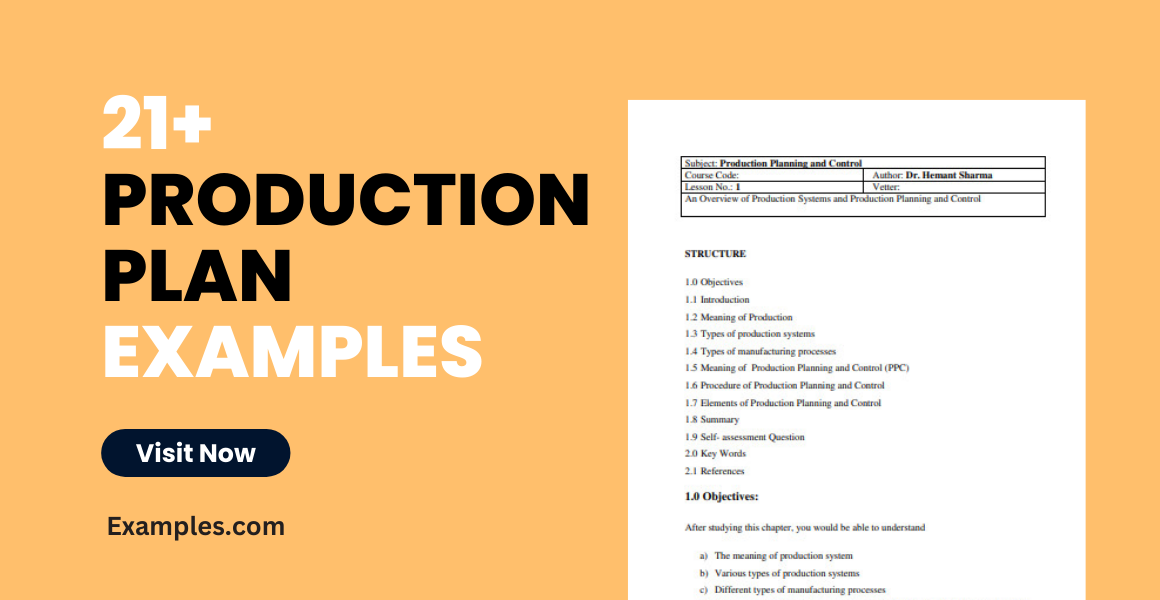
People face failure. Not all entrepreneurs are capable of thriving to survive in this industry. Indeed, businesses fail. And that is the truth about it. But do you remember how all the plans that didn’t push through? If you do, then now is the time to correct mistakes from the past. Don’t take planning as anything. Whether in food, film, or media production, organizing your activities helps in achieving your goals. Take your time to prepare a production plan . Be guided in executing the right activity to achieve your goals. Create a structure and release the doubt. Increase your potential and start planning for the production today.
21+ Production Plan Examples
1. daily production plan template.
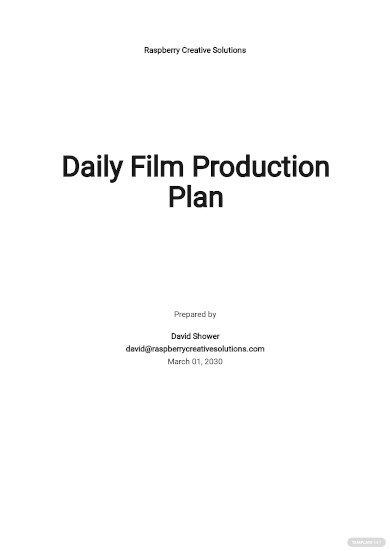
2. Pre Production Plan Template
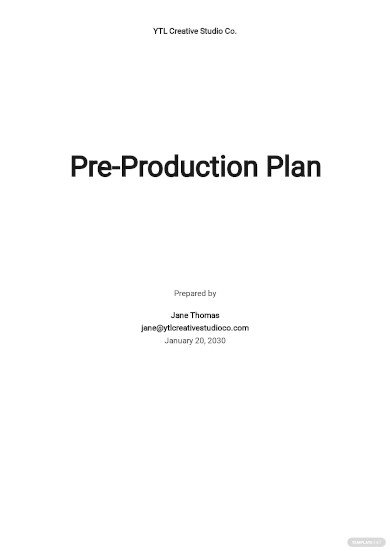
3. Film Production Plan Template
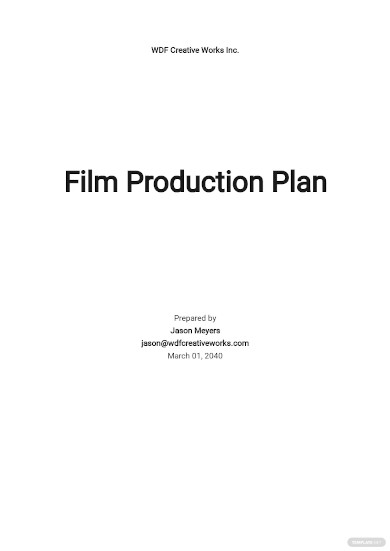
4. Production Control Plan Template
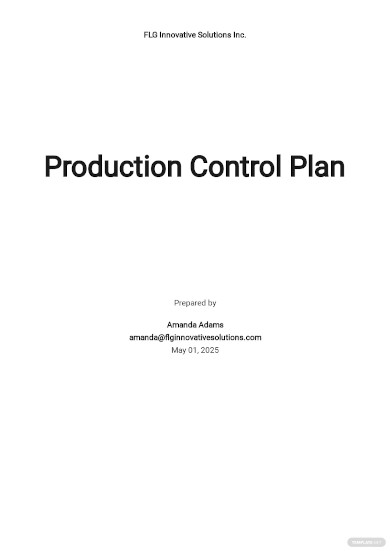
5. Production Support Plan Template
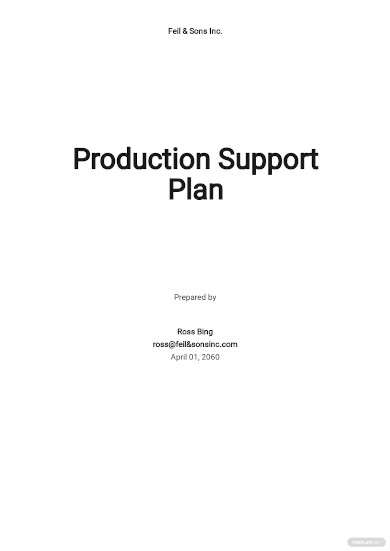
6. Web Production Plan Template
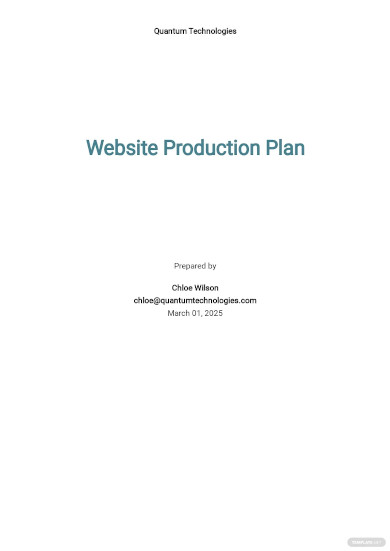
7. Production Company Business Plan Template
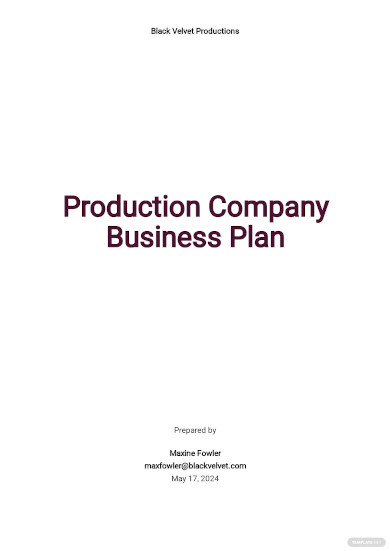
- Google Docs
8. Video Production Business Plan Template
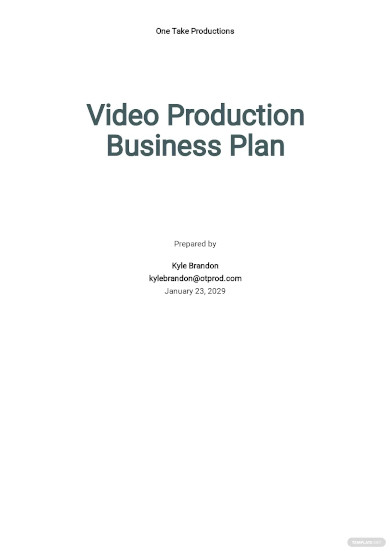
9. Production Plan Template
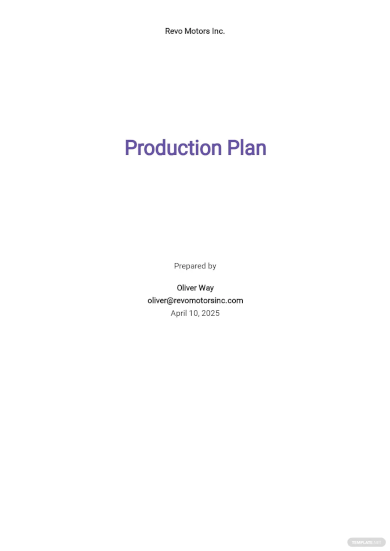
- Apple Pages
Size: 14 KB
10. Production Deployment Plan Template

Size: 23 KB
11. Video production Project Plan Template
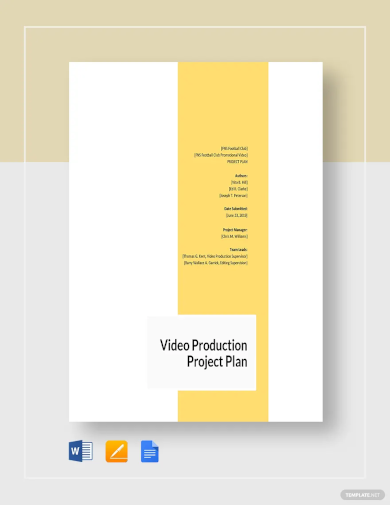
Size: 44 KB
12. Production Plan
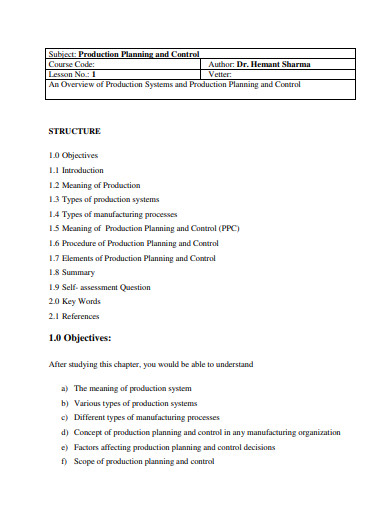
13. Production Capacity and Material Planning
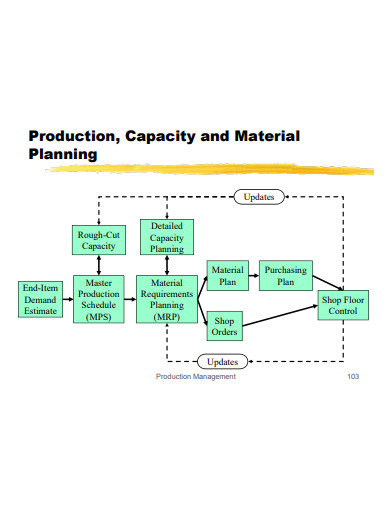
Size: 414 KB
14. Production Planning and Control
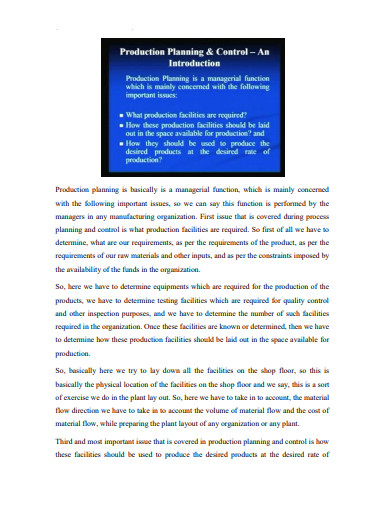
Size: 409 KB
15. Production Planning and Execution
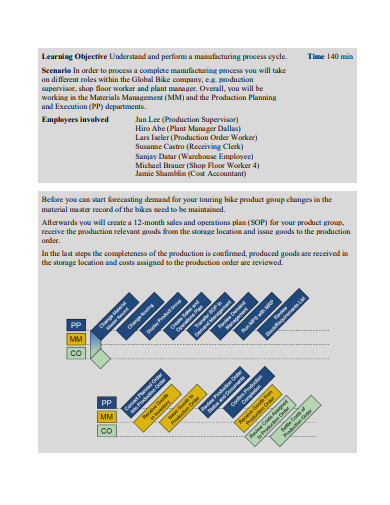
16. Sample Production Plan

Size: 486 KB
17. Simple Production Plan
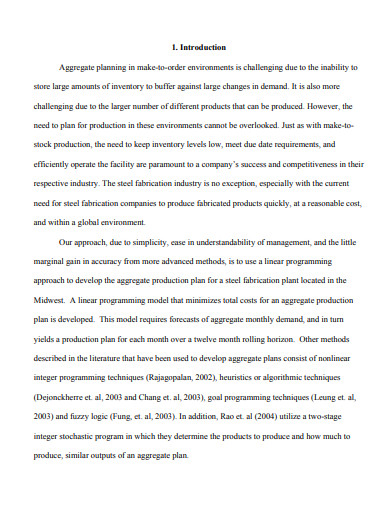
Size: 181 KB
18. Production Line Production Plan
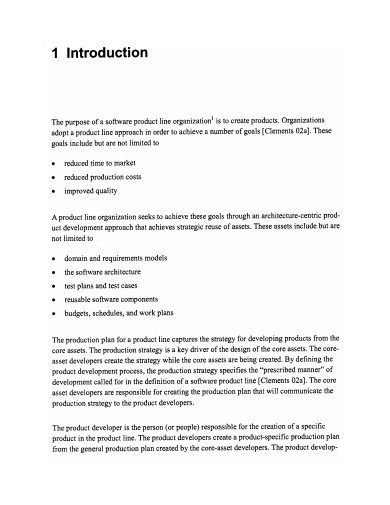
19. Demand Forecasting and Production Planning
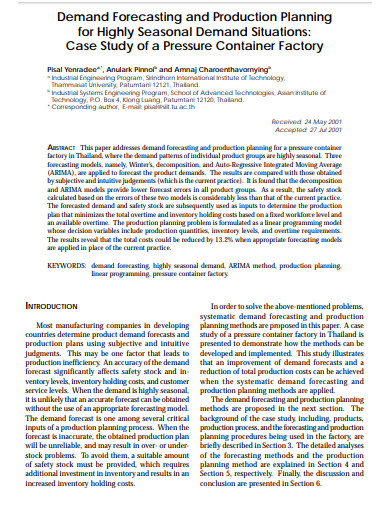
Size: 76 KB
20. Elements of Production Planning and Control
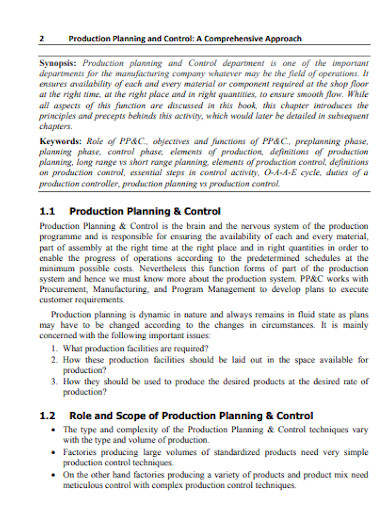
21. Housing Production Plan

22. Production Plan Example
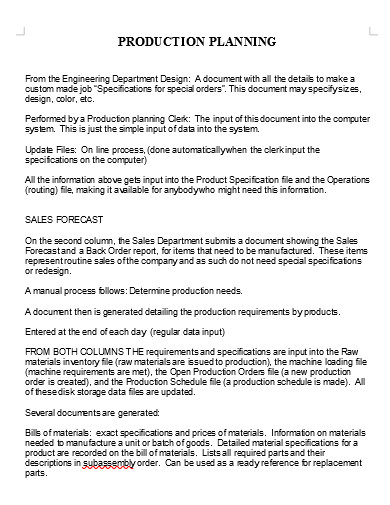
What is a Production Plan?
Small businesses are always tangled with several challenges while starting a business. You can expect that there will be projects, events, and daily activities. A production plan is a detailed document that outlines the structure of the company’s operations. In the plan, there is a structure, schedule, goal, activities, and the definition of resources in between. It is one step closer to success at a time. So, whenever your path is uncertain, a production plan will help in opening the right direction. This is why entrepreneurs must consider rewriting their planning techniques. If you are having issues with the layout, the proper organization saves the day.
Business Production Situation
According to an article published by Forbes, 80% out of 100 small business owners guarantee success in the first year of business operation. It manifests an above-average rate of success. However, behind this curtain are failing attempts for smaller businesses to stand out. Generally, the business industry is at a 50% stake in reaching accomplishment and failure. Surprisingly, many companies today face a battle without enough capital. Sometimes, competition is thick and no weapon to defend. These are just among the factors that affect the whole organization. But, don’t thrive for the worst. You need a little encouragement to compete. Here, you must adjust your business activities, schedule, and operations.
Generally, you need to plan. So, before you start getting back to your daily grind, let us learn more about writing down your production plan. Follow below.
How To Create a Production Plan
If you are a manufacturing firm, it is not always easy to look into the company’s needs. There will always be lapses. And that is one thing that you should avoid. But you can do this through planning. You need your plans outlined to track the inputs of the production. That is why we help you go through it. You should understand every step by following the list below.
1. Forecast Market Demand
First things first, you need to stretch it out. To effectively plan for the future of the business, you need an estimate of the sales through market demand. How many products should you produce to meet the target demand? When should these products be released? Another way to secure this process is through current and historical information. On top of the line, there will be orders in the coming weeks. So, you need to think ahead. In general, take advantage of internal and external resources.
2. Know the Production Options Available
Here, you need to verify the tools and resources necessary to produce your products and services. Take for example, when you have a bakery business, you need to know the machines that are required to produce bread and cakes. You can start this by listing the food on the menu. Then, create a flowchart. Once these are all secured, you can already identify the resources that should be available for the business to operate. You can improve the process by having the right materials.
3. Determine the Human Resources
Aside from the equipment, you need to count how many employees you will need to operate. Of course, it is not enough to operate without the labor workers that control and monitor the production. To do this accurately, separate each team into a department. But base them according to the availability of position and equipment. Your staff should be enough to deliver and produce without delays. But aside from that, you need to weigh in your production budget. Or else, it can lead to a big commotion.
4. Monitor Plan Control
An action plan without constant monitoring is just a waste of time. Neglecting this will eventually lead to pitfalls. So, you need to measure the risk factors. This is where you compare and contrast the production process. Record a report as this helps you determine a recurring problem. Don’t let issues happen in a blink of an eye. Monitor and control while you can.
5. Make the Necessary Adjustments
For the last step, make the adjustments you intend to make with your plan. What are the challenges? Does the plan need tweaking? Production planning can be a little tricky when done wrong. Now that you have monitored and measured the risk percentage, pen down all the actions necessary. Change them according to your evaluation. Here, you should achieve a comprehensive management plan . Weigh the budget, schedule, and activities too.
How do you define a production planning procedure?
Production planning is a process that is taken during manufacturing. It details all the necessary procedures for the company to operate. It includes hiring staff, checking the resources, evaluating the results. Through this process, the production will run smoothly.
What are the essential components of production?
Production consists of various components. These are essentials to execute the manufacturing process. This includes planning, producing, scheduling, evaluating, and following ups—all of these work hand in hand for the company to deliver quality products with no delay.
What are the primary goals of the production plan?
The general objective of production planning is to secure the workflow process of a manufacturing company. As the demand goes up, it is important to ensure that all the products released are of quality.
Are you struggling to meet your daily quota? Remember, one-day unproductive results in several risks in the business. This profoundly affects your reputation, and of course, the sales. But you can change honest mistakes. While you look at the list of tips in creating a production plan, you can resume your manufacturing business and align all the plans with your objectives. Understandably, running a business is daunting and frustrating. But you will never know your potential unless you try. So, start today. Highlight your potential by outlining all the plans necessary.
Text prompt
- Instructive
- Professional
Create a study plan for final exams in high school
Develop a project timeline for a middle school science fair.
A Format for Production Planning
- Small Business
- Advertising & Marketing
- Product Plans
- ')" data-event="social share" data-info="Pinterest" aria-label="Share on Pinterest">
- ')" data-event="social share" data-info="Reddit" aria-label="Share on Reddit">
- ')" data-event="social share" data-info="Flipboard" aria-label="Share on Flipboard">
Operations Planning & Scheduling
What is the principle behind the critical path method & how does this affect project management, costing for the fashion industry.
- CPM & PERT Weaknesses & Strengths
- How to Calculate Lead Time for Production Scheduling
Manufacturing businesses use production planning to determine the number of items they can produce during a specific period, balanced against the orders or demand for their products. The planning process includes ensuring that you procure enough raw materials, labor resources and items such as packaging to achieve the required production.
Several formats exist for production planning and some are more suited to small business than others. One reliable format is the Gantt chart, which is an adaptable method of tracking complex projects. Create a Gantt chart using planning software, or manually using a board or large sheet of paper and sticky notes.
A Gannt chart provides a reliable format for production planning. It can be done manually on a large sheet of paper or with software.
List the Activities
Compile a list of all the activities or steps in the production process, showing the length of time each activity takes and the earliest possible start date. State whether each task runs parallel to other tasks or is sequential to the successful completion of a former activity.
For example, activities in the production of t-shirts could include the cutting and sewing of the various components, such as the sleeves and body sections. These are parallel activities, which workers can perform at the same time; however, the assembly of the final product depends on the completed production of all the components. This makes the final assembly a sequential task that occurs after the manufacture of the individual items.
Chart Setup
Use a large sheet of blank paper or a whiteboard, on which to plot the rough draft of the chart. Create columns to represent time intervals, such as hours, days or weeks, depending on the time it takes to make your products. For example, items of clothing may require hourly intervals, while building furniture may need daily or weekly intervals.
Draw a bar or use sticky notes to represent each task, which begins at the starting time and ends after the length of time it takes. Schedule activities that depend on the completion of others in sequential order. Tasks that occur at the same time as others are scheduled in parallel, one below the other.
Analyze the Schedule
Use different colors to highlight tasks allocated to specific teams or individuals. Draw dotted lines in red to denote the critical path of the production process, which highlights the main activities the production team must complete to produce the goods.
For example, if two different products must be manufactured to produce the finished item, the critical path runs from the start date of the first item, through the production process, and ends with production of the last item or final product assembly. This shows the planner the minimum time in which production can take place, and enables him to identify the effect delays have on the critical path.
Monitor the Process
Monitor the time each task in the production schedule takes against the Gantt chart. Amend the chart when necessary, by changing the timeline according to actual performance. If you are using a manual chart, move the sticky notes on to a later interval in the case of a delay, or move them back for early completion.
Change sequential tasks accordingly, to ensure the completion date remains accurate. If changes affecting the final date are unacceptable, identify tasks to fast track to make up for delays to conform to the completion date. If you are using planning software, close each task as it is completed and record the date and time. The program will identify risks of delayed completion and enable you to revise the plan if necessary.
- Mind Tools: Gantt Charts
- How to Use the Critical Path Method for Complete Beginners
- Business Development Bank of Canada: What Makes a Good Production Plan?
- Wrike.com: Web-Based Gantt Chart Software
Tracey Sandilands has written professionally since 1990, covering business, home ownership and pets. She holds a professional business management qualification, a bachelor's degree in communications and a diploma in public relations and journalism. Sandilands is the former editor of an international property news portal and an experienced dog breeder and trainer.
Related Articles
Critical path planning and scheduling, business tools for scheduling, how to draw a schedule for a large construction project, advantages and disadvantages of the scrum project management methodology, what are the features of a critical path method, how do i develop a timeline for a business plan, how to supervise a manufacturing process, how to conduct a physical inventory in manufacturing, how to determine the critical path & expected completion time, most popular.
- 1 Critical Path Planning and Scheduling
- 2 Business Tools for Scheduling
- 3 How to Draw a Schedule for a Large Construction Project
- 4 Advantages and Disadvantages of the Scrum Project Management Methodology
- Work & Careers
- Life & Arts
China’s plan to sell cheap EVs to the rest of the world
Try unlimited access only $1 for 4 weeks.
Then $75 per month. Complete digital access to quality FT journalism on any device. Cancel anytime during your trial.
- Global news & analysis
- Expert opinion
- Special features
- FirstFT newsletter
- Videos & Podcasts
- Android & iOS app
- FT Edit app
- 10 gift articles per month
Explore more offers.
Standard digital.
- FT Digital Edition
Premium Digital
Print + premium digital, ft professional, weekend print + standard digital, weekend print + premium digital.
Essential digital access to quality FT journalism on any device. Pay a year upfront and save 20%.
- Global news & analysis
- Exclusive FT analysis
- FT App on Android & iOS
- FirstFT: the day's biggest stories
- 20+ curated newsletters
- Follow topics & set alerts with myFT
- FT Videos & Podcasts
- 20 monthly gift articles to share
- Lex: FT's flagship investment column
- 15+ Premium newsletters by leading experts
- FT Digital Edition: our digitised print edition
- Weekday Print Edition
- Videos & Podcasts
- Premium newsletters
- 10 additional gift articles per month
- FT Weekend Print delivery
- Everything in Standard Digital
- Everything in Premium Digital
Complete digital access to quality FT journalism with expert analysis from industry leaders. Pay a year upfront and save 20%.
- 10 monthly gift articles to share
- Everything in Print
- Make and share highlights
- FT Workspace
- Markets data widget
- Subscription Manager
- Workflow integrations
- Occasional readers go free
- Volume discount
Terms & Conditions apply
Explore our full range of subscriptions.
Why the ft.
See why over a million readers pay to read the Financial Times.
International Edition

IMAGES
VIDEO
COMMENTS
A production plan serves as a roadmap that outlines the steps, resources, and strategies required to manufacture products or deliver services efficiently. By carefully crafting a production plan within a business plan, entrepreneurs can ensure optimal utilisation of resources, timely delivery, cost efficiency, and customer satisfaction.
To write a production plan for a business, follow these steps: Define the business's goals and objectives. Determine the production process, including materials, labor, and equipment needed. Set production targets and timelines. Allocate resources and determine a budget. Create contingency plans for potential issues.
Tips on Writing a Business Plan. 1. Be clear and concise: Keep your language simple and straightforward. Avoid jargon and overly technical terms. A clear and concise business plan is easier for investors and stakeholders to understand and demonstrates your ability to communicate effectively. 2.
Reference: Chapter 3, 4, 5, and 16. III. Marketing and Sales. This section of the business plan should clearly communicate an understanding of how to successfully market and sell your product to the identified customer segments. Understanding and communicating your customer development strategy is as important as your product development strategy.
The steps below will guide you through the process of creating a business plan and what key components you need to include. 1. Create an executive summary. Start with a brief overview of your entire plan. The executive summary should cover your business plan's main points and key takeaways.
The production planning process consists of an organization's actions to make a production strategy that allows it to manufacture products most efficiently and profitably. Here are 10 key steps you should follow when planning your production process. 1. Use Production Forecasting Methods for Estimating Customer Demand.
How To Write the Operations Plan Section of the Business Plan. Stage of Development Section. Production Process Section. The Bottom Line. Frequently Asked Questions (FAQs) Photo: Daniel Ingold / Getty Images. How to write the operations plan section of the business plan, including details on writing the development and production process sections.
1. Create Your Executive Summary. The executive summary is a snapshot of your business or a high-level overview of your business purposes and plans. Although the executive summary is the first section in your business plan, most people write it last. The length of the executive summary is not more than two pages.
How to Write a Business Plan Step 1. Create a Cover Page. The first thing investors will see is the cover page for your business plan. Make sure it looks professional. A great cover page shows that you think about first impressions. A good business plan should have the following elements on a cover page:
Next, the operations and production chapter of a business plan should provide details about the equipment to be used. After listing all the equipment you should describe its condition and ownership status i.e. is it wholly owned or partially owed. Describe the unavailable equipment you'll need to purchase, the source and the anticipated cost.
Here are the five types of production planning, with an example of each: 1. Flow. The flow method involves smoothing the connections between manufacturing stages and steps to prevent bottlenecks or delays. Flow manufacturing often involves thorough standardization and intensive quality control.
Here are some of the components of an effective business plan. 1. Executive Summary. One of the key elements of a business plan is the executive summary. Write the executive summary as part of the concluding topics in the business plan. Creating an executive summary with all the facts and information available is easier.
A business plan is a document that contains the operational and financial plan of a business, and details how its objectives will be achieved. It serves as a road map for the business and can be used when pitching investors or financial institutions for debt or equity financing. A business plan should follow a standard format and contain all ...
A business plan is a formal document (about 15-25 pages in length) that precisely defines a company's objectives in fine detail. It also describes how the company plans to achieve its goals. All companies — including startups and established institutions — create and use business plans.
Business Plan: A business plan is a written document that describes in detail how a business, usually a new one, is going to achieve its goals. A business plan lays out a written plan from a ...
The first stage includes the work that has been done so far, whereas the second stage describes it in detail. 1. Development Phase. In this stage, you mention what you've done to get your business operations up and running. Explain what you aim to change and improvise in the processes.
Here are 10 sections of a business plan that you may wish to include: 1. Executive summary. This is an essential part of a successful business plan that often takes the most time to complete. It's also one that you may consider completing last, even though it's usually the first thing that the reader sees. An executive summary is the definitive ...
Operations managers engage in similar planning, but they use different terminology to describe the different parts of the plan. In production planning, the components are facility location, facility layout, materials-requirement planning (MRP), and inventory control. Facility Location. Of all the pieces of the planning puzzle, facility location ...
A production planning template is a framework that creates a visual representation of production scheduling. The schedule establishes a production process and assigns a plan and budget, outlining the task sequence, timing, and allocation of necessary resources to create something or deliver services.
To write a business plan that suits a particular audience, you have to use the right language, highlight the parts that interest them, and adjust the format accordingly. A. Use the Right Language. One of the most important rules in business writing: use the language that your target audience easily understands.
Traditionally, a marketing plan includes the four P's: Product, Price, Place, and Promotion. For a production company business plan, your marketing strategy should include the following: Product: In the product section, you should reiterate the type of production company that you documented in your company overview.
A production plan is a detailed document that outlines the structure of the company's operations. In the plan, there is a structure, schedule, goal, activities, and the definition of resources in between. It is one step closer to success at a time. So, whenever your path is uncertain, a production plan will help in opening the right direction.
A Format for Production Planning. Manufacturing businesses use production planning to determine the number of items they can produce during a specific period, balanced against the orders or demand ...
The International Energy Agency forecasts that this year 10.1mn EVs will be sold in China, 3.4mn in Europe, 1.7mn in the US. Fewer than 1.5mn EVs will be sold everywhere else in the world. Yet the ...
For pricing call 888-649-2990. Includes: 100GB of cloud storage, per license, for easy file sharing. Deeper discounts on all purchases plus consolidated annual billing. Request consultation. Discover Adobe Creative Cloud membership plans and monthly prices for our full suite of applications including Photoshop, Premiere Pro, Illustrator, and more.